THE INDEPE



For Adult use only. Not for use in children under 18 years. A copy of the summary of product characteristics is available upon request or alternatively please go to www.clonmelhealthcare.ie. Product not subject to medical prescription. Supply through pharmacies only. PA23180/001/002. PA Holder: Opella Healthcare France SAS, 157 avenue Charles de Gaulle, 92200 Neuilly-sur-Seine, France. Distributed by: Clonmel Healthcare Ltd., Clonmel, Co.Tipperary. Date Prepared: February 2024
55 micrograms/dose
Nasal Spray Suspension triamcinolone acetonide
For the treatment of the nasal symptoms of seasonal allergic rhinitis 2024/ADV/NAS/063H
Nasal Congestion
Sneezing and Itching

Ovarian Cancer BUSINESS: Using Data to drive Business Growth Management of EDUCATIONAL: Moderate to Severe Psoriasis Irish Pharmacy Awards 2024 – Finalists
Auto Enrolment on
May 2024 Volume 16 Issue 5
PHARMACYNEWSIRELAND.COM
Hayfever
This Publication is for Healthcare Professionals Only

The speed of soluble pain relief
Now with a LEMON FLAVOUR
Panadol Actifast Lemon 500mg
Soluble Tablets (paracetamol)
• Can start to relieve pain in just 15 minutes
• Dissolves in water to create a lemon-flavour solution
• An alternative for patients who don’t like the taste of unflavoured soluble tablets
Absorbed up to 2x faster than standard paracetamol tablets
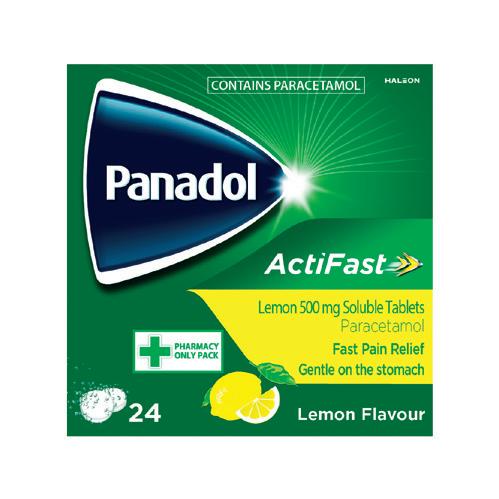
Find out how Panadol Actifast Lemon 500mg Soluble Tablets can help your patients
Product Information:
Please consult the summary of product characteristics for full product information.





Panadol Actifast Lemon 500 mg Soluble Tablets (paracetamol) Indications: Short-term management of symptoms of headaches, musculoskeletal disorders, menstrual pain, toothache, colds and flu, as well as symptomatic relief of mild to moderate pain associated with doctor-diagnosed osteoarthritis. Dosage: Adults (including the elderly) and children 16 years and over: 1-2 tablets up to 4 times daily, as required. Children aged 10-15 years: 1 tablet up to 4 times daily, as required. Max 4 doses in 24 hours. Do not give to children for more than 3 days without consulting a doctor. Do not give to children under 10 years. Minimum dosing interval: 4 hours. Contraindications: Hypersensitivity to paracetamol or any of the other ingredients. Precautions: Do not use with any other paracetamol-containing products. Use with caution in patients with glutathione depleted states, those with risk factors for hepatotoxicity (see SPC for list). Caution, due to paracetamol, if administered with flucloxacillin due to increased risk of high anion gap metabolic acidosis. Contains: 427 mg sodium per tablet, use with caution in those on a low sodium diet. 50 mg sorbitol per tablet Patients with hereditary fructose intolerance should not take this medicinal product. Side e ects: All very rare: Thrombocytopaenia, hypersensitivity reactions including anaphylaxis, skin rash, angioedema, Stevens-Johnson syndrome, Toxic Epidermal Necrolysis, serious skin reactions, bronchospasm, hepatic dysfunction. MA Holder: Haleon Ireland Limited, 12 Riverwalk, CityWest Business Campus, Dublin 24. MA Number: PA 678/39/17. Legal Category: Pharmacy Only. Text revised: January 2024. Further information available on request. Contains Paracetamol. Always read the label/leaflet.
Trade marks are owned by or licensed to the Haleon group of companies. PM-IE-PAN-24-00008


 Paracetamol
Paracetamol
Page 5: Introduction of Pharmacist Prescribing moves step closer
Page 6: Medicines for Ireland publish five-year vision
Page 8: Almost 900,000 illegal medicines detained says HPRA
Page 10: Promising news in Multiple Myeloma treatment
Page 12: New ¤3m Warehouse Facility for Clonmel Healthcare
Page 14: PHX Ireland demonstrates commitment to female growth
Page 18: Management of Ovarian Cancer
Foreword

In one of our lead news stories this month, we detail how the Minister for Health Stephen Donnelly has received government approval to proceed with the drafting of a further amendment to the Health (Miscellaneous Provisions) Bill 2024. This amendment will lay the groundwork for the introduction of pharmacist prescribing. This amendment will make provision in primary legislation for the further expansion of the role of pharmacists.
The news was welcomed by both the Pharmaceutical Society of Ireland and the Irish Pharmacy Union.
Under the amendment proposed by Health Minister, Stephen Donnelly TD, patients will soon be able to access certain medications directly from their pharmacy without the need for a GP visit for a prescription. This should facilitate pharmacists supplying the contraceptive pill through a structured consultation. In addition, to combat the growing problem of medicine shortages, pharmacists will be permitted to substitute medicines that are therapeutic equivalents when a prescribed medication is unavailable.

Page 58: Irish Pharmacy Awards 2024 –The Finalists
PUBLISHER:
IPN Communications
Ireland Ltd.
Clifton House, Fitzwilliam Street Lower, Dublin 2 00353 (01) 6690562
MANAGING DIRECTOR
Natalie Maginnis n-maginnis@btconnect.com
EDITOR
Kelly Jo Eastwood: 00353 (87)737 6308 kelly-jo@ipn.ie
ADVERTISING EXECUTIVE
Esther Elliott-Coulter: 00353 (87) 062 2025 Esther@ipn.ie
EDITORIAL/ EVENTS & MARKETING EXECUTIVE
Aoife Hunter: aoife@ipn.ie
CONTRIBUTORS
Jayne O’Toole
Dr Catherine McGorrian
Dr Nicola Cochrane
Colm Moore
Dr Karl Kavanagh
Diarmaid Semple
Professor Michael Barrett
Barbara Paldus

Pharmacists are in discussions with the Department of Health to ensure that all the correct enablers are in place to facilitate these services for patients. The IPU is confident agreement can be reached on these critical enablers so that enhanced patient care and accessibility can be realised and pressure can be reduced across our healthcare services.
Tom Murray, incoming IPU President, said, “Community pharmacists stand as the most readily accessible clinicians within a person's healthcare team. Their potential to prescribe directly is eagerly anticipated and will directly benefit patient outcomes. Successful delivery of this role requires pharmacists to be enabled and resourced correctly, community pharmacists are collaborating with Department of Health officials to ensure a successful outcome for patients and the healthcare system.”
Orla Cooney | Dr Cathal O’Connor
Gillian McConnell | Gráinne Henry
Bernie Carter | Deirdre O’Reilly
DESIGN DIRECTOR
Ian Stoddart Design











Irish Pharmacy News is circulated to all independent, multiple Pharmacists and academics in Ireland. All rights reserved by Irish Pharmacy News. All material published in Irish Pharmacy News is copyright and no part of this magazine may be reproduced, stored in a retrieval system or transmitted in any form without written permission. IPN Communications Ltd. has taken every care in compiling the magazine to ensure that it is correct at the time of going to press, however the publishers assume no responsibility for any effects from omissions or errors.
Also in this issue, we detail the Finalists for the 2024 Irish Pharmacy Awards. This year has completely surpassed all previous years in terms of the number of entries received. Feedback from our esteemed judging panel has also demonstrated what a difficult task they faced in shortlisting and selecting the winners. These Awards truly display the enormous amount of ongoing dedication, excellence and service provision being carried out amongst Ireland’s community pharmacy sector.
The Irish Pharmacy Awards take place on Saturday, May 25th and we look forward to seeing you all there. Make sure to watch out for the June issue, which will carry all the details of the night and the winners!
Regulars
FEATURE: ACUTE PAEDIATRIC FEVER P28
CPD: MANAGEMENT OF OSTEOPOROSIS P43
FEATURE: HEALTHY DIET & MENOPAUSE P80 ASK THE EXPERT: DR CORMAC MULLINS P84
CLINICAL PR: P96
3 PHARMACYNEWSIRELAND.COM
6
IRISH PHARMACY NEWS 5 12
PHARMACYNEWSIRELAND.COM @Irish_PharmNews IrishPharmacyNews
58 Awards 2024 The Irish Pharmacy
Contents
IPHA Launches Manifesto
The Irish Pharmaceutical Healthcare Association (IPHA) has recently launched the Midlands-Northwest EU Manifesto head of the upcoming European Parliament Elections.
The Manifesto contains a number of ‘key asks’ including better health for all Europeans, creating jobs that matter, supporting innovation and encouraging the sustainability of the pharmaceutical industry.
It states, “Ireland’s heritage in biopharmaceutical innovation is key to attracting new investments which will spur new medicines research, development and manufacturing, not only here but throughout Europe. A strong EU pharmaceutical industry focusing on innovation is critical to support Europe’s political ambitions to beat cancer, tackling its entire disease pathway; and to tackle other continued public health challenges such as anti-microbial resistance, Alzheimer’s and dementia.
“45,000 people directly work in the pharmaceutical industry in Ireland and 875,000 in Europe. Through their highly skilled work, they help deliver better healthcare outcomes for millions of people throughout the world. Ireland’s development as a pharmaceutical hub is a European and global success story which should be built upon. In every part of Ireland, people are working on this vital European and global success. We need to continue to create more of these high-value jobs in the pharmaceutical sector not just in Ireland but across the EU, building upon the 875,000 jobs already in place. These jobs matter for millions of people around the world, day in, day out.
“Climate change is one of the greatest challenges of our time.
The European Green Deal can create a more resilient, sustainable, and competitive economy that works for people and the planet. The pharmaceutical industry will play its part in achieving these goals and will evolve in the face of changing sustainable practices and environmental impact. Industry is committed to a balanced approach in addressing concerns around risks associated with pharmaceuticals in the environment. We believe that Environmental Risk Assessments (ERAs) are indispensable in assessing the potential environmental risk of pharmaceuticals, and the potential impact of human medicines and their manufacture on the environment.”

Chemist Warehouse opens 10th Pharmacy Store
Congratulations to Supervising Pharmacist Conan French and all the Chemist Warehouse team on the opening of their 10th Store at Cornmarket Centre, Cork City last month.
In February the ninth store opened at Artane Place in Dublin.
Managing Partner Colin Galligan said, “We are thrilled with our third superstore in Cork as we continue to make healthcare more accessible and affordable. We continue to expand our store network throughout 2024 while creating new job opportunities within our retail and pharmacy teams. Our mission to bring affordable healthcare and savings to our customers and patients is only beginning.”
Supervising Pharmacist Conan French and the pharmacy team

National Cancer Strategy
Government failure to adequately fund the National Cancer Strategy is putting lives at risk according to Irish Cancer Society CEO Averil Power.
Speaking at the Joint Oireachtas Committee on Health recently, she said Ireland’s National Cancer Strategy, which was launched in 2017 by thenMinister for Health Simon Harris, has only been fully funded in two of the last seven Budgets. The result is anyone receiving a cancer diagnosis in Ireland today doesn’t have the best possible chance of surviving the disease, or of having a good quality of life afterwards.
Ms Power said, “The Irish Cancer Society was proud to sit on the steering committee that developed the Strategy and expected it to lead to further significant improvements in cancer survival rates here. However, the Government's failure to properly fund the Strategy, and the impact of COVID-19 on cancer diagnosis and treatment, means we are no longer confident that will be the case. In fact, we are concerned that Ireland's cancer outcomes may have stagnated or even disimproved.
“Without funding, the National Cancer Strategy is a plan without action. And a plan without action is not a plan. It is just words. Words are no comfort to someone languishing on a waiting list for a cancer test, getting more worried by the day. Or to the healthcare professional trying to do their best in a chaotic system, knowing their patients aren’t getting the standard of care they deserve.
“Target waiting times for cancer tests are consistently exceeded. Screening has not been expanded as planned. Inequality between public and private patients is also growing, particularly in terms of access to new medicines.
“It is truly shocking that this is being allowed to happen, particularly when we have such strong evidence that investment in cancer services works.”
PHARMACYNEWSIRELAND.COM 4 News
Mental Health Engagement
A new recovery focused approach with peoples’ lived experience and staff expertise at its centre has been launched by the HSE’s National Office of Mental Health Engagement and Recovery (MHER).
The Mental Health Engagement Framework: 2024 – 2028 aims to promote the involvement of staff, people with lived experience, their families, carers and supporters in the continuous improvement of mental health services. The new framework describes the unique need for mental health engagement and invites everybody to become involved in developing mental health services that meet the needs of the people who use them. This will result in better mental health outcomes for people.
Speaking at the launch of the new strategy, Mary Butler, TD, Minister for Mental Health and Older Persons said, “I continue to support the work of the National Office of Mental Health Engagement and Recovery and I am particularly proud to launch this Mental Health Engagement Framework because it speaks to my strong belief in the power of lived experience knowledge, peer support and collaborative working to improve services.”
Dervila Eyres, Assistant National Director, Mental Health Operations, HSE said, “This framework will be used by mental health staff and others to inspire and create more engagement activity. It also offers new opportunities for people with lived experience to become involved in mental health engagement whether it is a one-off event or becoming a member of a regional or national volunteer panel or a local forum.
“Importantly, this framework highlights the value and expertise of lived experience as an equal and essential partner in a recovery-focused mental health service alongside its clinical, social, and community partners. I look forward to seeing this framework implemented in the coming years, in the knowledge of the relationship and trust building it will incur and the evidence it will produce.”
Expanded Pharmacists Role and Prescribing
The Minister for Health Stephen Donnelly has received government approval to proceed with the drafting of a further amendment to the Health (Miscellaneous Provisions) Bill 2024. This amendment will lay the groundwork for the introduction of pharmacist prescribing. This amendment will make provision in primary legislation for the further expansion of the role of pharmacists.
Joanne Kissane, Registrar and Chief Officer of the PSI – The Pharmacy Regulator
The news was welcomed by the Pharmaceutical Society of Ireland who commented, “We welcome the latest announcement by Minister Donnelly TD, one which demonstrates the commitment to ensuring that pharmacists can make an enhanced contribution to the delivery of health care to the benefit of patients and the public as part of the integrated health system envisioned under Sláintecare,” said Joanne Kissane, Registrar and Chief Officer of the PSI – The Pharmacy Regulator.
“This latest development is the first step in a multi-step process, both building on and aligning with the work underway by the Expert Taskforce. It represents an important staging point in the context of progressing the current and future recommendations from the Expert Taskforce and is a significant and positive development overall.
“As the regulatory body charged with protecting the health, safety and wellbeing of patients and the public by regulating pharmacists and pharmacies, the PSI’s focus will remain on

ensuring the necessary training, education, accreditation, and regulatory supports are in place for the profession on its pathway to realising an enhanced role and scope of practice.”
Minister Donnelly said, "I am delighted to have secured government approval to add an amendment to the Health (Miscellaneous Provisions) Bill, which will be introduced at Report Stage. The amendment will be an important first step in introducing pharmacist prescribing and enhancing the contribution that pharmacists make to our health services.
MSc Pharmaceutical Technology & Quality Systems
Pharmaceutical Technology and Quality Systems, University College Cork, is currently accepting applications for the 2024 September intake.
"I look forward to receiving the final report from the Expert Taskforce on Pharmacy soon. This report and this amendment will provide the fundamentals we need in place to move toward pharmacist prescribing.
"There is work to be done before pharmacists can start prescribing, including the implementation of secondary legislation, regulatory changes and the development of training pathways for pharmacists. However, I think it is important to be ambitious and recognise the positives that expanding the role of pharmacists will bring for the pharmacy profession, the broader health service and patients."
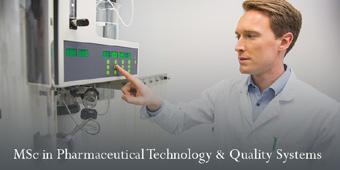
This 2-year part-time blended learning programme is aimed at graduates in the Pharmaceutical Industry who are planning a career as QP in Quality Management. The course is not limited to aspiring QPs: it is designed to broaden your professional development and provide up-to-date assessments of the latest trends in the areas of pharmaceutical/biopharmaceutical development, manufacturing and quality. The individual modules provide knowledge and experience of benefit to all technical, quality, regulatory and managerial staff in the pharmaceutical industry.
This course is accredited by the HPRA fulfilling the educational requirements for QP status (EU Directives 2001/83/EC).
Closing date for applications: Rolling deadline. Open until all places have been filled. Early application is advised.
PHARMACYNEWSIRELAND.COM 5
News
Medicines for Ireland Publish New Vision
Medicines for Ireland (MFI) has published its new five-year vision Looking forward: Building the framework for a sustainable generic, biosimilar and value-added medicines industry in Ireland. The vision sets out MFI’s approach to address current and emerging market challenges, including demographic shifts, access to medicines, and inflationary pressures.
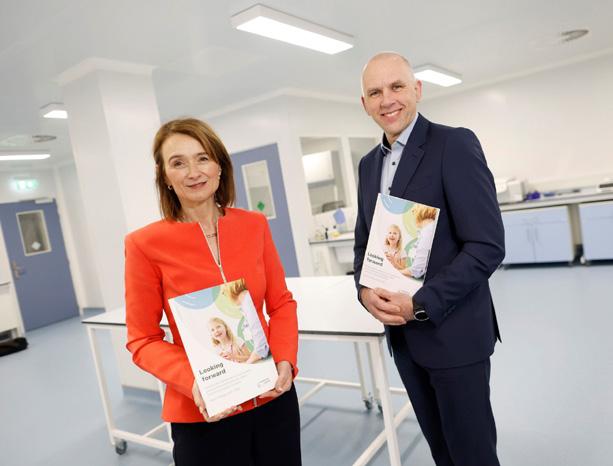
In developing its new Vision Strategy 2024 – 2029, MFI member companies focused on three core strategic pillars:
1. Enhancing patient access and affordability through delivering a coherent framework agreement with the Department of Health and the Health Service Executive which facilitates innovation, patient centricity and value.
2. Securing a resilient and competitive supply chain ecosystem by championing local and European policies that support medication supply in Ireland.
3. Embedding industry sustainability through fostering a balanced approach to environmental practices which don’t overshadow public health benefits and accelerating the adoption of electronic patient information leaflets.
MFI’s overarching objective is to effect real change and reform around how Ireland procures and supplies medicines, expanding patient access to affordable, lifesaving and life-enhancing treatment. Commenting on how the new strategy will allow the industry to deliver on this ambition, Chair of MFI, Paul Neill said: “It’s well documented how Ireland’s healthcare system is facing formidable challenges
underscoring the urgent need for reform to ensure affordability, efficiency and sustainability for patients and the State. In the context of these challenges, the significance of a resilient and sustainable generic, biosimilar and value-added medicines industry cannot be overstated.
“This year, the Department of Health has projected that almost ¤3 billion will be spent on medicines, representing nearly ¤1 in every ¤8 spent by the State on healthcare. Health policy decision makers must recognise how increased penetration of generic, biosimilar, and value-added medicines offers significant savings to the State and the opportunity for earlier treatment interventions for more patients. This further expands the opportunity to redirect scarce resources to other areas of the healthcare system. Currently generics account for 58 per cent of all prescribed medicines in Ireland behind the European average of 70%.”
Mr Neill added: “There are several influencing factors causing Ireland to lag our European counterparts when it comes to generic penetration which must be addressed. These include reduced price entry point, downward only pricing structures, and lengthy timelines for price uplifts for unviable products. These factors have an overall impact on the attractiveness of the Irish market
for manufacturers. To fully realise the potential of enhanced patient access and affordability through increased penetration, it is pivotal that we foster a market ecosystem which promotes fair competition and availability of medicines over the next five years.
“From the perspective of our members, key to this must be the delivery of a coherent framework agreement on the supply and pricing of medicines with the Department of Health. To help alleviate some of the pressure points faced by the industry, any new agreement must embrace tiered pricing, de-linkage from the originator price model, and automatic indexation models.
As an industry body, we are committed to championing dynamic policies that support competition through balanced price control measures, aligned with demand side policies which incentivise the use of generic, biosimilar, and value-added medicines which benefit patient access and affordability.”
Pictured at the launch of the Medicines for Ireland (MFI) new five-year Vision Strategy are Chair of MFI, Paul Neill and Vice-Chair of MFI, Deirdre Kelly Looking forward
Established in 2016, MFI is the leading voice for the generic, biosimilar, and value-added medicines industry with its members supplying the majority of medicines to the HSE and patients directly. Generic companies play an essential role in the supply of prescription medicines in Ireland, with eight of the top 10
companies in the total prescription market (based on volume of units) supplying generic medicines. Six of these are MFI members.
Commenting on the roll-out of the association’s five-year strategy, Vice-Chair of MFI, Deirdre Kelly said: “Our members remain steadfast in their focus on ensuring access to essential medicines in Ireland. The commitments and deliverables detailed under the three core strategic pillars in our Vision Strategy present a clear roadmap to drive patient-centric solutions that prioritise value, accessibility, and quality for patients, healthcare providers and the State. In line with the OECD’s recommendations, we are wellpositioned to support and deliver increased use of generic, biosimilar, and value-added medicines.
“Recognising the interconnected nature of healthcare delivery, policy frameworks, and economic considerations, our ambitions will only be achieved through a collective and collaborative partnership approach. Working with industry partners, we will advocate for fair policies that balance value for patients and the State with medication supply viability for the industry. We consider our Vision Strategy as a call to action. By collaborating with stakeholders, policymakers, and healthcare professionals, we can shape a future where patients receive high-quality, affordable medicines in a resilient healthcare ecosystem,” Ms Kelly concluded.



PHARMACYNEWSIRELAND.COM 6
News
Building the framework for a sustainable generic, biosimilar and value added medicines industry in Ireland Vision Strategy 2024 - 2029
Ireland’s newest dispensary system is


DISPENSENSE, MAKING PHARMACY EASIER
Using the latest, cutting-edge technologies to change the way Irish pharmacists dispense to their patients Get in touch by email at hello@dispensense.ie, or by phone at +353 1 4433884 Ext. 2
Ground-breaking industry first
Almost 900,000 Illegal Medicines Detained
The Health Products Regulatory Authority (HPRA) has released its annual enforcement data which shows that it detained 874,945 dosage units* of falsified and other illegal medicines in 2023. Announcing the figures, the HPRA warned of the serious health dangers posed by sourcing prescription medicines online and from unauthorised sources. It states that the supply of these products into and within Ireland is illegal and stresses that consumers can have no guarantees about the safety or quality of prescription medicines they are seeking to buy outside of the regulated pharmacy setting.
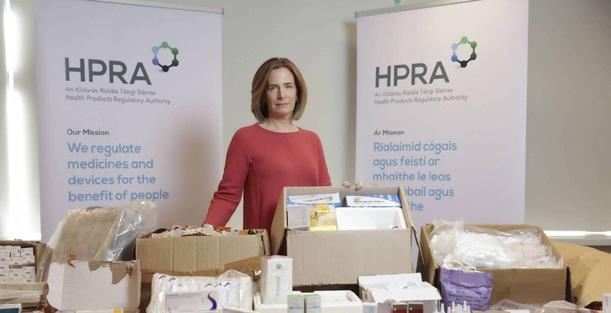
In the 12 months of 2023, the most significant categories of illegal products detained included sedatives (34%), anabolic steroids (29%), erectile dysfunction medicines (10%), analgesics (5%), and Stimulants (3%). The breakdown is as follows:
• Sedative medicines – 294,145 units detained
• Anabolic steroids – 250,922 units detained
• Erectile dysfunction medicines –84,119 units detained
• Analgesic medicines – 42,307 units detained
• Stimulants – 24,530 units detained
The HPRA also continues to monitor online activity promoting prescription medicines and other substances, and routinely intervenes to disrupt this promotion. Such activity is often linked to the use of particular substances for aesthetic and body image purposes.
The following are some of the key enforcement actions taken by the HPRA in 2023:
• Two prosecution cases initiated, relating to the importation or distribution of anabolic steroids.
• 2,348 websites, e-commerce listings and/or social media pages amended or shutdown.
Grainne Power, Director of Compliance with the HPRA, expressed concern that the 2023 data continue to highlight the risks that individuals take when attempting to purchase prescription medicines from unauthorised suppliers.
“While we welcome a slight decrease in overall detentions this year (874,945 units in 2023 compared to 939,388 units in 2022), the data shows a concerning increase in a number of categories. Of particular note, there was a more than 20% increase in the volume of illegal anabolic steroids detained. This is continuing an upward trend observed over several years.
“We believe young men in particular may be sourcing anabolic steroids for body enhancement while being unaware of the serious health complications posed by these products. Anabolic steroids can cause serious physical and psychological health issues. The potential physical side effects alone include heart failure, liver issues, kidney damage, and infertility.
According to Ms Power, there appears to be a willingness among some consumers to take risks in sourcing falsified medicines and unauthorised substances for what would be considered aesthetic and body image purposes.
Grainne Power, Director of Compliance with the HPRA
FIP Impact Database
A new FIP resource for evidencebased advocacy and policy engagement, the FIP Impact Database, is launched today on World Health Day. The database collates, summarises, categorises and provides analyses of FIP outputs that support the federation’s vision and mission. It also includes main areas of work, challenges, opportunities and best practices of FIP member organisations over the past decade related to improving global health through influencing practice.
“Whether for privacy, ease of access, cost, or simply aware that their doctor may not deem it appropriate medical use, many choose to seek out these products online and from other unregulated sources. In addition to anabolic steroids, we are also seeing a concerning upward trend in detentions of Melanotan 2, an unregulated substance promoted as a self-tanning aid, as well as botulinum toxin and online semaglutide and liraglutide products. While overall numbers remain low, as with all illegally supplied products, once consumers step outside of the regulated supply chain, they have absolutely no guarantees as to safety, quality or effectiveness. Some of these substances are not authorised for use by any regulator anywhere in the world while other products that are presented as legitimate medicines, could well be falsified or fake.”
The HPRA will initiate prosecution cases where it considers that there is a significant risk to public health or where there are persistent non-compliances. The HPRA also supports prosecutions brought by the Director of Public Prosecutions in relation to the illegal supply of medicines. Before initiating a prosecution, the HPRA will typically engage with an offender, detain product and may formally caution the individual to ensure any illegal activity is ended. In 2023, 14 voluntary formal cautions were issued.
The resource, hosted by the FIP Global Pharmaceutical Observatory (GPO), is currently in its testing phase. FIP is inviting its members to provide feedback here. “The database will continue to evolve into a sustainable, dynamic resource for policymakers and leaders. I invite you to explore [it] and see for yourself the wealth of information available to you and the pharmacy profession,” said FIP’s GPO director Prof. Ian Bates.
The FIP Impact Database collates, summarises, categorises, and provides access to a complete range of outputs that support the Federation and its members’ vision and mission.
The FIP Impact Database also includes the main work areas, innovations, and best practices of FIP member organisations over the past decade that have contributed to the advancement of pharmaceutical global health through influencing practice, education, and policy.
The target audience includes pharmacists, leaders, policymakers, researchers, and members of FIP.
FIP plans to expand the scope of the database by incorporating a wider range of publications that have impacted global policy formation.
This database is currently in its testing phase, providing an opportunity for members to explore its features and provide feedback. Your insights are important for enhancing its functionality and user experience. Please click here to share your feedback and suggestions for improvement.
For more information please contact: observatory@fip.org
PHARMACYNEWSIRELAND.COM 8 News

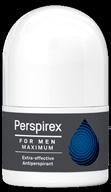
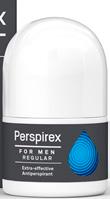

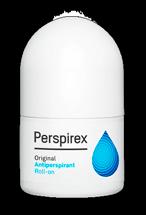
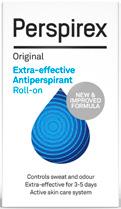
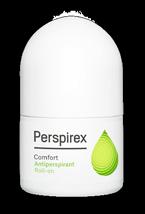

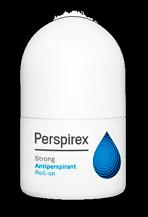
Extra effective sweat and odour protection
Perspirex offers a selection of extra effective antiperspirants specially designed for those who need extra protection against sweat and sweat odour. Our antiperspirants keep you dry and odour-free for up to 5 days.
C LIN I C ALLY PR O V EN
Order Now From Your Sales Representative Or Phone 01 405 0900 / 01 450 7771 Distributed by
Promising News for Multiple Myeloma Treatment
RCSI research has found that venetoclax, a medication currently approved for leukaemia, has benefits for patients with multiple myeloma when used in combination with another drug. This discovery offers a new avenue of treatment options for the currently incurable disease.

In the new study published in Haematologica, researchers at the RCSI Department of Physiology and Medical Physics and the Beaumont RCSI Cancer Centre set out to identify complementary drugs that would enhance the efficiency of venetoclax, a drug approved for use in leukaemia, for MM treatment. Although previously tested in MM,
Prof Siobhán Glavey and Prof Tríona Ní Chonghaile
venetoclax, which blocks the function of a protein called BCL-2, was only found to be effective for a small proportion of patients.
The researchers discovered that combining venetoclax with a drug called 5-azacytidine significantly increased its effectiveness across many MM cell lines, indicating a broader potential patient population that could be treated with the new combination.
“This research is a significant step in identifying more effective treatment options for multiple myeloma. By combining venetoclax and 5-azacytidine we’ve seen enhanced efficacy across a wide range of patient samples. It shows the benefits of
IIOP Mentoring Programme
re-evaluating existing treatments in new contexts to expand their potential.” said Professor Tríona Ní Chonghaile, Associate Professor and research lead, Department of Physiology and Medical Physics.
Professor Siobhán Glavey, Chair, RCSI Department of Pathology and Clinician Scientist, Beaumont RCSI Cancer Centre commented: “Discovering the potential of this new drug combination is a promising development. Our next goal is to test for efficacy and safety for multiple myeloma in a clinical trial setting to bring us closer to offering a new treatment strategy for patients.”
The research was conducted in collaboration with the Department of Haematology, Beaumont Hospital, Dublin; Department of Medical Oncology, Dana-Farber Cancer Institute, Boston; and the Department of Medicine/ Haematology, University of Galway, Galway.
5th IIOP (Irish Institute of Pharmacy) Mentoring Programme for pharmacists, by pharmacists – Applications are now open!
We are delighted to announce that applications for the 5th formal IIOP Mentoring Programme are now OPEN until Sunday 12th May 2024. This evidence based, formal yet flexible programme is for pharmacists by pharmacists. Designed to suit the life of a busy pharmacist, a structure is provided which is flexible and personalised to the mentoring pair. It is tailored for pharmacists working in all practice areas and is the first of its kind offered to pharmacists in Ireland.
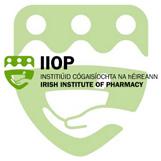
Who can apply? Applications are open to all pharmacists across the profession, at any career stage and in any practice area. This is an opportunity to access to your own personal mentor who is there to support you in your development. Mentee Application: https://iiop.ie/content/iiop-mentoring-programme-applicationform-2024-mentee
The programme will also provide pharmacists who have attended the IIOP Mentoring Skills Workshops, with an opportunity to put their skills into practice.
Applications for mentors are open to all pharmacists who have completed the IIOP Mentorship Skills Training. Have you completed this training and want to put your skills into practice? Would you like to support a fellow pharmacist with their development? Are you looking to develop your mentoring skills further? Mentor Application: https://iiop.ie/content/iiop-mentoring-programme-application-form-2024-mentor
What’s Involved? The programme will run from July to December 2024. We will introduce our mentoring pairs in June when onboarding training will take place for Mentors and Mentees (training takes place online on one evening). This allows you to get set up for success so you can start the mentoring programme formally in July.
The programme is flexible in nature with orientation training and ongoing support provided by the programme team. Pharmacists involved previously fed back that mentoring gave them energy and that they looked forward to the sessions in their week. To give you an idea of how it works, on average, mentoring pairs meet for 60 minutes every 3-4 weeks, outside of work, with time spent on preparation and reflection in addition to this.
To date over 100 pharmacists have participated in the IIOP Mentoring Programme and 100% said it met or exceeded their expectations. Find out more about what mentoring is, how it works and why it matters on the dedicated section of the IIOP website Mentoring Portal. Read about pharmacist Anna Cotter’s experience with mentoring in the February issue of IPN. If you have any questions you can get in touch by emailing mentoring@iiop.ie.
Future Understanding of MS
A team of research scientists at Trinity College have developed a new and unique blood test to measure the immune response to the Epstein Barr Virus (EBV) which is the leading risk factor for developing multiple sclerosis (MS).
MS is a chronic neurological disease with no known cure. It affects approximately three million people worldwide and is the second leading cause of disability in young adults. There is a pressing need for better treatments.
A range of viruses relating to MS have been studied in the past but none have had such compelling evidence as EBV. The question the team considered was why do some people who have known MS have a rogue immune response to EBV, a common viral infection that is generally asymptomatic?
To answer this, scientists measured the cellular response of MS patients to EBNA-1, a part of the EBV that can mimic the myelin coating of nerves which are the principal site of attack of the immune system in MS. The team found that the immune response is higher to EBNA-1 in people with MS compared to those with epilepsy, or the healthy control group. The team also showed that this cellular response is impacted by currently approved medications for MS which target the immune system, but not the virus.
B cell depleting medications are effective for reducing MS disease activity. It is not known however, how exactly they work.
The Trinity researchers are the first team of scientists to capture the immune response to EBNA-1 using whole blood samples carried out exclusively with equipment that is used in the hospital laboratory day to day. This builds on previous research that used extensive pre-processing in research laboratories.
PHARMACYNEWSIRELAND.COM 10 News



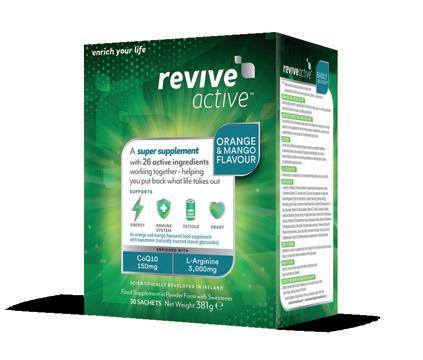
*Source: Euromonitor Passport report on Consumer Health National Statistics. Date: September 2023 Food supplements should not be used as a substitute for a varied diet and healthy lifestyle. THE POWER OF ONE SACHET Super Supplements created using premium ingredients, working in synergy to provide multiple benefits Michelle Higgins, Galway
me, Revive Active is an absolute necessity. I know it works and I find it fantastic for my immunity. My two girls are the same, they take Junior Revive every morning.” � 091 769803 ℓ � customerservice@reviveactive.com or contact your area sales representative
“For
Clonmel Healthcare Completes ¤3m Warehouse Facility
Just last month, in the presence of Mayor of Clonmel Borough District, Cllr Richie Molloy, Clonmel Healthcare, popular consumer health brand, has announced the completion of the construction of a brand new €3 million euro warehouse facility in Clonmel.

The 1650 square metre build, which officially opened its doors today comes after a previous extension of 1,800 square metre in 2017, and will see the increase in production potential of STADA AG pharmaceutical products through this additional distribution capacity for specialised medical products supplied to pharmacists and medical professionals across Ireland.
The construction involved an extensive renovation and extension of a building that was over 50 years old. Previously, the warehouse capacity was 3,500 pallets, yet was responsible for moving 22 million prescription drugs and over the counter products annually - the single largest distribution of pharmaceutical products in Ireland in 2023 by volume.
With the opening of the new, larger facility, located on Waterford Road, Clonmel Healthcare expect to store 6,000 pallets of products at any
one time which is a huge increase on last year, along with ensuring a much more efficient storage and distribution process.
Jim Hanlon, CEO Clonmel Healthcare said of the new warehouse, “The consumer demand for Clonmel Healthcare products has been growing incrementally year on year, so it was time we invested in the re-sizing of our facility, in addition to our commercial office with Sale & Marketing functions in Dublin, in order to meet increased customer demands.”
Mr Hanlon added, “This is a reflection of the drivers of our business over the last number
Pictured L - R: Donagh O’Leary, Barry Fitzpatrick, Cllr. Richie Molloy (Mayor of Clonmel Borough District), Jim Hanlon, Michelle Aylward (CEO Tipperary Chamber of Commerce), Ger Roberts, Kieran Mulhall and Simon McGowan
World Pharmacists Day 2024
“Pharmacists: Meeting global health needs” is to be the theme of World Pharmacists Day on 25 September 2024, the International Pharmaceutical Federation (FIP) has announced.
of years and a project that will provide more growth opportunities in line with our purpose of Caring for Patient’s Health as a Trusted Partner.”
“We are delighted to see this additional investment from Clonmel Healthcare at its HQ in Clonmel. Clonmel Healthcare has been a significant part of our vibrant commercial hub in Clonmel for over 50 years,” commented Mayor, Cllr. Richie Molloy.
The construction was completed by Mulcahy Construction, Clonmel, with the design and project management work carried out by local architect Kenneth Hennessy of Ailtiri Architects. The entire process saw the investment of ¤3 million and took 10 months to complete.
Established in 1970, and with over 50 years’ experience, Clonmel Healthcare now places 22 million packs of medicine into the Irish market every year, making the company one of the top suppliers in Ireland. Clonmel Healthcare launched its biosimilar division in recent years and now offers a comprehensive range of specialty products.
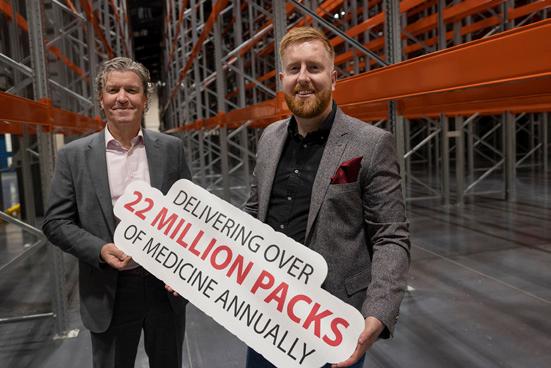
The campaign, led by the federation, is now in its 14th year. “The pharmacy profession has achieved so much in improving health and well-being. FIP’s World Pharmacists Day is an opportunity to celebrate these successes but also to advocate our profession’s value and further potential in meeting health needs and addressing health challenges.
In many and diverse ways, every day the pharmacy profession meets health needs. The FIP World Pharmacists Day campaign is a means for the profession to celebrate and make known the contributions it makes to better health around the world. It is also an opportunity to highlight our further potential in improving global health.
Pharmacists across the world are invited to join FIP in marking World Pharmacists Day, reminding decisionmakers and the public how the role of pharmacists in meeting health needs remains crucial for building healthier communities everywhere.
“FIP’s work is aligned with the UN Sustainable Development Goals, providing key tools such as the FIP Development Goals to support the profession and facilitate progress in all countries and territories so that we can reach our full potential,” said FIP president Paul Sinclair.
World Pharmacists Day marks the anniversary of the inception of FIP in 1912 and was adopted by the FIP Council in 2009. As such, the World Pharmacists Day campaign is led by FIP every year, with the theme chosen by the FIP Bureau.
Any reference to “World Pharmacists Day” or “World Pharmacy Week” should, therefore, include FIP.
As a service to the profession, FIP develops and offers a range of World Pharmacists Day / World Pharmacy Week campaign materials for use each year.
PHARMACYNEWSIRELAND.COM 12 News
Pictured are Kieran Mulhall with Hugh McGovern



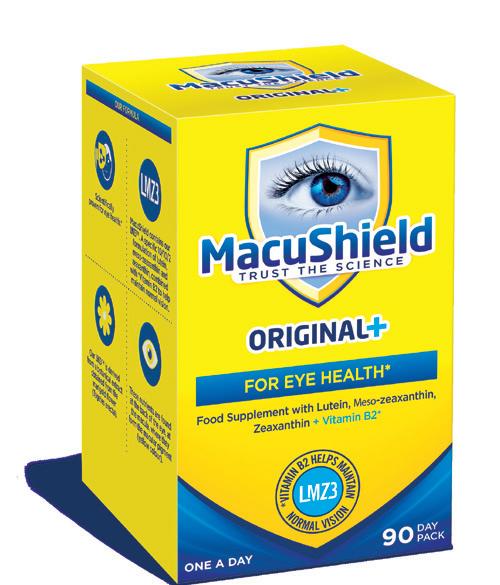
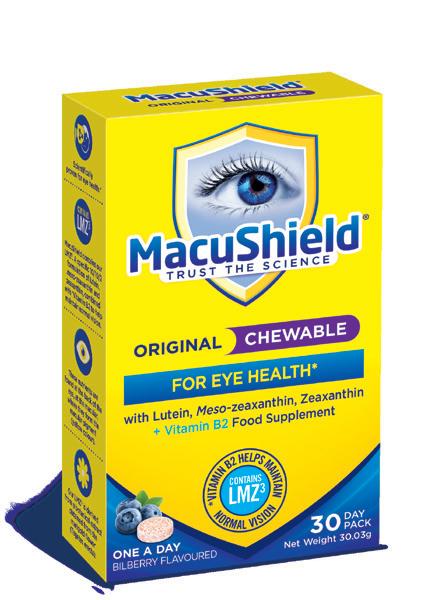

MacuShield Original + and MacuShield Original chewable contain B2 and MacuShield Gold contains zinc, both help to maintain normal vision WITH
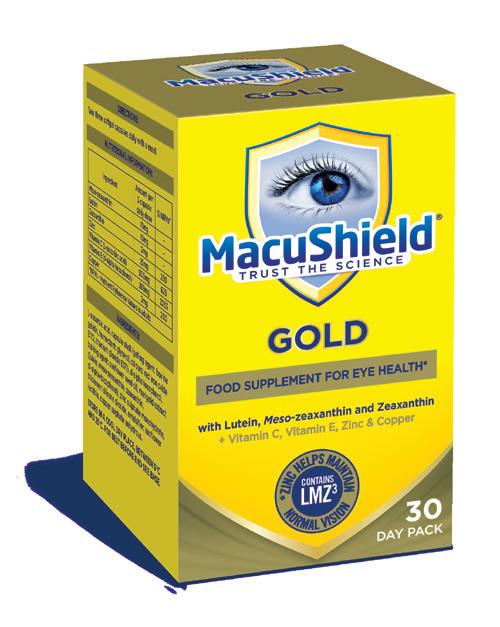
Visit us at macushield.com * Vitamin B2 helps maintain normal vision. DEC 2022 JB-001916
LUTEIN, MESO-ZEAXANTHIN AND ZEAXANTHIN
Empowering Through Mentorship
PHX Ireland's Commitment to Female Growth
Last month marked the commencement of the 2024 Female Mentorship Programme at PHX Ireland, heralding a significant milestone in the ongoing commitment to fostering gender diversity and empowerment within the organisation. Following the successful pilot programme in 2023, the company is delighted to increase the intake of mentees this year, ensuring that every individual who applied was given the opportunity to participate.

Employees across the Businesses were invited to take part either as mentees or mentors. After a period of review, Mentees were assigned Mentors based on suitability including experience and knowledge, to help provide the best possible outcomes for all involved.
The Female Mentorship programme runs for 6 months and allows mentees to identify areas of professional growth and put a plan in place with the support of their mentor to achieve their set goals. The mentorship programme offers colleagues a great opportunity to step out of the day to day and work on developing themselves in a supportive environment.
The programme aims to support women across the PHX Ireland network by partnering mentees with a senior leader, or mentor within the business. Individual training sessions took place for mentors, facilitated by Darina Mulligan of Camino Coaching, which not only set the tone for the year ahead but also fostered a supportive community where mentors could connect, exchange knowledge, and draw from their collective experiences to enrich the mentorship journey.
Mentors and mentees took part in Insights Discovery to assist with the personal growth journey. At
the core of Insights Discovery lies a powerful methodology aimed at enhancing self-awareness, understanding interpersonal dynamics, and leveraging individual strengths to maximise team effectiveness. Through a simple four-colour model, participants gain invaluable insights into their own behavioural preferences, enabling them to navigate professional relationships with clarity and confidence.
At its essence, the Female Mentorship Programme embodies PHX Ireland's steadfast commitment to nurturing the talents and ambitions of female colleagues at every level of the organisation. By providing a platform for women to find their voices, bolster their confidence, and chart their paths to success, the company not only empower individuals but also cultivate a culture of inclusivity and support that benefits the entire organisation.
Speaking about the programme, Hillary Collins, People & Culture Director said: “Launching this programme in 2023 was my personal highlight for the year,

800,000 Kick the Habit
It has been 20 years since the government introduced the Public Health (Tobacco) Act banning smoking in all workplaces, bars and restaurants. 800,000 people have stopped smoking in that time, saving countless lives in the process.
Hillary Collins, People & Culture Director, with participants from the 2023 Programme
and I am thrilled to be able to run it again in 2024. The feedback we got from last year’s mentees was phenomenal and really useful in terms of helping us improve the programme for this year. It’s amazing to see the excitement from both mentees and mentors as we start this journey, and I am excited to see all the amazing things these women do going forward.”
PHX Ireland Group Limited, is Ireland’s leading fully integrated healthcare provider. PHX Ireland Group Limited comprises United Drug, Ireland’s leading pharmaceutical distributor; LloydsPharmacy Ireland, a major community pharmacy chain; and TCP Homecare, innovators in clinical home nursing services and direct to patient delivery solutions. In Ireland, PHX Ireland employs over 1,800 people, operate 5 distribution centres and 80 Pharmacies.

On 29 March 2004 Ireland became the first country in the world to remove ashtrays from work desks as well as pub and restaurant tables. According to the World Health Organisation (WHO), over one quarter of the world's population - 74 nations - now live in countries with complete smoking bans in indoor public places, workplaces and public transport.
Fines for breaking the smoking ban are set at ¤3,000 and the HSE National Environmental Health Service continues to enforce these measures.
According to Martina Blake, the HSE’s lead for the HSE Health & Wellbeing Tobacco-Free Ireland programme, “Smoking rates have reduced considerably over the last twenty years thanks to this significant piece of tobacco control legislation and other legislative measures. The investment in mass media campaigns, stop smoking services and more recently the introduction of free stop smoking medication are really welcome developments. I am worried however that since COVID we have seen a complete stall and even a slight rise in smoking prevalence therefore new and innovative policies will be required to truly realise the government’s goal of a tobacco free Ireland.
“The HSE Tobacco Free Ireland Programme carried out a public opinion survey to ascertain views on Tobacco Endgame policies in Ireland with majority public support (50% or greater) for the proposed policies. These proposals included the phasing out of tobacco sales to children, reducing nicotine in tobacco to make it less addictive and requiring tobacco companies to pay the state for the health costs due to the harm caused by tobacco products.”
PHARMACYNEWSIRELAND.COM 14 News
Hillary Collins, People & Culture Director welcoming mentees
Grow your business with United Drug Retail Solutions www.udw.ie www.united-drug.com 01 463 2300 wholesale@united-drug.com
full service pharmaceutical partner, getting the right product to the right person at the right time.
Your
Safe & secure sourcing of unlicensed medicines
No. 1 leading provider of Ostomy products & Services
turn, improve
Based Buying
scale
range of
Ensuring a quick and reliable delivery. Ireland’s
Grow your business and in
patient care. Choice
Group Unrivalled
and
product offering. Knowledge Centre
Providing meaningful insights to optimise your business.
All-Island Shift to Innovation
New cross-border report finds common barriers for smaller vendors in healthcare and urges an all-island shift to innovation procurement to enable SMEs and Start-ups to thrive in domestic health tech markets.

Launched last month, the ‘Buying All-Island in Healthcare – North and South’ report publishes the findings and recommendations framework of the All-Island Medtech SMEs (AIMS) initiative, delivered through a 12-month cross-border partnership of Enterprise Ireland and HSE partnership Health Innovation Hub Ireland (HIHI) and Health Innovation Research Alliance Northern Ireland (HIRANI), supported by InterTradeIreland’s Synergy programme. This all-island
NEWS
collaborative initiative with SMEs and healthcare stakeholdershealth sector, health industry, policy, state agency, academia and procurement - identified barriers and experienced by smaller vendors in Irish healthcare and proposed solutions.
The framework focuses on four key areas to deliver systemwide impact that will facilitate the procurement of innovative products across the healthcare sector on the island of Ireland from all vendors, regardless of size –
Dr Siobhan McGrath, Health Innovation Research Alliance Northern Ireland, Eimear Galvin, Health Innovation Hub Ireland, Prof Joann Rhodes Health Innovation Research Alliance Northern Ireland
1. Budget and Mechanisms –create a protected healthcare budget for the procurement of innovation, implement EU approved mechanism
To boost innovation procurement allocate a portion of the public budget, replicating successful European exemplars. Public Procurement of Innovative solutions (PPI) is one mechanism. The public sector uses its purchasing power to act as early adopter of innovative solutions that are not yet available on largescale commercial basis. PPI can target specific healthcare challenges by seeking innovative solutions, and through a testing phase, reduce risks commonly associated with smaller vendors
2. Review and revise procurement thresholds — hardware vs software
Tender requirements often demand high turnovers, a
relic of old hardware focussed companies. This excludes smaller, innovative firms. Unlike hardware, software does not rely on costly supply chains; its main costs are licenses and setup. Software procurement should prioritise features, capabilities, and fit with needs over financial size.
3. Increase use of Dynamic Purchasing Systems (DPS) in healthcare procurement
A DPS is a digital tool allowing qualified suppliers to join anytime to compete for contracts. In contrast to tender frameworks, which usually last four years. DPS increases small businesses access to public contracts, simplifying the process by cutting out repetitive bids.
4. Co-develop and publish education tool for SMEs navigating HSC and HSE Developing an educational tool with HSE procurement for SMEs and start-ups will benefit small entities understanding of a multi-faceted complex process. The online tool will be co-developed, user-friendly, accessible and regularly updated to reflect any changes in regulations or best practice. Currently, there are no Irish innovation procurement policy frameworks driving public buyer engagement with smaller vendors.
Irish Wellness & Recovery Brand Launches in Boots Stores Nationwide
Nuasan, a Galway based, natural body care brand, proudly announces its launch in Boots stores nationwide.
Originally developed with athletes in mind, Nuasan was designed to address the myriad of concerns commonly experienced by this group including body and muscle recovery, joint support, skin issues and foot problems. However, its customer base has expanded far beyond this, now encompassing individuals from all walks of life seeking relief from joint pain, arthritis, menopausal symptoms, sleep issues, and more.
"Our mission at Nuasan is to empower individuals to feel their best from head to toe and our product range has evolved to meet the diverse needs of our growing community," says Dara Scott, Founder and MD at Nuasan. "Whether you're a dedicated athlete or someone managing chronic pain, our formulations contain active and functional natural ingredients like magnesium, arnica, and CBD and are designed to provide targeted relief and promote overall well-being."
Backed by years of research and development, Nuasan offers a comprehensive range of products meticulously formulated to enhance overall wellness. Each Nuasan product contains premium, functional, natural ingredients known for their efficacy and every product is designed to deliver noticeable results and improve quality of life.
For more information, visit nuasan.com or contact info@nuasan.com

PHARMACYNEWSIRELAND.COM 16 News

May Measurement Month
Join Fleming Medical in supporting the Irish Heart Foundation’s National Blood Pressure Awareness Campaign, “Before Damage is Done.”
The “Before Damage is Done” campaign will coincide with May Measurement Month and aims to encourage adults, particularly those over fifty, to get their blood pressure checked in their local pharmacy.
Participating pharmacies will receive branded merchandise, in-store informational resources, and a blood pressure monitoring information session.
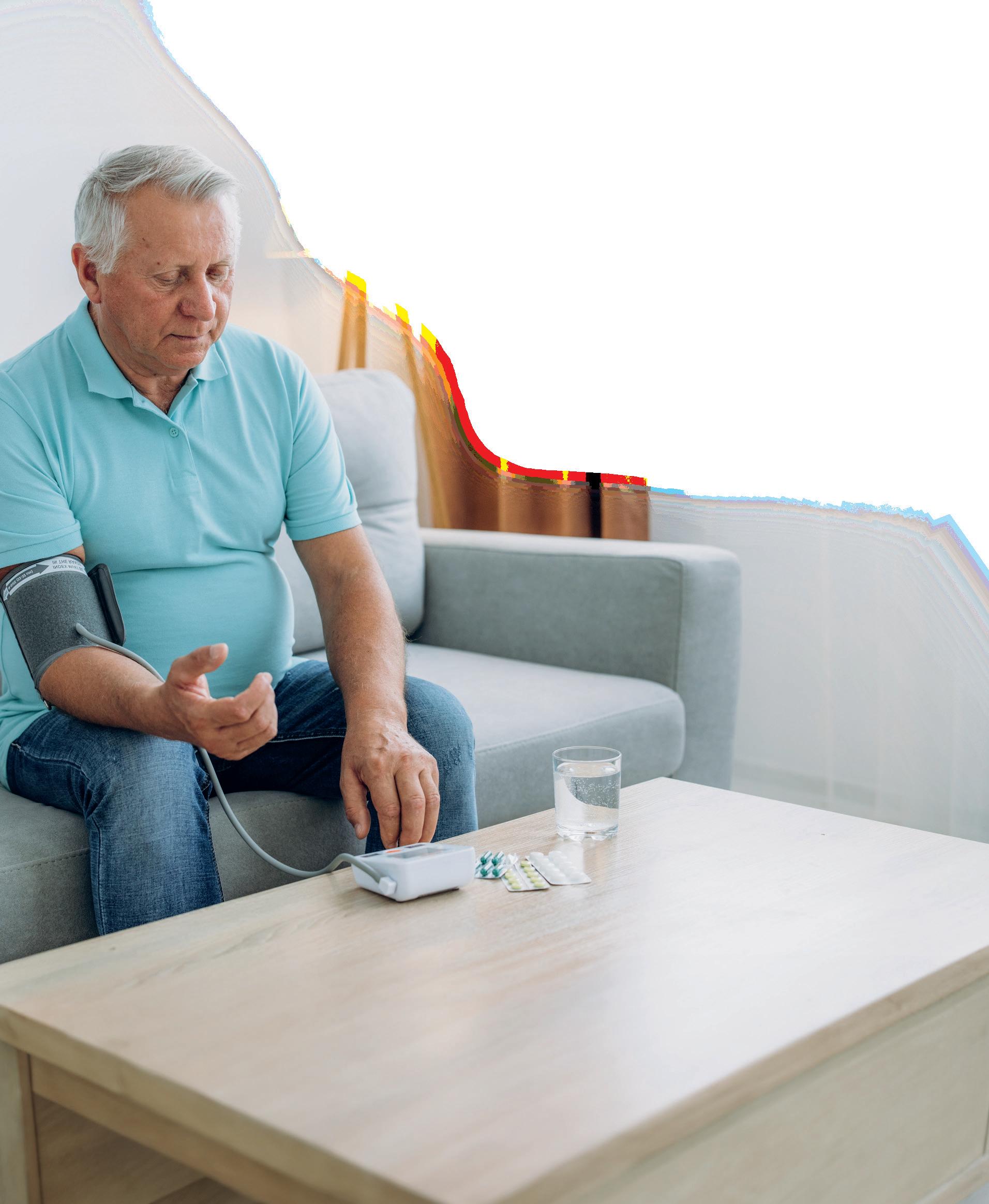
Supported by


Contact your Local Sales Representative for more information about how to be a participating pharmacy for May Measurement Month and get involved in supporting the Irish Heart Foundation.
For further information on this campaign and to view the Medicare LifeSense® Blood Pressure range, simply scan the QR Code above.
FLEMINGMEDICAL.IE Freephone: 1800 307777 Email: pharmacy@flemingmedical.ie @Medicarefirstaid @Medicarefirstaid @Medicare1staid
Ovarian cancer
Management and Treatment of Ovarian cancer
What is ovarian cancer? Ovarian cancer is an umbrella term for a multitude of different types of cancer that affect the ovaries, fallopian tubes, and the primary peritoneal cavity. The peritoneal cavity, also known as the peritoneum, is a thin membrane that lines the abdominal cavity and covers many of the organs inside that cavity.

There are different types of ovarian cancer. The type of ovarian cancer you have depends on the type of cell it starts in.
• Epithelial ovarian cancer is cancer of the surface of the ovary (the epithelium), and is the most common ovarian cancer. Fallopian tube cancer and primary peritoneal cancer are also included in this type of ovarian cancer.
• Germ cell ovarian cancer derives from the reproductive cells of the ovaries. Germ cell ovarian cancer is rare.
• Stromal cells ovarian cancer derives from connective tissue cell. Stromal cells ovarian cancer is also very rare.
• Small cell carcinoma (SCCO) of the ovary is an extremely rare ovarian cancer and it is not certain whether the cells in SCCO are from ovarian epithelial cells, sex-cord stromal cells or germ cells.3
Ovarian cancer in Ireland:
• Ireland has one of the highest rates of ovarian cancer in Europe
• Ireland also has the 2nd lowest survival rates for ovarian cancer out of 24 EU countries
• On average 387 women are diagnosed and 307 women die each year in Ireland from ovarian cancer2
• It is the 6th most common cancer in Irish women after non-melanoma skin cancer and the 4th most common cause of death from cancer
• Poor prognosis cancers have in common vague symptoms, late diagnosis, usually at an
Written by Bernie Carter Assistant Director of Nursing Services at the Marie Keating Foundation
• Smoking - an increase the risk of certain types of ovarian cancer such as mucinous ovarian cancer
• HRT - slight increased risk. Discuss with your G.P.
• Medical conditionendometriosis or diabetes
advanced stage, and a lack of effective treatment options
• Ovarian cancer mainly affects women who have been through the menopause (usually over the age of 50)
• It can also affect younger women
Lack of screening for ovarian cancer:
There is no reliable screening test for ovarian cancer and every person assigned female at birth is at risk. Delays in diagnoses is common due to this lack of screening and also because symptoms of ovarian cancer are often confused with other conditions. Most people are diagnosed once the cancer has already spread, making it more difficult to treat. While every woman is at risk, ovarian cancer is often overlooked and underfunded.3
Risk factors for ovarian cancer:
• Getting older - most cases of ovarian cancer occur between the ages of 50 – 79 but younger people can also get ovarian cancer
• Family history - risk is higher for women with a family history of ovarian, breast, endometrial or colorectal cancer
• Faulty inherited genes - 5 to 15% are caused by inherited faulty genes, such as faults in the BRCA1 & BRCA2 gene and Lynch syndrome
• Ethnicity - women of Ashkenazi Jewish descent are at a higher risk of carrying BRCA1 and BRCA2 mutations and hence have an increased risk of ovarian cancer
• Pregnancy & Breast feedingyour risk is higher if you have not delivered children. A decreased number of ovulatory cycles (for example during pregnancy and lactation) reduces the risk of ovarian cancer
• The contraceptive pill - for every five years it is taken, hormonal contraception is known to reduce the risk of developing ovarian cancer by 20%
• Being overweight or obesehaving excess body fat is linked to an increase in risk of ovarian cancer
Having one or more risk factors does not mean that you will definitely get ovarian cancer.3, 6, 7
Symptoms of ovarian cancer:
Let’s B.E.A.T. Ovarian Cancer:
• Bloating or an increase in the size of your abdomen
• Eating less and feeling full more quickly
• Abdominal and pelvic pain you feel most days
• Talk to your GP about your symptoms
Other possible symptoms may include:
• Needing to pass urine more often
• Tiredness that is unexplained
• Weight loss that is unexplained
• Changes in your bowel habit or symptoms of irritable bowel syndrome, especially if this starts after the age of 50
• Abnormal bleeding – Any post-menopausal bleeding should always be checked by your primary health care provider or doctor3, 4
Diagnosis of ovarian cancer:
As mentioned, there is no routine screening test to diagnose ovarian cancer. A HPV cervical screening test (previously known as the Smear) does not check the ovaries and hence it will not detect ovarian cancer. While cervical screening is effective in early detection of cervical cancer, it is not a test for ovarian cancer.
It is very important to speak to your G.P. if you have any of the symptoms listed and if they persist for more than 3 weeks. Particularly if you have family history of ovarian or breast cancer or if you have a family history of the BRCA gene alteration (BRCA1 or BRCA2)
Your GP may do the following tests:
• Pelvic exam
• Transvaginal or pelvic ultrasound
• CA-125 blood test
Your GP may refer you to a specialist (Gynaecologist) who may request further tests to diagnose or rule out ovarian cancer. Tests that may be done include the following:
• CT scan - several x-rays are taken from different angles to create a detailed image of your ovaries
• Needle biopsy - a needle is passed through your tummy, under anaesthetic, to retrieve a sample of ovary cells or fluid from around the ovaries, so it can be checked for cancer
• Laparoscopy - a small opening is made in your tummy under anaesthetic and a tube with a camera is inserted to look at your ovaries, a small tissue sample may also be removed for testing.
If ovarian cancer is diagnosed, these tests can help check if the cancer has spread.5
Treatment for ovarian cancer:
A multidisciplinary team (MDT) will discuss the best treatment option for each individual
Your treatment depends on several factors:
• Type of ovarian cancer
• Stage of the cancer (Size and Spread)
• Grade of the cancer – tells us how the cancer cells look in comparison to normal healthy cells
• Your general health
The main treatments for ovarian cancer are:
• Surgery
• Chemotherapy
• Radiotherapy
• Targeted Therapies (e.g. PARP inhibitors)
• Clinical trials
• A combination of treatments may be required5, 6
References available on request
PHARMACYNEWSIRELAND.COM 18
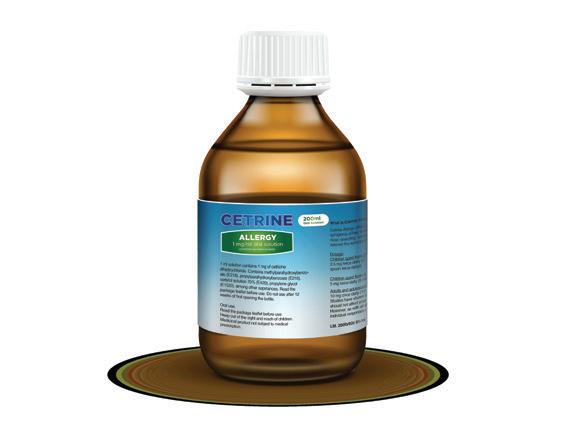

FAST RELIEF OF ALLERGIES 24hr
Cetrine Allergy 10mg Film-Coated Tablets available in packs of 7s and 30s. Always read the leaflet.
ABBREVIATED PRESCRIBING INFORMATION
Product Name: Cetrine Allergy 10mg lm-coated tablets & 1 mg/ml oral solution.
Composition(s): Each tablet contains 10 mg cetirizine dihydrochloride. One ml of the oral solution contains 1 mg cetirizine dihydrochloride. Description(s): White, oblong lm-coated tablets, scored on one side. Can be divided into equal halves. Clear, colourless liquid with banana avour.
Indication(s): Tablets: Adults and paediatric patients 6 years and above. Oral solution: Adults and children 2 years and above. Relief of nasal and ocular symptoms of seasonal and perennial allergic rhinitis (hay fever); relief of symptoms of chronic idiopathic urticaria.

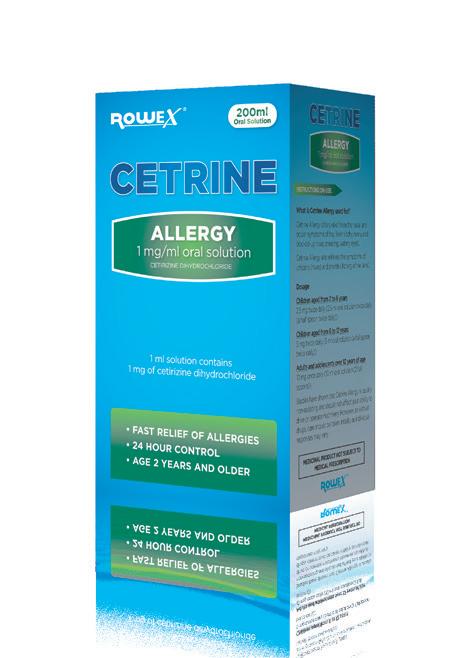
Dosage: Tablets: Adults, elderly and children aged 12 years and over: 10 mg once daily. Children from 6 years to 12 years: 5 mg (half a tablet) twice daily. Moderate renal insu ciency (creatinine clearance CrCl 30-49 ml/min): 5 mg once daily. Severe renal insu ciency (creatinine clearance ≤30 ml/min): 5 mg once every 2 days. Children under 6 years: Not recommended. Oral solution: Children aged from 2 to 6 years: 2.5 mg twice daily (2.5 ml oral solution twice daily (half a measuring spoon twice daily)). Children aged from 6 to 12 years: 5 mg twice daily (5 ml oral solution (a full measuring spoon twice daily)). Adults and adolescents over 12 years of age: 10 mg once daily (10 ml oral solution (2 full measuring spoons)). Not recommended in children aged less than 2 years. Moderate renal insu ciency (creatinine clearance CrCl 30-49 ml/min): 5 mg once daily. Severe renal insu ciency (creatinine clearance ≤30 ml/min): 5 mg once every 2 days. In paediatric patients su ering from renal impairment: Adjust dose on an individual basis taking into account the renal clearance of the patient, his age and his body weight. Contraindications: History of hypersensitivity to the active substance, to any of the excipients, piperazine derivatives or hydroxyzine. Severe renal impairment < 10 ml/min creatinine clearance.
Warnings and Precautions for Use: Cetirizine may increase risk of urinary retention, therefore caution in patients with predisposition factors of urinary retention (e.g. spinal cord lesion, prostatic hyperplasia). Caution in epileptic patients and patients at risk of convulsions. Discontinue use of cetirizine three days before allergy testing. Pruritis and/or urticaria may occur when cetirizine is stopped, even if the symptoms were not present before treatment initiation. In some cases, the symptoms may be intense and may require treatment to be restarted. The symptoms should resolve when the treatment is restarted. Tablets contain lactose. Oral solution contains sorbitol, propylene glycol, sodium (essentially ‘sodium free’), methyl - & propyl-parahydroxybenzoate.
Interactions: Caution is advised when taken concomitantly with alcohol or other CNS depressants. Cetirizine does not potentiate the e ect of alcohol (0.5 g/l blood levels). The extent of absorption of cetirizine is not reduced with food, although the rate of absorption is decreased.
Pregnancy and Lactation: Caution during pregnancy and breast-feeding.
Ability to Drive and Use Machinery: Usually non-sedative, patients should take their response to the product into account. In sensitive patients, concurrent use with alcohol or other CNS depressants may cause additional reductions in alertness and impairment of performance.
Undesirable E ects: Cetirizine at the recommended dosage has minor adverse e ects on the CNS, including somnolence, fatigue, dizziness and headache. In some cases, paradoxical CNS stimulation has been reported. Although cetirizine is a selective antagonist of peripheral H1-receptors and is relatively free of anticholinergic activity, isolated cases of micturition di culty, eye accommodation disorders and dry mouth have been reported. Instances of abnormal hepatic function with elevated hepatic enzymes accompanied by elevated bilirubin have been reported which resolves on discontinuation of the drug. Uncommon: Agitation, diarrhoea, pruritus, rash, asthenia, malaise, paraesthesia. See SPC for all adverse reactions.
Marketing Authorisation Holder: Rowex Ltd, Bantry, Co. Cork.
Marketing Authorisation Number: PA0711/075/002-003. Further information and SPC are available from: Rowex Ltd., Bantry, Co. Cork. Freephone: 1800 304 400 Fax: 027 50417 E-mail: rowex@rowa-pharma.ie
Legal Category: Not subject to medical prescription.
Date of Preparation: March 2021


Adverse events should be reported. Reporting forms and information can be found on the HPRA website (www.hpra.ie) or by emailing Rowex pv@rowa-pharma.ie
Date of preparation: (04-22) CCF: 24955 Supply status: Supply through pharmacies only.
“Silent crisis” of Vitamins and Minerals Deficiency, Experts Warn
MN deficiency prevalence, its underlying causes and possible solutions.
In recognition of the severity of the problem, a project led by Prof Cashman and Prof Kiely of UCC’s Cork Centre of Vitamin D and Nutrition Research at the School of Food and Nutritional Sciences has just been awarded over ¤10m in funding to both assess the cost and scale of the MN deficiency issue, and to develop solutions. Aligned to the UCC Futures thematic arwea of Food, Microbiome and Health, the project will build on UCC’s long standing reputation for research excellence across food, food business, and medicine.
Power from UCC Academy will provide project management support to the consortium. Recognising the urgency of this public health issue, the Zero_ HiddenHunger_EU project is set to revolutionize our understanding and response to MN deficiencies.
Zero_HiddenHunger_EU aims to fill this critical gap by pursuing two primary objectives:
the project seeks to develop context-specific, food-focused strategies to ensure adequate MN intake from sustainable sources. The consortium aims to deliver tailored solutions that address the root causes of MN deficiencies across Europe.
Europe is facing a nutrient deficiency that will impact children’s development and curtail healthy aging among older adults, experts have warned. Prof Kevin Cashman and Prof Mairead Kiely of University College Cork have cautioned that the general population is facing a Micronutrient (MN) Deficiency crisis – but that the scale of the problem is yet unknown. MN deficiency arises from inadequate intake or absorption of essential minerals and vitamins, which affects healthy growth and development in children and impacts on healthy aging among older adults. Affecting most population groups, the scale of the problem, its effects on health and the costs it incurs to the health sector and to economic development, are unknown. It is feared this issue particularly affects groups including children, adolescents, pregnant women, older adults, migrant communities, and those affected by social inequalities. Because it is likely to be highly prevalent, addressing the issue of micronutrient malnutrition requires comprehensive data on
The Zero_HiddenHunger_EU Project is a 19-partner consortium which received more than ¤10 million in research funding from Horizon Europe and Associated Partners for groundbreaking research into tackling micronutrient deficiency in Europe over the next four years. Dr Jennifer Browne and Ms. Anna
1. Estimating Prevalence and Health Costs: The project will generate accurate measures of MN deficiency prevalence using priority biomarker and intake data from diverse European populations. By focusing on high-risk groups, such as marginalized communities and vulnerable populations, the project aims to uncover the true extent of the issue and its associated health costs, using health economics analysis led by Drs Brendan McElroy and Lee-Ann Burke at UCC’s Cork University Business School.
2. Developing Tailored Solutions: Armed with robust evidence,
Promise for New Treatments for TB
Mark Sweeney, Horizon Europe National Contact Point, Enterprise Ireland commented, "Micronutrient deficiency is a major global health issue and can have very serious and debilitating consequences, particularly amongst vulnerable groups. The Zero_HiddenHunger_ EU project is an excellent example of Irish researchers competing at the very highest level of European research and winning. The innovative approach of this ¤10m UCC led project has the potential to help understand, prevent, and control micronutrient deficiency and have significant positive impacts in terms of human health. I would like to congratulate Professor Kiely and Professor Kevin Cashman and wish them well for the duration of the project."
Researchers from RCSI University of Medicine and Health Sciences and Trinity College Dublin have investigated the potential for a specific host-directed therapy to stimulate the immune system to eliminate tuberculosis (TB), while minimising harmful inflammation as one way to help bypass antibiotic resistance and complement existing treatments. Their research is recently published in the European Journal of Pharmaceutical Sciences.

TB is the world’s deadliest bacterial disease and most commonly affects the lungs. Recent years have seen an increase in drugresistant TB cases leaving many patients with limited treatment options. The only vaccine – BCG –is relatively ineffective at preventing TB in adults.
The bacteria that cause TB first enter the lungs by inhalation into the alveoli (air sacs). Alveolar epithelial cells line the air sacs serving as a barrier between the
Professor Sally-Ann Cryan, Professor of Drug Delivery and Pharmacoengineering, School of Pharmacy, RCSI
external environment and the underlying lung tissue. TB bacteria can invade alveolar epithelial cells and establish a reservoir, allowing them to multiply rapidly and spread to other areas of the lungs.
RCSI and Trinity researchers previously showed that the vitamin A derivative all-trans-retinoic acid (ATRA) is a promising hostdirected therapy that can stimulate 'professional' immune cells such as macrophages to kill TB. They have tested whether ATRA could have the same effect on infected alveolar epithelial cells. The work was led by Dr Ahmad Bahlool and Professor Sally-Ann Cryan in RCSI, in collaboration with Dr Mary O’Sullivan and Professor Joseph Keane from the TB Immunology Research Group in the Trinity Translational Medicine Institute, St James's Hospital.
Biodegradable nanoparticles
RCSI researchers used a technique called ‘microfluidics’ to manufacture inhalable biodegradable nanoparticles (NPs), containing the vitamin A derivative ATRA, that are small enough to be used in a nebuliser and reach the alveoli in the lung. When tested in the lab in Trinity College the researchers found that NPs containing ATRA, as well as ATRA alone, could enable alveolar epithelial cells to stop the growth of the TB bacteria without having toxic side effects on the cells.
The research shows that despite their susceptibility to TB infection, alveolar epithelial cell defences can be boosted by ATRA to efficiently eliminate the bacteria. The results are promising for future research into ATRA-loaded NP formulations as inhaled host-directed therapies for TB.
Professor Sally-Ann Cryan, Professor of Drug Delivery and Pharmacoengineering, School of Pharmacy and Biomolecular
Sciences, RCSI, said: “This work involved close collaboration between pharmaceutical, clinical and industrial research groups to produce a novel, inhalable nanomedicine that can be easily scaled up for further pre-clinical and clinical testing as an inhaled therapy for tuberculosis.”
Professor Joe Keane, Clinical Medicine, Trinity College Dublin and St James’s Hospital Dublin, said: “This exciting new data contributes a new paradigm of how the body fights tuberculosis. Lung airway cells can now be transformed into potent killers of the tuberculosis bacteria.”
This work was funded by grants from the Royal City of Dublin Hospital Trust and the Health Research Board (HRB), the Strategic Academic Recruitment (StAR) international PhD programme at RCSI University of Medicine and Health Sciences, and an Aerosol Society Drug Delivery to the Lung (DDL) career development grant.
PHARMACYNEWSIRELAND.COM 20 News
The end of erectile problems? Touch wood.

Sidena. Your new firm favourite.
Sidena 50mg Tablets are now available over the counter in a 4 and 8 pack.
ABBREVIATED PRESCRIBING INFORMATION
Product Name: Sidena 50 mg Tablets.
Composition: Each tablet contains, 50 mg sildena l (as citrate) .
Description: Light blue, round, slightly dotted tablets. Cross breaking notch on one side and marked ‘50’ on the other side. Can be divided into equal quarters. (Only two quarters of the 50 mg is covered by posology).
Indication(s): Treatment of men with erectile dysfunction, which is the inability to achieve or maintain a penile erection su cient for satisfactory sexual performance.
Dosage: Adults and elderly: 50 mg taken as needed approximately one hour before sexual activity. Dose may be decreased to 25 mg. Max dose: 50mg once daily. Impaired renal and hepatic function: Sildena l clearance is reduced in hepatic and severe renal impairment. Consider a dose of 25 mg. Dose may be increased step-wise to 50 mg if tolerated. Children and adolescents below 18 years of age: Contraindicated. Use in patients using other medicines: Starting dose of 25 mg with CYP3A4 inhibitors (not advised to use with ritonavir). To minimise postural hypotension in patients receiving and alpha-blocker, stabilise patient rst on the alpha blocker and use a starting dose of 25 mg sildena l. Contraindications: Hypersensitivity to sildena l or any of the excipients. Concomitant with ritonavir, nitric oxide donors or nitrates in any form, guanylate cyclase stimulators e.g. riociguat. In patients that sexual activity is inadvisable (e.g. severe cardiovascular disorders such as a recent (6 months) acute myocardial infarction (AMI) or stroke, unstable angina or severe cardiac failure). Refer these patients to a doctor. Patients with loss of vision in one eye due to NAION. Known hereditary degenerative retinal disorders. Severe hepatic impairment. Hypotension. Anatomical deformation of the penis. Women. Not intended if no erectile dysfunction. Warnings and Precautions for Use: First diagnose erectile dysfunction and determine potential underlying causes (e.g. hypertension, diabetes mellitus, hypercholesterolaemia or cardiovascular disease), before considering pharmacological treatment. Consider the cardiovascular status of patients, since there is a degree of cardiac risk associated with sexual activity. Serious cardiovascular events, including myocardial infarction, unstable angina, sudden cardiac death, ventricular arrhythmia, cerebrovascular haemorrhage, transient ischaemic attack, hypertension and hypotension have been reported post-marketing in temporal association with the use of sildena l. Most, but not all, of these patients had pre-existing cardiovascular risk factors. Sildena l has vasodilator properties, resulting in mild and transient decreases in blood pressure. Caution: Patients with anatomical deformation of the penis (such as angulation, cavernosal brosis or Peyronie’s disease), or in patients who have conditions which may predispose them to priapism (such as sickle cell anaemia, multiple myeloma or leukaemia). Advise patients that in case of priapism, prolonged erections (longer than 4 hours) or sudden visual defect, they should stop taking sildena l and consult a physician immediately. Administer to patients with bleeding disorders or active peptic ulceration only after careful bene t-risk assessment, as there is no safety information available. Interactions: Inhibitors of the cytochrome P450 (CYP) isoforms 3A4 (major route) and 2C9 (minor route) isoenzymes such as CYP3A4 inhibitors: Itraconazole, ketoconazole, erythromycin, cimetidine, HIV protease inhibitor saquinavir: May reduce sildena l clearance and increase sildena l plasma levels. Consider a starting dose of 25 mg. Strong CYP3A4 inducers e.g. rifampicin may increase sildena l clearance and decrease sildena l plasma concentrations. Grapefruit juice: May give rise to modest increases in plasma levels of sildena l. Nicorandil (Hybrid of potassium channel activator and nitrate): Due to the nitrate component it has the potential to have serious interaction with sildena l. Sildena l potentiates the hypotensive e ect of nitrates. Alpha blocker: Concomitant administration of sildena l may lead to symptomatic hypotension in a few susceptible individuals. Patients should be hemodynamically stable on alpha-blocker therapy prior to initiating sildena l treatment. Sildena l potentiates the antiaggregatory e ect of sodium nitroprusside in vitro. Not recommended in patients with a history of bleeding disorders or active peptic ulceration. Not recommended to use with other pulmonary arterial hypertension treatment containing sildena l. Ability to Drive and Use Machinery: Minor in uence, dizziness and altered vision were reported. Patients should be aware of how they react to sildena l before driving or using machinery. Undesirable E ects: Very common: Headache. Common: Dizziness, visual disorders, visual colour distortion, vision blurred, ushing, hot ush, nasal congestion, nausea, dyspepsia. See SPC for more adverse e ects.
Marketing Authorisation Holder: Rowex Ltd, Bantry, Co. Cork. Marketing Authorisation Number: PA 0711/170/002. Further information and SPC are available from: Rowex Ltd., Bantry, Co. Cork. Freephone: 1800 304 400 Fax: 027 50417
E-mail: rowex@rowa-pharma.ie
Legal Category: Not subject to medical prescription. Date of Preparation: Aug 2022
Adverse events should be reported. Reporting forms and information can be found on the HPRA website (www.hpra.ie) or by emailing Rowex pv@rowa-pharma.ie
Date of preparation: (10-22) CCF: 25156 Supply status: Supply through pharmacies only.
Shining a Spotlight on Women and CVD
In support of International Women’s Day 2024, THE National Institute for Prevention and Cardiovascular Health (NIPC) hosted a NIPC Series webinar Women and CVD Matters! on Tuesday 5th March.

A panel of experts came together to share their insights on key challenges specific to women’s heart health. Women face many unique health challenges throughout their lives and this webinar explored cardiovascular disease (CVD) risk factors and menopause, lipid management, important messages for CVD prevention and control, and the lived experience of SCAD.
Topics included:
• Spotlight on Sex-Specific Risk Factors
• Peri-Menopause, Menopause, HRT and CVD – Your Top Questions Answered
• Is Lipid Management Important in Women and if So When, in Whom and How Best?
• What are the most Important Messages for Women in CVD Prevention and Control?
• Spontaneous Coronary Artery Dissection – What Every Practitioner Should Know?
Below and over the next few pages, we give an overview of some of the keynote talks and
interviews which were carried out with Dr Jenni jones, Director of Training and Education for the NIPC.
Dr Jenni Jones speaking Dr Nicola Cochrane, GP & Menopause Specialist, Carrig Clinic and National Maternity Hospital
Should HRT be advocated and if so, when? Is it something we should be actively promoting?
The logic would be the HRT is advocated for women who are experiencing distressing symptoms of menopause. That can be before menopause. Women
in perimenopause have often developed so many symptoms that their quality of life is very much obliterated and at that point it is logical to start HRT even though they’re still having periods. Their periods may be irregular, but they would gain a lot of benefit from starting it when they discover they have symptoms. Most women will ask their doctor.
From the point of view of whether it is suitable for everyone, there are only a very small number of women where we would have some considerable caution about giving it. It is very much the women where they’ve perhaps already had a diagnosis of a hormone receptor cancer, where their oncologist would be concerned that using extra estrogen might reignite that cancer process.
For heart disease, there has been studies and evidence and the information we have now is incredibly encouraging and reassuring.
When or if you have a female in the CCU, with acute coronary syndrome and has been on HRT, should they continue with HRT?
Absolutely, to be honest a woman experiencing a devastating health event such as a heart attack who’s in a coronary care unit, which is a terrifying place to be – the last thing you want to do is take

PHARMACYNEWSIRELAND.COM 22 CVD Webinar












her estrogen away from her and be suddenly thrown into menopause symptoms.
In the middle of that is creating emotional and physical stress on your body. Its achieving absolutely no benefit as far as health protection and you could argue that its nearly exposing you to increased risk of further cardiac events. So the logic would be that is they’re on it, let them stay on it. We often meet women who present when they develop really troublesome menopause symptoms, and they already got a diagnosis of heart disease. They have had a previous heart attack; they’ve got coronary artery disease and they’re on treatment from a specialist and they are concerned about where its safe for them to take HRT. After many studies, over many years, it is entirely safe for women who have already got heart disease to take HRT. The benefit and the logic would be to start your HRT when your menopause starts or within 10 years of when your menopause starts. So if its actually much later, if you were then into your sixties and you hadn’t started it before, we would have concerns. You wouldn’t say it is impossible, but you would have concerns that is might then offer some risks.
Is there a best form of HRT?
When we think about heart disease, in parallel with that, the concern would be around risk of blood clots. When we prescribe PHRT, currently we will tend to ask women to use a transdermal product that’s with a patch, gel or spray gel because we have overwhelming evidence now to probe that those are very, very safe and there is no increased risk of blood clot with those
products. But a tablet of estrogen can slightly increase your risk of blood clots and particularly in any women with a heart condition or blood pressure, they would be at a little bit more risk from blood clots. We would prefer to have them on a transdermal product.
There has been some negative publicity around estrogen, could you talk us through your views on that?
The big study that people would have been first aware of it, was when the American studies from the Women’s Health Institute were published in 2001. This raised overwhelming concern about risk of stroke, heart attack with HRT. But that study was doing using tablet-based HRT and they were offering the medication to women in their sixties. They were working at the beginning with the idea that it was already well recognised that HRT was beneficial to women at normal menopause age. So maybe, it could also be beneficial to older women and the obvious result was no. It can actually be quite dangerous to suddenly introduce a very high done of estrogen to someone in their sixties who’s never used HRT. But we didn’t see what might have happened in that age group if they used a lower dose patch. That study was subsequently done with some of the early estrogen studies done in the UK and in France and Denmark. So we have good data on that now, and it clarified the difference between tablets and patches or gels.
People with familial hypercholesterolemia – perhaps HRT is considered carefully in this group. Any comments on that?
That brings us into a discussion on the imminent new guidelines
from NICE on menopause care, particularly om cardiovascular. They published their draft evidence already and they’re not going to look at new evidence. They have already offered their conclusions on the evidence that they have and said in all cardiovascular disease, that includes families with hypercholesterolemia, that is no recognized from the evidence to date, that it is safe for them to use. But the proviso would probably be that under specialist input from a menopause specialist or GP who has expertise in menopause, know how to prescribe safely, particularly to give them a transdermal estrogen rather than a tablet. Its very good news to see that NICE have concluded that they’re satisfied that transdermal HRT is safe for heart disease and I think it is going to be welcomed by most of those groups who are experiencing conditions like familial hypercholesterolemia, premature heart disease. Are there any new messages from NICE that we haven’t touched on yet?
So some of their guidance extended as well to stroke and they came out with the really clear message that timing is really important, that using transdermal estrogen under the age of 60 or within 10 years of menopause was safe. But that you could see an increased risk of stroke in people who were given HRT over 60, and a really important group to consider carefully when prescribing were women with black ethnicity. We know that quite a lot of women with black ethnicity have hypertensive heart disease and have preexisting heart disease by their genetic dispositions. So they are more vulnerable to complications and certainly you would prefer to give them a transdermal estrogen and not a tablet.
What about Progesterone? How does that fit?
They're only relatively recently starting to look at what role progesterone plays in, risk and safety with HRT, are preferred at the moment from the knowledge we have based on research is to use a micronized progesterone, and that is sometimes referred to in women, might be familiar with the term a body similar because it's the most closely, connected to natural progesterone. The reason that we usually prescribe that as a first line, and that would be EU progestin or Avastin, which is droge, is because it has a very good record of breast safety and it has a lower side effect profile than
some of the other progesterones that sometimes give people almost a feeling of premenstrual, irritability, puffiness, bloating. They just really don't feel good on some of them. Whereas we don't tend to run into that quite so much with micronized. And there's one honourable exception, which we don't yet have licensed in Ireland, but it is available in the uk. Sperone is a tablet based, progesterone, it's a fourth generation progesterone. It's based on the diuretic tablet, which what used to be used for high blood pressure spironolactone. So it's very low on progesterone side effects because it actually clears fluid out of your system. So rather than feeling puffy, you feel the opposite. It's very skin friendly for people that are prone to acne. But what the research has also found is that it's very helpful for cholesterol. So it actually lowers cholesterol and that's been welcomed by menopause doctors so that it's now included in British menopause guidance to doctors prescribing because they have sperone only in the UK now it's called Lindy, which is a slightly funny name, but we'll see it in Ireland over the next six to 12 months hopefully. And they're offering it as an adequate progesterone to balance any estrogen, and they said that we're, it's not currently licensed for that usage. There's ample evidence to support the safety of it for that method. So that's a very helpful endorsement, and it will be something that will be very welcome as another option.
Is HRT enough to treat your lipids? Is there a belief that is I take HRT, my lipids will be magically improved?
There's quite divided opinion on that. So we would have very, very optimistic ideas that it stops the clock in that estrogen is very protective to, arteries and the lining of arteries, and it minimizes buildup of cholesterol deposits. We know that from a lot of research. Starting your HRT at menopause, if you were at normal population risk, you could be optimistic that it, it's likely to be somewhat helpful at preserving the integrity of your arteries.
But if you're in a family where other people in the family have suffered heart disease at a much younger age, maybe in their thirties or in their forties, then we know that it's not enough in itself and that you very definitely may need
PHARMACYNEWSIRELAND.COM 24 CVD Webinar
Dr Catherine McGorrian Dr Nicola Cochrane
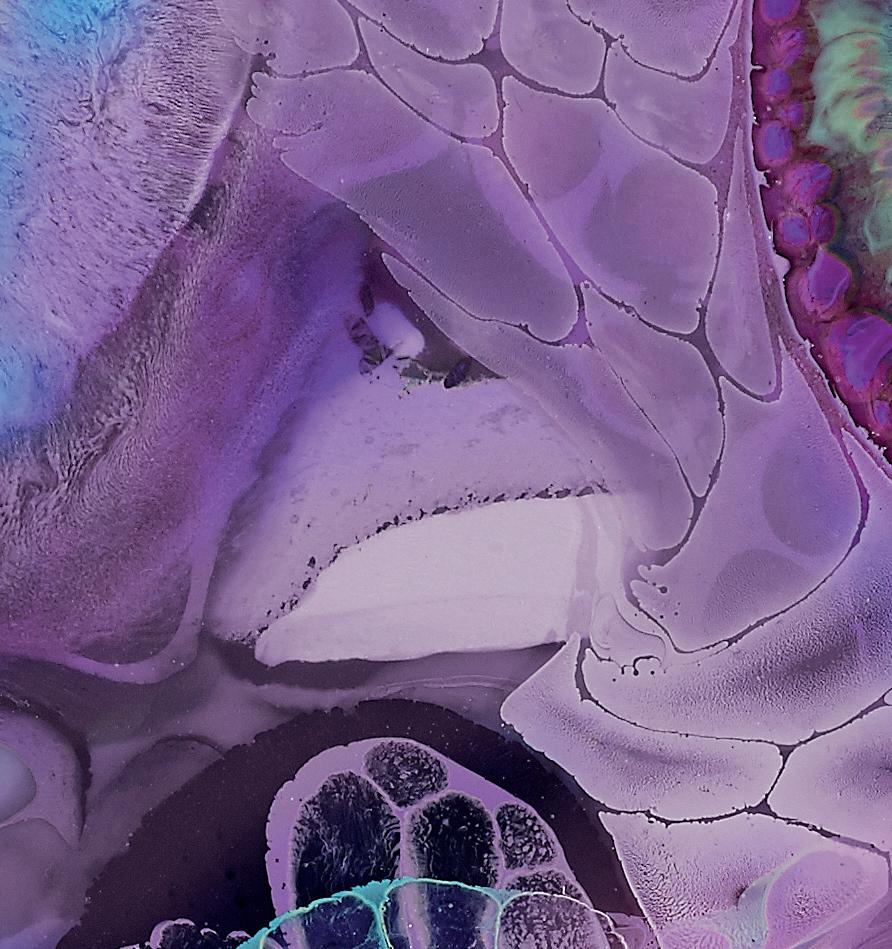










Developed in partnership with leading scientists and clinicians Zenflore combines the unique 1714-Serenitas® culture with selected B vitamins to support mind and body during life’s daily challenges. Distributed by Pamex Ltd Email: info@pamex.ie | Phone: 094 9024000 For Healthcare Professionals only *Pantothenic Acid: Contributes to normal mental performance: Biotin, Folate, Niacin, Thiamine, Vitamin B12, Vitamin B6: Contribute to normal psychological funtion; Folate, Niacin, Pantothenic Acid, Riboflavin, Vitamin B6: Contribute to the reduction of tiredness and fatigue; Biotin, Niacin, Pantothenic Acid, Riboflavin, Thiamine, Vitamin B12, Vitamin B6: Contribute to normal energy yielding metabolism. Zenflore, PrecisionBiotic, 1714 and 1714 - Serenitas are registered trademarks of the PrecisionBiotics Group Ltd. Copyright 2022.
PLACE YOUR ORDER TODAY Scan here for more info NEW look, same great formulation Over 20 years of pioneering research
Zenflore®
to use cholesterol medication or other medication under specialist guidance so that the HRT would be a reasonable parallel, to manage your menopause symptoms, but your heart health might need a little bit more.
Dr Jenni Jones talks to Dr Catherine McGorrian, Consultant Cardiologist, The Mater Misericordiae University Hospital
Managing Lipids – is it going to be different to men or the same as men? Can younger women need lipid lowering? Catherine what are your views in terms of managing lips in women?
We know when it comes to risk factors, so first of all, of course we know cholesterol and LDL cholesterol as a significant risk factor for coronary artery disease, but also cerebral vascular disease, peripheral arterial disease, and atherosclerotic disease in general. When it comes to women's risks, we know that women, have a lower risk profile up to menopause, and then once they reach menopause at the cholesterol, can actually increase at that point. I know we spoke about this, there's some very nice work coming out of Galway, where we see that the average men, average cholesterol for women actually goes a little bit higher than that of the men, around that time of menopause and there on in. But there are situations where lipid profile, can lead treatment at younger ages even before menopause. Nicola already mentioned, for instance, you know, if a person had a particular family history of coronary artery disease, and I can see somebody in the chat has alluded to familial hypercholesterolemia. There are some situations, where a person can, it doesn't matter which sex they are, can have, a very elevated cholesterol during the life course. And exactly as Nicola says, we know that LDL cholesterol is what we call atherogenic, so it predisposes to atherosclerotic plaque. I suppose it can be, we can be more at risk in one of two ways with regards to our cholesterol burden. Either that our absolute cholesterol burden itself is higher, or that we're ex we're exposed to it over a longer period during the life course. So people with familial hypercholesterolemia, which is a genetic condition, they will have a higher cholesterol for a longer period of life and it doesn't matter if you're a man or a woman. So knowing your family history is really helpful there. And then knowing the other cardiac risk
factors as well and how they build into your cholesterol risk.
Am I right in understanding that sort of perimenopause menopause, the time when we have these significant hormonal changes, the time where we accumulate a bit more visceral adipose tissue, you are saying that at that point almost our lipids can overtake men in a sense? Is that what I am understanding correctly?
That's what the data showed actually, and it came out of quite a comprehensive study out of, university Hospital Galway. Whether our cholesterol as women is higher itself or whether that perhaps we are getting it treated less, that wasn't explored. And I did wonder myself if perhaps, as women, we're maybe geared to think of, cholesterol as something that, you know, is for the men. But it definitely isn't. So whether we're, you know, perhaps not accessing the right care and treatment around it, it's very well established. You know, women suffer atherosclerotic cardiovascular events about 10 years later than men do in the life course. But we live longer, it's really important to be aware of our risk factors, and have them treated.
In terms of lipid treatments, therapies, are there any exciting in the future? Any exciting additions to the basket of options in Ireland?
The standard treatment, of course, is starting off with our diet, which is our Mediterranean diet. The big piece is to try and avoid, the trans fats, the saturated fats, the processed meats, and a Mediterranean diet. But it does give us a nice kind of framework and that idea of the more modern food pyramid. Then we have our statins, which are H mg quinzy, a reductase inhibitors, and they're fantastically efficacious. They reduce all cause mortality, reduce stroke, heart attack. They're really our go-to, and of course they can be limited in some people, relating to myopathy, abnormal liver function tests, etc. A fibrates in particular for hypertriglyceridemia. So that's your biso fate or your fenofibrate is the other one. Up and coming is bemed doic acid, it's a pro-drug. It comes in the pathway before the statins. As a pro-drug, essentially, it doesn't have the panoply of side effects in terms of myopathy. It's broken down in the liver, so it's very promising. Then the other one is the one I always have to try and say carefully in Razan,
a little bit like the PCSK nines, which I neglected to mention. But it's a small interfering RNA substance. It essentially affects the PCSK nine protein, which is a protein that recycles our LDL receptors. So why is that important? You'll know, of course, that we eat cholesterol, we make cholesterol, and it circulates in our bloodstream, particularly the LDL is the one that we always look at, in terms of atherogenic. But there are other ones. There's the VLDL and the IDL as well. But essentially, we circulate our LDL cholesterol, it's atherogenic, and then our LDL receptors suck it out of circulation and send it back to be repackaged. But if we've got a problem with our LDL receptors, we leave our cholesterol circling for longer. And that's specific, for instance, to familial hypercholesterolemia. We've heard already people with heterozygous homozygous, familial, familial hypercholesterolemia will have a problem with their LDL receptors, so their cholesterol will circulate for long. In Rizza and the PCSK nines as well, they stop us recycling our LDL receptors so we have more of them for longer, so we can suck the cholesterol out for longer. So these allow us to reduce our LDL cholesterol burden and its very clear than then reduce cardiovascular risk.
My understanding is that both of those, agents are used in the UK but they are licensed and its really looking at the reimbursement side in Ireland, but it’s looking hopeful that we’re going to have more options in treating people who are perhaps statin intolerant or with conditions like FH, which leads me to that media side, the newspapers saying that statins causing of all sorts of side effects. How common is statin intolerance?
For instance, maybe we've used our risk factor calculator, we've used our score two or our Q risk and we're recommending a statin for somebody, male or female. The first thing people will say to you is, do I have, will I be on this for a life? That's a difficult conversation because you're introducing the idea of a daily medication. Once there's an indication for it, I always try to explain to people the indication doesn't go away. So, if it's indicated for you now, it'll still be indicated for you in 5, 10, 15 years’ time. In terms of the side effect profile, I, my own feel is that I'm seeing fewer and fewer side effects. I think people are less, are more trustful of statins.
I mean, realistically, what are the side effects about one person in 10 might get a myopathy. Although the research does show that many of these myopathies are actually not themselves related to the statin that they may be, there's an element of subjectivity or an element that there's something else causing it. Abnormal liver function tests, which are usually tolerated and usually don't require, uh, withdrawal of the statin. I mean, the options are to change to a different type of statin, or to change the dose. I do find that sometimes with the high potency statins, people will tell me that they get very lucid dreams with them. I don’t know if anybody else hears that. I hear that a fair bit and I tell them to take them in the morning then, to save themselves from the lucid dreams. But typically, they're well tolerated, and they are such an efficacious medication in terms of all the information we have. They're kind of the building block, aren't they? And then we layer on top the ezetimibe if we need that or move to the PCSK nine if that's indicated. But there's very few people in Ireland at the moment getting PCSK nine inhibitor agents. Perhaps for these newer agents, we'll see, see more of these usages down the line.
What are your views in terms of calculating risk?
When we talk about personalised medication, personalized advice, is really at the heart of it because those risk scores. Ireland’s own Professor Graham was one of the original, creators of those risk scores. They're mathematical modelling, based on large pieces of the population. When you build those kind of risk scores, it’s very interesting. We all have predetermined ideas of what we think should go into risk scores. But mathematically, when you put those things in, they don't always have an improvement around how effective they are at calculating risk. So, I think it comes down to the individual. You take what you get from the risk score, but then you must modify it further based on what your own personal risk elements are. And these might be your gestational diabetes, or gestational hypertension. Or indeed, if you've had a history of breast cancer, radiation therapy, to the chest wall or family history, of course it doesn't feature in the score. There's a lot of gaps. And that's where your personalised information must be layered on top of that risk score.
PHARMACYNEWSIRELAND.COM 26 CVD Webinar
A generational opportunity to fund your pension taxfree up to €2.15million
A significant change in pension regulations via the Finance Act has unlocked previously unavailable tax-efficient cash extraction options that many are availing off.
Suitable for:
Ŋ Business Owners
Ŋ Those Employing Family Members
Ŋ Those with Underfunded Pensions
Ŋ Employees on Lower Salaries
� colm@mwm.ie
� 086 860 39 53
� kieran@mwm.ie
� 086 380 18 68

www.mwm.ie Moore Wealth Management Limited trading as Moore Wealth Management is Regulated by the Central Bank of Ireland Reg number 55195
Acute Paediatric Fever Advice: ‘Fever is mostly one of the Good Guys’
Written by Karl Kavanagh1, Diarmaid Semple2, Michael Barrett1,3
1Department of Paediatric Emergency Medicine, Children’s Health Ireland at Crumlin, Dublin 12
2Pharmacy Department, Children’s Health Ireland at Crumlin, Dublin 12
3Women’s and Children’s Health, School of Medicine, University College Dublin
 Dr Karl Kavanagh
Dr Karl Kavanagh
What is a fever?
Fever is a common symptom that can incite fear and worry in many parents. In practice, it is one of the most frequent reasons for health care attendance.1
A fever is a binary entity, it is a temperature of greater than or equal to 38.0°C. There has been a shift away from the concept of a “low grade” fever. In Ireland there is much variation in the knowledge on what is the actual definition of a fever.2, 3 Remember that an error with the definition can cause much confusion and unnecessary worry. If this is not clarified, this can sometimes expose the patient to an unnecessary medical visit and all that ensues.
Temperature-taking
There is a vast array of products to assess temperature, however some are more accurate than others. In the <1yr old population, an axillary thermometer is recommended, whereas at older ages a digital ear probe is both fast and accurate.4
Infrared thermometers, glass thermometers and forehead strips should be discouraged as they are less reliable. Again, a falsely positive temperature could


result in children, in the interest of safety, being subjected to several potentially unnecessary investigations (e.g. Lumbar puncture, vascular access etc).
For the parent in the middle of the night, who can’t recall where the thermometer is, we have a natural gauge quite literally at our fingertips. Tactile assessment of temperature has been shown to be a sensitive measurement, though it is the least accurate way in terms of establishing a definitive quantity. Palpation of the chest and back is preferred to the forehead.
Common Questions to be addressed
Q. Fever is dangerous?
Answer: No. Fever is the body’s natural response to infections. It represents immune response activation and an indicator of an illness. The presence of a fever in of itself doesn’t require treatment with antipyretics. Observational trials in humans suggest a survival benefit from fever. The heat of fever augments the performance of immune cells, induces stress on pathogens and infected cells directly, and combines with other stressors to provide a nonspecific immune defence.
Q. Does the height of fever indicate the severity of illness?
Answer: False. A worry for parents is the upper limit of the temperature. While it is natural to assume a proportional severity to the degree of temperature, there is in fact no correlation between the temperature height and how ill the patient is. A child could be critically unwell with a temperature of 38.1°C, whereas another child could develop a 40°C fever and only experience a mild illness.5
Q. Is a failure to respond to antipyretics an indicator of severity of illness?
Answer: In a similar vein, the fact that a temperature does not resolve with antipyretics does not indicate a more severe illness. A child could have a consistent temperature for hours despite antipyretics and have a mild viral illness.
Q. How long is too long to have a fever?
Answer: Parents often worry about the duration of a fever. It is recommended that a child with a daily fever for 5 consecutive days seek medical attention. These patients have a higher incidence of serious bacterial infection and warrant a clinical assessment. In
cases where antibiotics have been prescribed and indicated, it would be typical for the fever to resolve within 2-3 days of commencing antibiotic therapy. A fever that has not resolved after this duration of treatment would also be another indication for medical review.
Q. Will the fever cause a seizure?
Answer: This quite often leads to the discussion surrounding febrile convulsions and fevers. It is true that febrile convulsions occur in the setting of a febrile illness, however the risk of convulsion is not just related to fever. Rather, it is the genetic component that is a greater factor in the development of febrile convulsions. Indeed, teaching would discourage parents from actively avoiding temperatures to prevent convulsions, as the fever itself does not cause harm to the child.
Q. What should I look out for?
Answer: The important aspect to recognise in each acute febrile episode is the overall clinical condition of the child. Are they dehydrated, lethargic, poorly responsive, tolerant of oral intake or have a non-blanching rash? These are far more sensitive markers of severity of illness in the context of a fever.
Q. Does my child have sepsis?
Answer: One should always be vigilant for sepsis. As per the HSE, sepsis is life-threatening organ dysfunction caused by a dysregulated host response to infection. Fever in isolation does not automatically translate to sepsis, and few infections will develop into sepsis. There is no single test that detects sepsis, but as we will outline below it is the constellation of symptoms in the setting of an infection that invokes the diagnosis of sepsis. If you are concerned your child has sepsis, medical attention should be sought. It is always an important question to ask in the setting of fever.
For a public video resource see the following HSE Sepsis Public Awareness information: Sepsis Awareness by Health Service
PHARMACYNEWSIRELAND.COM 28 Paediatric Fever
Diarmaid Semple
Professor Michael Barrett


FEEL GREAT EVERYDAY Natural Care for Muscles, Joints & Body Knocknacarra Rd, Galway +353 91 394 459 info@nuasan.com AVAILABLE FROM UNITED DRUG & WHOLEFOODS WHOLESALE Available in nationwide New IRISH BRAND
30 Paediatric Fever
1: Infographic with educational video on fever (QR Code) from the Department of Emergency Medicine, Children’s Health Ireland at Crumlin
• Convulsion
• Cold to touch despite the temperature
Executive (HSE) Ireland; Available from Youtube HSE Ireland
• The appearance of poor skin perfusio
Paediatric Sepsis Awareness
(http://www.youtube.com/ watch?v=U0yqqkxsn_8 and https://www.hse.ie/eng/about/ who/nqpsd/qps-improvement/ sepsis.html).
In these situations, it is recommended that the parent seeks urgent medical attention
There is one further scenario in which we would encourage parents to seek medical attention and that is:
When to be more concerned and seek help
As mentioned above, there are times when a fever is cause for greater concern. This is when there is:
• If their parental instinct tells them something is wrong
• Rapid breathing
• Lethargy or difficult to rouse
At risk populations:
• No urine passed in the last 12hrs
• Dehydration (dry lips, sunken eyes, decreased wet nappies or concentrated urine)
• The presence of a bruising rash that does not go away when pressed
• Convulsion
Parents have a great sense of their concern should never be disregarded regarded as key information to inform the situation
There are several groups of children that are at higher risk of infection, and these can present differently A higher degree of caution is required. These include those with disabilities cognitive impairment or communicative Children that have these conditions susceptible to infections such as pneumonia or urinary tract infections. compounded by factors such as immobility dependence potential source of infection
• Cold to touch despite the temperature
• The appearance of poor skin perfusion
In these situations, it is recommended that the parent seeks urgent medical attention.6
There is one further scenario in which we would encourage parents to seek medical attention and that is:
Communication can be an issue, and their symptoms in ways that are only recognised by a carer and underappreciated by clinical staff This underpins the need for the parent’s (or caregiver’s) input as they know the child well and are familiar with the nuances of their
A low threshold is reserved for or immune systems are compromised they don’t mount the same response to infection. associated with these conditions could potentially be life , and prompt investigation and treatment is mandated under these circumstances
• If their parental instinct tells them something is seriously wrong

The final types of patients that we would consider “at risk” newborn and young infant.
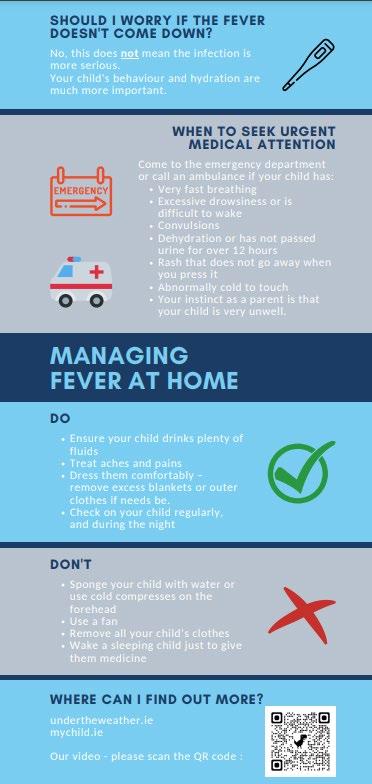
Small baby rules (6 months and younger)
Parents have a great sense of their child; their concern should never be disregarded and should be regarded as key information to inform the situation.
At risk populations:
The above advice pertains to children older than 6 months of age. Babies younger than six months are a special population that require a different approach when it comes to fevers. Febrile babies require more investigation than their older counterparts.
There are several groups of children that are at higher risk of infection, and these can present differently. A higher degree of caution is required. These include those with disabilities with cognitive impairment or communicative difficulties.
• Baby 0-3 months old develop a fever ≥38.0°C
Children that have these conditions are more susceptible to infections such as pneumonia or urinary tract
Current HSE guidance would recommend medical attention be sought if:
• Baby 3-6 months old develop a fever >39.0°C
infections. These vulnerabilities are compounded by factors such as immobility or medical device dependence which can be another potential source of infection to consider. Communication can be an issue, and the child may convey their symptoms in ways that are only recognised by a carer and underappreciated by clinical staff. This underpins the need for the parent’s (or caregiver’s) input as they know the child well and are familiar with the nuances of their behaviours.7
A low threshold is reserved for those that are immunocompromised or neutropenic.8 As their immune systems are compromised, they don’t mount the same response to infection. A fever associated with these conditions could potentially be life-threatening, and prompt investigation and treatment is mandated under these circumstances.9
The final types of patients that we would consider “at risk” are the newborn and young infant.
1: Infographic with educational video on fever (QR Code) from the Department of Emergency Medicine, Children’s Health Ireland at Crumlin
2: When should my child return to school/childcare advice for parents when their child develops symptoms of some of the common childhood illnesses about whether their child should stay out of school or childcare
Small baby rules (6 months and younger)
The above advice pertains to children older than 6 months of age. Babies younger than six months are a special population that require a different approach when it comes to fevers. Febrile
This is recommended even if temperature is the only symptom present. This caution stems from a cautious approach and the baby’s inability to naturally fight some infections and incomplete vaccination status.
Table 1: Concerning symptoms associated with serious illness in infants < 6 months
Table 1: Concerning symptoms associated with serious illness in infants < 6 months
Difficult to wake
Bulging fontanelle
Excessively sleeping
Poor feeding
Vomiting Irritable
Abnormal or high-pitched crying
Floppy or poor tone
Breathing difficulties
PHARMACYNEWSIRELAND.COM
Figure
Figure
Figure
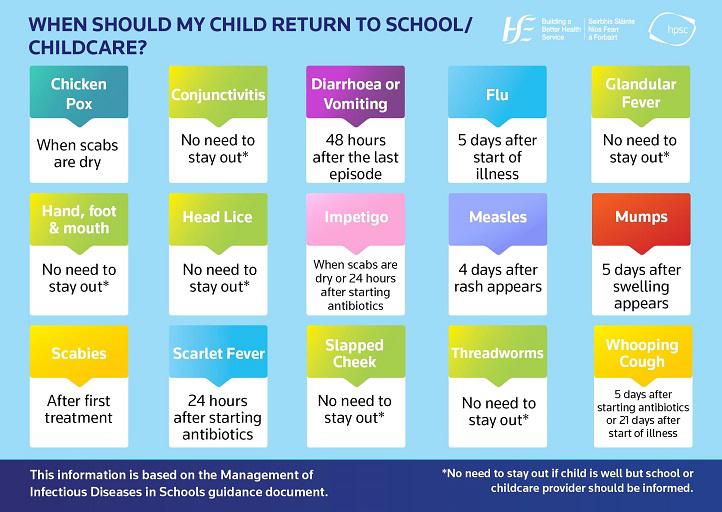
Figure 2: When should my child return to school/childcare advice for parents when their child develops symptoms of some of the common childhood illnesses about whether their child should stay out of school or childcare
References
1. Poirier MP, Collins EP, McGuire E. Fever phobia: a survey of caregivers of children seen in a pediatric emergency department. Clin Pediatr (Phila). 2010;49(6):530-4.
2. Lynch CJ, Kuhar M, Blackburn C, Barrett MJ. Fever education for caregivers in the emergency room (The FEVER study)–an interventional trial. Pediatric Research. 2024.
3. Kelly M, Sahm LJ, Shiely F, O’Sullivan R, McGillicuddy A, McCarthy S. Parental knowledge, attitudes and beliefs regarding fever in children: an interview study. BMC Public Health. 2016;16(1):540.
babies require more investigation than their older counterparts.
References:
Current HSE guidance would recommend medical attention be sought if:
• Baby 0-3 months old develop a fever ≥38.0°C
• Ibuprofen should be avoided in chickenpox unless clinician advised.
4. Apa H, Gözmen S, Bayram N, Çatkoğlu A, Devrim F, Karaarslan U, et al. Clinical accuracy of tympanic thermometer and noncontact infrared skin thermometer in pediatric practice: an alternative for axillary digital thermometer. Pediatr Emerg Care. 2013;29(9):992-7.
1. Poirier MP, Collins EP, McGuire E. Fever phobia: a survey of caregivers of children seen in a pediatric emergency department. Clin Pediatr (Phila). 2010;49(6):530-4.
• Baby 3-6 months old develop a fever >39.0°C
The instinct may be to strip clothes off and actively cool the patient, but this can cause shivering, and shivering can lead to an increase in temperature through movement. If the child is dressed comfortably, layers can be gradually removed if overheating. The importance of fluids cannot be understated. Dehydration compounds illness and has a detrimental effect on children. It is vital to anticipate this.
• It is important to maintain adequate hydration in the setting of ibuprofen use. If a child is not maintaining full oral intake then ibuprofen use should be limited to 3 days.
5. Wrotek S, LeGrand EK, Dzialuk A, Alcock J. Let fever do its job: The meaning of fever in the pandemic era. Evol Med Public Health. 2021;9(1):26-35.
2. Lynch CJ, Kuhar M, Blackburn C, Barrett MJ. Fever education for caregivers in the emergency room (The FEVER study)–an interventional trial. Pediatric Research. 2024.
6. Health Service Executive Ireland. High temperature - fever in children 2021 [Available from: https://www2.hse.ie/ conditions/high-temperature/.]
3. Kelly M, Sahm LJ, Shiely F, O’Sullivan R, McGillicuddy A, McCarthy S. Parental knowledge, attitudes and beliefs regarding fever in children: an interview study. BMC Public Health. 2016;16(1):540.
This is recommended even if temperature is the only symptom present. This caution stems from a cautious approach and the baby’s inability to naturally fight some infections and incomplete vaccination status.
The most common first port of call for a temperature is an antipyretic such as paracetamol or ibuprofen. These are effective medications in reducing temperatures, though their use needs to be reasoned.
7. Barbi E, Marzuillo P, Neri E, Naviglio S, Krauss BS. Fever in Children: Pearls and Pitfalls. Children (Basel). 2017;4(9).
4. Apa H, Gözmen S, Bayram N, Çatkoğlu A, Devrim F, Karaarslan U, et al. Clinical accuracy of tympanic thermometer and noncontact infrared skin thermometer in pediatric practice: an alternative for axillary digital thermometer. Pediatr Emerg Care. 2013;29(9):992-7.
Vaccine-associated Temperatures:
Please note that HSE weight-based dosing guides for ibuprofen and paracetamol (www.hse.ie) are derived from Irish College of General Practitioners General Practitioner Quick Reference Guide for Antipyretic Prescribing and are intended for use by prescribers only.11
Further Advice Supports
8. Haslam DB, McKinney JS. Chapter 229. Fever and Infection in the Immunocompromised Patient. In: Rudolph CD, Rudolph AM, Lister GE, First LR, Gershon AA, editors. Rudolph's Pediatrics, 22e. New York, NY: The McGraw-Hill Companies; 2011.
5. Wrotek S, LeGrand EK, Dzialuk A, Alcock J. Let fever do its job: The meaning of fever in the pandemic era. Evol Med Public Health. 2021;9(1):26-35.
Fever may occur in the first 48hrs after routine vaccine administration, and parents can be reassured that these particular fevers are normal in the absence of other concerning symptoms (Table 1).10 If a baby continued to have fevers beyond this timeframe, this would be abnormal and should be investigated further.
Temperature Management
9. Vedi A, Pennington V, O'Meara M, Stark K, Senner A, Hunstead P, et al. Management of fever and neutropenia in children with cancer. Support Care Cancer. 2015;23(7):2079-87.
6. Health Service Executive Ireland. High temperature - fever in children 2021 [Available from: https://www2.hse.ie/conditions/high-temperature/.]
7. Barbi E, Marzuillo P, Neri E, Naviglio S, Krauss BS. Fever in Children: Pearls and Pitfalls. Children (Basel). 2017;4(9).
There are numerous traditional methods of managing a fever, but the tried and tested means are:
As already discussed, the fact of having a temperature has little impact on the severity of the illness, and as such antipyretics play little part in improving the clinical condition. Whereas they are an effective means of improving the child’s comfort and wellbeing. Oftentimes, when we have a fever, we can be quite miserable, with aches and pains, and being somewhat off form. It is in these circumstances that antipyretics are endorsed. In the young >6month old children that lack the ability to convey their displeasure, this can be represented as excessive “crankiness”.
10. Health Service Executive Ireland. After Immunisation. 2022.
11. Health Service Executive Ireland. Prescribing for Children 2022 [Available from: https://www.hse.ie/eng/services/ list/2/gp/antibiotic-prescribing/ prescribing-for-children/.]
8. Haslam DB, McKinney JS. Chapter 229. Fever and Infection in the Immunocompromised Patient. In: Rudolph CD, Rudolph AM, Lister GE, First LR, Gershon AA, editors. Rudolph's Pediatrics, 22e. New York, NY: The McGraw-Hill Companies; 2011.
9. Vedi A, Pennington V, O'Meara M, Stark K, Senner A, Hunstead P, et al. Management of fever and neutropenia in children with cancer. Support Care Cancer. 2015;23(7):2079-87.
It is important to note:
10. Health Service Executive Ireland. After Immunisation. 2022.
• Dress comfortably
• Avoid fans/open windows or cold compresses
• Paracetamol should be given 4-6 hourly as required and never more than 4 times per day
12. Health Service Executive. My Child: 0 to 2 years Expert advice for every step. 5th Edition. Health Service Executive; 2021 [cited 2024 Feb 28]. [Available from: https://assets.hse.ie/media/ documents/My_Child_0_to_2_years_ book_QIxabfB.pdf]
11. Health Service Executive Ireland. Prescribing for Children 2022 [Available from: https://www.hse.ie/eng/services/list/2/gp/antibiotic-prescribing/prescribing-for-children/.]
• Treat aches or pains
• Ensure the child is drinking plenty of fluids.
• Ibuprofen should be given 6-8 hourly as required and never more than 3 times per day.
Finally, any time parents are in a medical setting with their child, it is often a time of high-stress and low-retention. One should be sure to provide written advice (e.g. digital resources) on the management and caveats of fevers, in order to allow the parent time to absorb the information or use it at their leisure. A broad sweep of expert advice for children 0-2 years is available from HSE MYCHILD.ie resources.12 Other innovative methods such as infographics or short videos explaining the fever process have been proven to be of value and should be considered (Fig. 1).2 Also attached is an infographic advising the appropriate timeframes for returning to school/childcare after different infections/symptoms from the Health Protection Surveillance Centre (Fig. 2).13
12. Health Service Executive. My Child: 0 to 2 years Expert advice for every step. 5th Edition Health Service Executive; 2021 [cited 2024 Feb 28]. [Available from: https://assets.hse.ie/media/documents/My_Child_0_to_2_years_book_QIxabfB.pdf]
13. Health Protection Surveillance Centre. When should my child return to school/childcare [Available from: https:// www.hpsc.ie/a-z/lifestages/childcare/ whenshouldmychildreturntoschoolchildcare/ ]
PHARMACYNEWSIRELAND.COM 31
Exploring the Role of the Gut in Acne Management
Novel gut-skin-microbiome approach to treating the acne inflammasome with plant-biotech, microbiomesupporting topicals and probiotic supplements

Integrative dermatology is exploring the role of the gut in acne. Disturbances in mucosal lining, microbiome dysbiosis, overgrowth of bacteria in small intestines, can all appear as rashes, flares, or even the onset of skin diseases such as acne, eczema, or psoriasis. Therefore, in additional to topical management, gut dysbiosis and inflammation must be simultaneously addressed.
Acne Gut-Skin-Microbiome Axis
Gut-skin axis studies show that acne vulgaris is correlated with an altered gut microbiome. Gastrointestinal dysfunction and dysbiosis cause excess bacterial growth of pathobionts, leading to competition for nutrients and toxic metabolite production. This results in local and systemic inflammation affecting the physiology of the skin and hair follicles. Maintaining intestinal integrity is therefore crucial for preventing skin inflammation.
As early as 1930, Stokes and Pillsbury noted the connection between gut, skin, and nervous systems: they were among the first to propose probiotic Lactobacillus acidophilus for acne treatment.1 Gut microbes and oral probiotics can be linked to the skin, and particularly acne severity, by their ability to influence mood, systemic inflammation, oxidative stress, glycemic control, and tissue lipid content.2
To date, studies suggest that the gut microbiota of acne sufferers is different from those without acne. The acneic gut microbiota are less biodiverse, with a lower ratio of Bacteroidetes to Firmicutes (dysbiosis).3 The levels of Lactobacillus, Bifidobacterium, Butyricicoccus, Coprobacillus and Allobaculum in acne sufferers were found to be lower than the control group.3 A significant reduction in commensal Actinobacteria, Bifidobacterium, Butyricicoccus, Coprobacillus, and Lactobacillus,
Written by Barbara Paldus, pictured with Codex Lab's Products
along with increased pathogenic Proteobacteria were observed in acne patients.4 This dysbiosis appears to correlate to skin sebum overproduction, which allows Cutibacterium acnes to grow unchecked and form inflammatory lesions.
The relationship between gut microbiome and skin may also be influenced by diet. A high glycemic load influences acne:5 consumption of copious sugar can increase insulin signaling in the body and trigger the FoxO1 gene that stimulates the mTORC1 complex associated with acne development.4 A high-fat diet can increase the growth of Firmicutes, which increases their ratio to Bacteroidetes, resulting in dysbiosis and alteration of serological cytokine levels that promote inflammation.4 In addition, some acne patients have hyperchlorhydria that enables colonic bacteria to migrate to the distal region of the small intestine, creating dysbiosis and overgrowth.4
Probiotic Solutions for Acne Vulgaris
In view of the gut-skin-microbiome axis, probiotics may be key to re-establishing a healthy gut microbiota, managing acne breakouts, and reducing the use of anti-biotics. Recent clinical studies demonstrate that Codex Labs’ Shaant ClearSkin™ probiotic helps reduce acne lesions by 58% within 8 weeks. It combines bacteria known to reduce gut dysbiosis and inflammation with anti-inflammatory Ayurvedic plant medicinals:
• Lactobacillus has been found to possess anti-inflammatory properties by increasing levels of IL-10, an anti-inflammatory cytokine.6
• Bifidobacterium (bifidum or lactis) has been shown to reduce pathogenic microorganisms and support the immune system, as well as positively influence inflammation-triggering glucose levels.7
• Bacillus coagulans is a spore-based probiotic with anti-inflammatory and blood lipid lowering activities.
Research also suggests that Bacillus coagulans is a producer of short-chain fatty acids that help maintain intestinal and immune homeostasis.8
• Guggul is an herb that has been shown to help reduce blood lipid levels and lower blood sugar levels. Guggul’s active ingredient, guggulsterones, have been found to decrease acne lesions in a manner comparable to the commonly used antibiotic tetracycline.9,10
• Epigallocatechin gallate (EGCG) has anti-inflammatory and antioxidant properties, allowing acne patients to experience a significant reduction in acne lesion counts.11
Local topical Management of the Acne Inflammasome
The most effective way of topically managing the occurrence of acne is by simultaneously inhibiting sebum overproduction and reducing skin inflammation.
The ShaantComplex™ is clinically proven to reduce sebum overproduction via the successful regulation of endocannabinoid pathways that manage inflammation of the sebaceous glands, inciting desquamation, along with pore diameter reduction. Together these effects prevent clogging of the pores and promote skin homeostasis to maintain epidermal structure and function by balancing skin cell proliferation and apoptosis, all in a microbiome-friendly manner. It is composed of both terrestrial and marine plants:
• Ghotu Kola (Centella asiatica) helps reduce redness and supports wound healing
• Patchouli (Pogostemon Cablin) soothes and helps enhance skin homeostasis via CB2 receptors
• Green Microalgae (Tetraselmis chui) help decrease sebum production
• Spiral Wrack (Fucus Spiralis) helps comfort irritated skin with anti-inflammatory polysaccharide fucoidans.
The ShaantComplex™ is supplemented by other Ayurvedic plants. For example, the Codex oil control cream contains Bakuchiol, derived from the babchi plant, that mimics retinol to refine skin texture and even out skin tone.
References available on request
PHARMACYNEWSIRELAND.COM 32
Advertorial


CeraPlus™ Products* Protect Skin Where it Matters Most
The Hollister CeraPlus™ Line of Ostomy Products provides skin with advanced protection and a full range of ceramide infused options so you can create the personalised solution that is best for your body.
• Enhances security and skin health
• Protection where it matters most
• Protection from leakage
Scan the QR to learn more about CeraPlusTM Ostomy Products
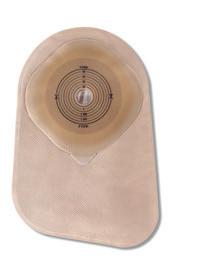
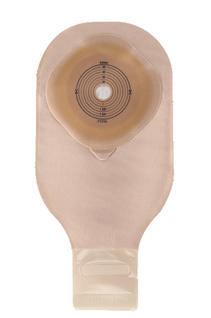

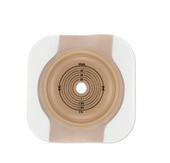
*CeraPlus skin barriers contain the Remois technology of Alcare Co., Ltd.
 Derek CeraPlus™ Product User
Hollister products are made globally, including Ballina, Ireland
Derek CeraPlus™ Product User
Hollister products are made globally, including Ballina, Ireland
Keep Peristomal Skin Healthy
Take a Look
Keep
Keep Peristomal Skin Healthy Take a Look
Keep Peristomal Skin Healthy
Keep Peristomal Skin Healthy
Peristomal Skin Healthy - Take a Look
Take a look at what’s NORMAL

Peristomal skin should be
• Dry
• No redness
Take a look at what’s NOT NORMAL
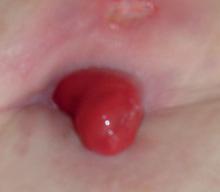
Peristomal skin should not have
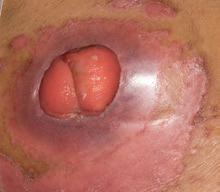
• No rash
Peristomal skin should be
• No flakiness
Peristomal skin should be
Peristomal skin should be
• Dry
• Dry
• No redness
• No redness
• No rash
• Dry
• No rash
• No rash

• No flakiness
• No redness
• No flakiness
• No flakiness
Hollister: A Leader in Skin Health
Peristomal skin should not have
Hollister: A Leader in Skin Health

• Rashes or Redness • Itching • Dryness • Excess moisture • Burning • Pain
Peristomal skin should not have
Peristomal skin should not have
• Rashes or Redness
• Rashes or Redness
• Itching
• Rashes or Redness
• Itching
• Itching
What does skin health mean to a person living with an ostomy?
What does skin health mean to a person living with an ostomy?
What does skin health mean to a person living with an ostomy?
“The CeraPlus™ Ostomy Pouch is my constant reminder that I’m still here today, and that life is still possible. Getting my stoma hasn’t stopped me from doing anything; my life has gotten better. No one should have to accept itchy, irritated peristomal skin as part of life with a stoma. Unfortunately, it’s a very real problem - but the CeraPlus™ Skin Barrier may help. CeraPlus™ Ostomy Products are secure, comfortable, and skin-friendly. They provide me with a secure, comfortable fit to protect from leakage, and to keep my peristomal skin healthy.”
What does skin health mean to a person living with an ostomy?
“The CeraPlus™ Ostomy Pouch is my constant reminder that I’m still here today, and that life is still possible. Getting my stoma hasn’t stopped me from doing anything; my life has gotten better. No one should have to accept itchy, irritated peristomal skin as part of life with a stoma. Unfortunately, it’s a very real problem - but the CeraPlus™ Skin Barrier may help. CeraPlus™ Ostomy Products are secure, comfortable, and skin-friendly. They provide me with a secure, comfortable fit to protect from leakage, and to keep my peristomal skin healthy.”
Derek CeraPlus™ Product User
“The CeraPlus™ Ostomy Pouch is my constant reminder that I’m still here today, and that life is still possible. Getting my stoma hasn’t stopped me from doing anything; my life has gotten better. No one should have to accept itchy, irritated peristomal skin as part of life with a stoma. Unfortunately, it’s a very real problem - but the CeraPlus™ Skin Barrier may help. CeraPlus™ Ostomy Products are secure, comfortable, and skin-friendly. They provide me with a secure, comfortable fit to protect from leakage, and to keep my peristomal skin healthy.”
“The CeraPlus™ Ostomy Pouch is my constant reminder that I’m still here today, and that life is still possible. Getting my stoma hasn’t stopped me from doing anything; my life has gotten better. No one should have to accept itchy, irritated peristomal skin as part of life with a stoma. Unfortunately, it’s a very real problem - but the CeraPlus™ Skin Barrier may help. CeraPlus™ Ostomy Products are secure, comfortable, and skin-friendly. They provide me with a secure, comfortable fit to protect from leakage, and to keep my peristomal skin healthy.”
Derek CeraPlus™
Derek CeraPlus™ Product User
• Burning
• Pain
• Dryness
• Dryness
• Burning
• Burning • Pain
• Pain

• Excess moisture
• Dryness
• Excess moisture
• Excess moisture
What does skin health mean to the stoma care nurse?
What does skin health mean to the stoma care nurse?
What does skin health mean to the stoma care nurse?
What does skin health mean to the stoma care nurse?
“As a Stoma Nurse healthy skin is fundamental to good stoma management. Skin which is intact, free from redness, irritation and discomfort, facilitates good pouch adhesion and security for people living with an ostomy. Despite more than 70% of those with an ostomy experiencing peristomal skin complications, the importance of skin health is often overlooked. Stoma Nurses need to have confidence that the products they recommend will optimise skin health and enhance quality of life for their patients.”
“As a Stoma Nurse healthy skin is fundamental to good stoma management. Skin which is intact, free from redness, irritation and discomfort, facilitates good pouch adhesion and security for people living with an ostomy. Despite more than 70% of those with an ostomy experiencing peristomal skin complications, the importance of skin health is often overlooked. Stoma Nurses need to have confidence that the products they recommend will optimise skin health and enhance quality of life for their patients.”
“As a Stoma Nurse healthy skin is fundamental to good stoma management. Skin which is intact, free from redness, irritation and discomfort, facilitates good pouch adhesion and security for people living with an ostomy. Despite more than 70% of those with an ostomy experiencing peristomal skin complications, the importance of skin health is often overlooked. Stoma Nurses need to have confidence that the products they recommend will optimise skin health and enhance quality of life for their patients.”
“As a Stoma Nurse healthy skin is fundamental to good stoma management. Skin which is intact, free from redness, irritation and discomfort, facilitates good pouch adhesion and security for people living with an ostomy. Despite more than 70% of those with an ostomy experiencing peristomal skin complications, the importance of skin health is often overlooked. Stoma Nurses need to have confidence that the products they recommend will optimise skin health and enhance quality of life for their patients.”
Cliona, Stoma Care Nurse
PHARMACYNEWSIRELAND.COM 35 Advertorial
Ostomy Care Healthy skin. Positive outcomes. Not all products are CE marked. Hollister, the Hollister logo and CeraPlus are trademarks of Hollister Incorporated. All other trademarks and copyrights are the property of their respective owners. © 2024 Hollister Incorporated.
The testimonials, statements, and opinions presented are applicable to the people depicted. These testimonials are representative of their experiences, but the exact results and experience will be unique and individual to each person. Prior to use, be sure to read the package insert for information regarding Intended Use, Contraindications, Warnings, Precautions, and Instructions For Use.
✗ ✗ ✗ ✔
Product User
Contact our Hollister Nursing Team TODAY for support and a peristomal skin assessment: Tel: 1800503400 email: customerservicesie@hollister.com ACT NOW Ostomy Care Healthy skin. Positive outcomes. Not all products are CE marked. Hollister, the Hollister logo and CeraPlus are trademarks of Hollister Incorporated. All other trademarks and copyrights are the property of their respective owners. © 2024 Hollister Incorporated.
Take a Look Hollister: A Leader in Skin Health The testimonials, statements, and opinions presented are applicable to the people depicted. These testimonials are representative of their experiences, but the exact results and experience will be unique and individual to each person. Prior to use, be sure to read the package insert for information regarding Intended Use, Contraindications, Warnings, Precautions, and Instructions For Use. Take a look at what’s NORMAL Take a look at what’s NOT NORMAL ✗ ✗ ✗ ✔
Cliona, Stoma Care Nurse
Contact our Hollister Nursing Team TODAY for support and a peristomal skin assessment: Tel: 1800503400 email: customerservicesie@hollister.com ACT NOW Ostomy Care Healthy skin. Positive outcomes. Not all products are CE marked. Hollister, the Hollister logo and CeraPlus are trademarks of Hollister Incorporated. All other trademarks and copyrights are the property of their respective owners. © 2024 Hollister Incorporated.
Take a Look Hollister: A Leader in Skin Health The testimonials, statements, and opinions presented are applicable to the people depicted. These testimonials are representative of their experiences, but the exact results and experience will be unique and individual to each person. Prior to use, be sure to read the package insert for information regarding Intended Use, Contraindications, Warnings, Precautions, and Instructions For Use. Take a look at what’s NORMAL Take a look at what’s NOT NORMAL ✗ ✗ ✗ ✔
Derek CeraPlus™ Product User
Cliona, Stoma Care Nurse
Contact our Hollister Nursing Team TODAY for support and a peristomal skin assessment: Tel: 1800503400 email: customerservicesie@hollister.com ACT NOW Ostomy Care Healthy skin. Positive outcomes. Not all products are CE marked. Hollister, the Hollister logo and CeraPlus are trademarks of Hollister Incorporated. All other trademarks and copyrights are the property of their respective owners. © 2024 Hollister Incorporated.
Hollister: A Leader in Skin Health The testimonials, statements, and opinions presented are applicable to the people depicted. These testimonials are representative of their experiences, but the exact results and experience will be unique and individual to each person. Prior to use, be sure to read the package insert for information regarding Intended Use, Contraindications, Warnings, Precautions, and Instructions For Use. Take a look at what’s NORMAL Take a look at what’s NOT NORMAL ✗ ✗ ✗ ✔
Cliona, Stoma Care Nurse
Contact our Hollister Nursing Team TODAY for support and a peristomal skin assessment: Tel: 1800503400 email: customerservicesie@hollister.com ACT NOW QP-5223 Hollister Leaders in Skin Health 2pp Ad IE Single pages.indd 2 26/03/2024 15:51
New research on gut microbes and allergies in newborns
Lockdowns imposed during the COVID-19 pandemic had an impact on the gut microbiome development of babies born during these periods according to new research from RCSI University of Medicine and Health Sciences, Children’s Health Ireland and APC Microbiome Ireland (APC), a world-leading SFI Research Centre based in University College Cork.
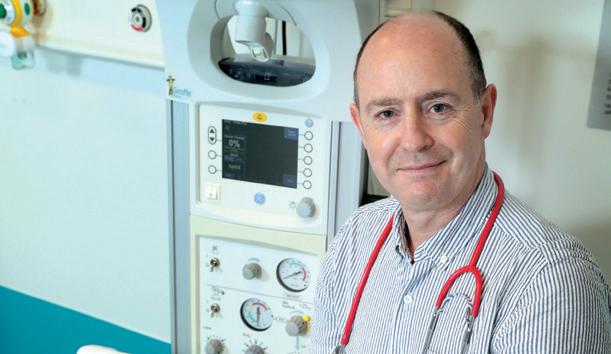
Our gut microbiome, an ecosystem of microbes that live in our digestive tract, plays an essential role in human health. The study, published in Allergy, is the first to specifically explore the gut health of newborns in the pandemic. It revealed significant differences in the microbiome development of babies born during lockdown periods when compared to prepandemic babies. Babies born during lockdown also had lower than expected rates of allergic conditions, such as food allergies. The findings highlighted gut health benefits for ‘pandemic babies’ arising from the unique environment of lockdown, including lower rates of infection and consequent antibiotic use, and increased duration of breastfeeding. The newborns were found to have more of the beneficial microbes acquired after birth from their mother. These maternal microbes could be playing a protective role against allergic diseases.
Professor Jonathan Hourihane, Head of the Department of Paediatrics at RCSI and Consultant Paediatrician at Children’s Health Ireland Temple Street, who is joint senior author of the study, commented on the research’s implications: “This study offers a new perspective on the impact of social isolation in early life on the gut microbiome. Notably, the lower allergy rates among newborns
during the lockdown could highlight the impact of lifestyle and environmental factors, such as frequent antibiotic use, on the rise of allergic diseases.
“We hope to re-examine these children when they are five years old to see if there are longerterm impacts of these interesting changes in early gut microbiome.”
Early life exposures
Professor Liam O’Mahony, Principal Investigator at APC Microbiome Ireland and Professor of Immunology at University College Cork, is joint senior author. He added: “While we all start life sterile, communities of beneficial microbes that inhabit our gut develop over the first years of life. We took the opportunity to study microbiome development in infants raised during the early COVID-19 era when strict social distancing restrictions were in place, as the complexity of early life exposures was reduced and this facilitated a more accurate identification of the key early life exposures. Prior to this study it has been difficult to fully determine the relative contribution of these multiple environmental exposures and dietary factors on early-life microbiome development.
“One fascinating outcome is that due to reduced human exposures and protection from infection, only 17% of infants required an antibiotic by one year of age,
Professor Jonathan Hourihane, Head of the Department of Paediatrics at RCSI
Waiting List Plan
Minister for Health Stephen Donnelly has published the 2024 Waiting List Action Plan (WLAP). Total funding of ¤360 million has been provided for the WLAP this year and the WLAP sets out 19 actions across three themes, namely Delivering Capacity, Reforming Scheduled Care, and Enabling Scheduled Care Reform.
The 2024 Plan builds on progress achieved in 2021, 2022 and 2023 as part of the multi-annual WLAP approach, initiated by Minister Donnelly to sustainably reduce and reform hospital waiting lists and waiting times, and to move closer to achieving the Sláintecare maximum wait times.
This year’s Plan encompasses four overarching targets to reduce both waiting list numbers and also the time that people wait for their care, namely:
which correlated with higher levels of beneficial bacteria such as bifidobacteria. The study has provided a rich repository of data, which we will continue to analyse and investigate in the future.”
The researchers from RCSI, CHI and APC Microbiome Ireland analysed fecal samples from 351 babies born in the first three months of the pandemic, comparing these with prepandemic cohorts. The former were part of the CORAL (Impact of CoronaVirus Pandemic on Allergic and Autoimmune Dysregulation in Infants Born During Lockdown) project. Online questionnaires were used to collect information on diet, home environment and health. Stool samples were collected at six, 12 and 24 months and allergy testing was performed at 12 and 24 months.
'Association between Gut Microbiota Development and Allergy in Infants Born during Pandemic-Related Social Distancing Restrictions' was carried out in collaboration with University College Cork, University of Helsinki, University of Colorado, Karolinska Institute Stockholm, Children’s Health Ireland, Rotunda Hospital and The Coombe Hospital.
The CORAL study was supported by the Temple Street Hospital Foundation in Dublin, Ireland and the Clemens von Pirquet Foundation in Geneva, Switzerland.
• Sláintecare Time Targets - reducing the number of patients breaching the Sláintecare Time Targets (as of year-end 2023) by 10%
• Patients Waiting Over three years – reducing the number of patients waiting over 3 years or at risk of being over 3 years by 90%
• National Service Plan (NSP) Maximum Wait Time targets - increasing the proportion of patients who are waiting less than the NSP maximum wait time targets to 90%
• Waiting List Volume - reducing the overall waiting list volume by almost 6% by year-end
It is important that these targets are contextualised based on projected activity rates for 2024. In 2023, the overall removals target was exceeded by 5%, with over 1.74 million patients removed from hospital waiting lists. The 2024 WLAP expects to remove even more patients this year and is projecting that over 1.81 million patients will be removed from hospital waiting lists by the end of December 2024.
However, the rate of additions to the waiting list in 2024 is also projected to further increase beyond the levels experienced last year.
PHARMACYNEWSIRELAND.COM 36 News

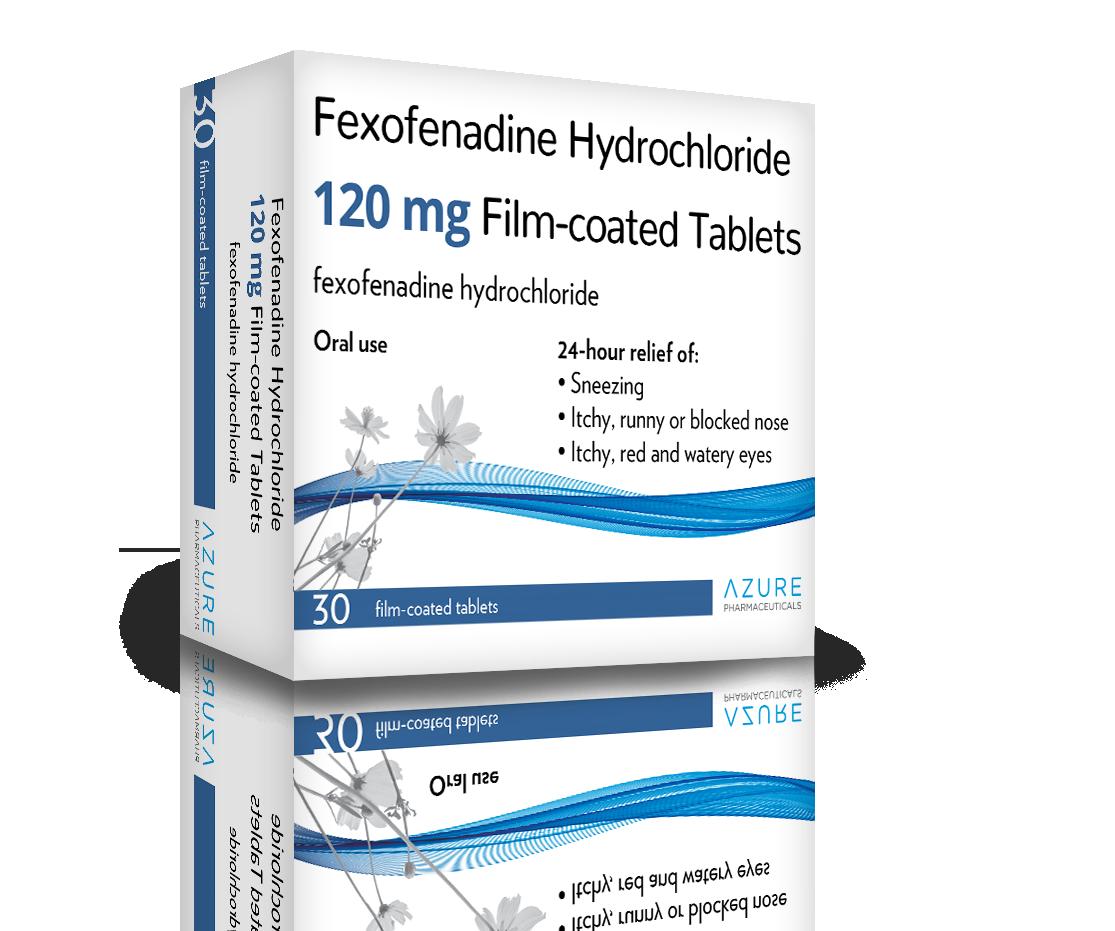









Savings to For details of your introductory offer please contact Sarah Corry on 087 391 0378 OFFER INTRODUCTORY www.azure-pharma.com BIG RELIEF, SMALL PRICE FEXOFENADINE 120mg OTC NEW OTC LAUNCH! A copy of the Summary of Product Characteristics is available upon request. Product not subject to medical prescription. Supply through pharmacies only. PA22871/004/002, License Holder, Azure Pharmaceuticals Ltd, 12 Hamilton Drive, The Rock Road, Blackrock, Co Louth. DOP: 12/04/24. * Ireland Thinks survey on behalf of Azure. 83% of Irish consumers signal price as key consideration when purchasing medicines. 83%
Using Data to drive Online Business Growth
Data, the engine behind every online store, is one of your most valuable resources. In a highly competitive market, its increasingly difficult to stand out from the crowd, this is where the need for ecommerce analytics to make confident decisions is crucial.

Ecommerce analytics gathers data from all the sources that can influence the performance of your online store. The analysis of this data will help you to understand the market, monitor sales, revenue, and product performance and crucially identify changes in customer behaviour.
Despite recognising the importance of ecommerce analytics many retailers struggle to know where to begin. Let’s start by looking at some of the more important data metrics.
Revenue
Revenue is arguably the most important figure. Comparing your revenue figures on a weekly, monthly and annual basis is crucial to identify trends and track goals.
Calculate revenue using the following formula: Traffic x Conversion Rate x Average Order Value (AVO) = Revenue.
These metrics are key to managing your Revenue Goals and any goals to increase your Revenue should be focused around boosting one or all of these metrics. Record and track these key metrics and ask yourself what would be the impact on your Revenue if you were to, for example, boost traffic by 10%, increase your Conversion Rate by 1% or improve your AOV by 20%. The first step in using your data to drive business growth is knowing, understanding and tracking these key metrics.
Merchandising Insights
To drill deeper into your Revenue figures you should look at your Merchandising Insights, this will help you to understand customer preferences and behaviours so you can optimise your offering. Key Merchandising insights include analysing your Sales Trends, do you know where your Revenue is coming from, what you are
Written by Orla Cooney, COO Magico
Top Brands, Top Categories and Top Products. Is the majority of your Revenue coming from one or two brands, is that a strength or does it leave your vulnerable if these brands become more widely stocked by other pharmacies? Do your high margin products appear in your Top Products and if not what do you need to do to rectify this? Are you aware of and proactively promoting on trend / hero skincare, beauty or wellness products from your product mix to maximise sales? Customer feedback and insights shared from your instore sales team are important here.
An often overlooked but extremely valuable source of data is your Top Products Viewed but not Added to Baskets and your Top Products Abandoned Reports. Review these products and question why they are not converting. Are they out of stock? Put yourself in your customers shoes and ask does your product detail page present all of the detail a customer will need to make a purchasing decision. Use all this valuable data to adjust stock holding, inform pricing strategies and drive successful marketing holistic campaigns across all online and offline channels.
Marketing Insights
Marketing insights involve analysing data to understand customer behaviours, preferences, and trends to understand what channels are driving traffic to your site. These should include organic, paid media, email, search and social. It is also important to know what are your top revenue generating channels and track any changes to this.
Google Analytics will provide a wealth of valuable information and the insights gained can help you identify successful tactics, areas for improvement, and emerging opportunities.
Who should look at the Data and How Often?
A common challenge facing Retailers is finding the time to dedicate to ecommerce analytics and it is easy to get overwhelmed by the sheer volume of data so
let’s take a look at who should look at what data and how often that should happen.
Daily
The Online Operations Team should be reviewing key metrics such as Traffic, Conversion Rate, AVO, Cart Abandonment Rates, Top Selling Products and Ad Spend Efficiency on a daily basis. Regular tracking will help you spot and respond to issues and opportunities immediately. An in demand high value product may be out of stock impacting conversion rate and AVO, an influencer may mention your product or store on social media driving a sudden spike in traffic and sales of a particular product –being close to the numbers means you will spot this and have the opportunity to capitalise on it.
Weekly
A weekly review will help you assess the effectiveness of any user experience changes, new pricing or promotional strategies and any current marketing campaigns. Key metrics to focus on include success from Paid Campaigns, Conversion Rate, AVO, Top Brands, Top Categories, Top Products, Products Viewed but not Purchased, Missed Upsell Opportunities , Customer Engagement via email, SMS and social.
Monthly
Senior management including the buying team should engage in a monthly review to help identify long term buying trends and assess whether the online business is meeting its overall goals. The monthly review would look at Revenue Trends, the Customer Lifetime Value, Inventory Plans, Revenue on Advertising Spend (ROAS).
Quarterly/Annual
A regular strategic review should consider how external factors such as market trends, global factors and competition are affecting the online business, its overall profitability and the wider value it is bringing to the business to ensure the strategy is adjusted accordingly.
By utilising analytics effectively, online stores can gain valuable insights into customer behaviour, improve marketing effectiveness, optimise operations, and ultimately drive growth and profitability.
PHARMACYNEWSIRELAND.COM 38
Advertorial

‘Huge Moment’ for Cystic Fibrosis
A Cystic Fibrosis drug targeting the basic defect that causes the condition has been shown to be safe and effective in newborns aged four weeks and above, new research involving RCSI University of Medicine and Health Sciences and Children’s Health Ireland has found.

The finding is described as a ‘huge moment’ for Cystic Fibrosis by one of the lead researchers. The study included the first baby in the world with Cystic Fibrosis to be diagnosed from birth and enrolled directly onto a trial of this sort. The drug, Ivacaftor (Kalydeko), is the first drug designed to treat the basic defect in Cystic Fibrosis. It was originally approved for adults, then sequentially over several years for older and younger children. Currently, it is approved
Siblings Kara and Isaac Moss who both participated in the study through Children’s Health Ireland with Paul McNally, Associate Professor of Paediatrics at RCSI and Consultant in Respiratory Medicine at CHI
for babies aged four months and older, however, this new research suggests that it is safe and effective for babies as young as four weeks of age.
Cystic Fibrosis experts predict that the earlier treatments can begin, the more likely that progression of the condition can be slowed down or halted in children, and this is the focus of several international research studies led by RCSI and Children’s Health Ireland. The findings of this study could pave the way for eligible newborns to
start treatment on the medicine at the time of diagnosis (typically at newborn screening) rather than having to wait until they are four months old.
“This is a huge moment in Cystic Fibrosis,” said Paul McNally, Associate Professor of Paediatrics at RCSI and Consultant in Respiratory Medicine at CHI. McNally is one of the authors of the new study, which was published in the Journal of Cystic Fibrosis.
“Over the years Ivacaftor, or Kalydeko, has been put through clinical trials in younger and younger children. Now, through this study, it has been shown to be safe and effective all the way down to four weeks of age,” he said. “This is an important development because almost all children are diagnosed through newborn screening at around this time. The availability of a treatment that targets the underlying cause of the disease in newborns and can be started immediately at diagnosis will provide a huge sense of reassurance and hope for families.”
Happy Days for HappyTummy.ie™ - And Parents Too!
If you are the parent of a baby who suffers from the upset and distress of colic, expert help is now even closer at hand. Scientifically developed and rigorously researched by BioGaia, their multi-awardwinning Protectis® baby probiotic drops are now conveniently available in a number of McCabes Pharmacies across the country.
BioGaia Protectis® is a simple-toadminister liquid probiotic natural treatment that is proven to gently soothe the symptoms of colic, tummy pain, release trapped wind, and reduce crying time by over 56%.
What’s more, Protectis® specifically has the key L. reuteri DSM17938 strain, most clinically researched probiotic strain in the World for colic, resulting in significantly happier babies. As well as greatly relieved parents, too.
According to Sinead FitzGerald, owner of HappyTummy.ie, Irish distributor for BioGaia, “We are
delighted to be working with McCabes Pharmacies to make BioGaia Protectis® baby drops more readily available to Irish parents of babies suffering from the challenges of colic. This is a great natural product and an amazing colic treatment that is literally streets ahead in terms of its scientific development and overall efficacy.”
Currently stocked in the following 12 McCabes stores: Dundrum, Blanchardstown, Citywest, Clarehall, Gorey, Woodstown, Adelphi, Malahide and McCabes online store.
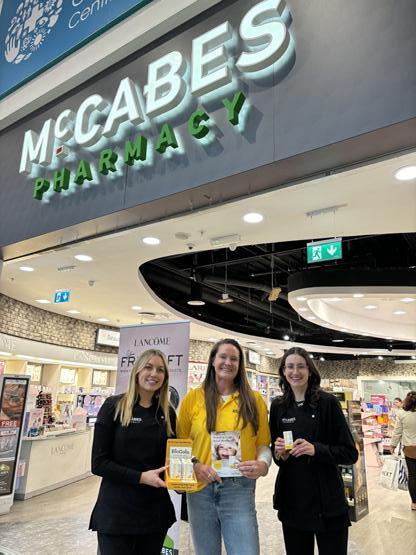

PHARMACYNEWSIRELAND.COM 40 News
BioGaia Protectis® baby drops colic treatment now available at selected McCabes Pharmacies. #HappyTummyHappyMummy'


BioGaia Probiotic Baby Drops
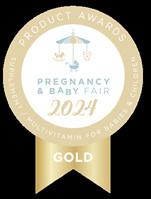
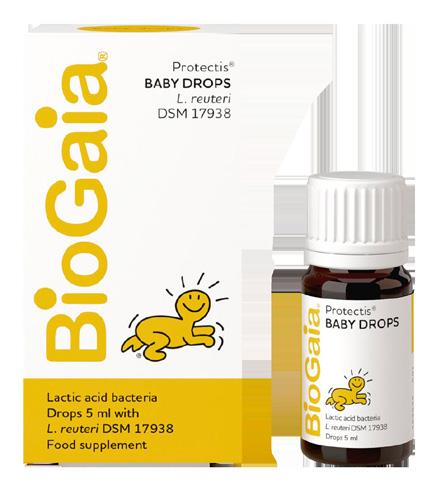
PRODUCT INFORMATION Information to healthcare professionals
Small drops - Big difference for Infant Colic
BioGaia Protectis baby drops
BioGaia Protectis baby drops
BioGaia Protectis baby drops
BioGaia Protectis baby drops
BioGaia Protectis baby drops
BioGaia Protectis baby drops
Small drops – Big difference
BioGaia Protectis baby drops PRODUCT Information
BioGaia Protectis baby drops
Small drops – Big difference
Small drops – Big difference
Small drops – Big difference
Small drops – Big difference
Small drops – Big difference
Small drops – Big difference
Small drops – Big difference
• The most clinically researched probiotic for infant colic - Limosilactobacillus Reuteri ProTectis - L. reuteri DSM17938. Tested in more than 150 studies
BioGaia Protectis baby drops are a simple, safe and convenient way to and function in infants. 1-9
BioGaia Protectis baby drops are a simple, safe and convenient way to maintain and function in infants. 1-9
BioGaia Protectis baby drops are a simple, safe and convenient way to maintain and function in infants. 1-9
BioGaia Protectis baby drops are a simple, safe and convenient way to maintain and function in infants. 1-9
BioGaia Protectis baby drops are a simple, safe and convenient way to maintain and function in infants. 1-9
BioGaia Protectis baby drops are a simple, safe and convenient way to maintain and function in infants. 1-9
BioGaia Protectis baby drops are a simple, safe and convenient way to maintain and function in infants. 1-9
BioGaia Protectis baby drops are a simple, safe and convenient way to maintain gastrointestinal motility, health and function in infants. 1-9
The drops contains Limosilactobacillus* reuteri Protectis® (L. reuteri DSM 17938) strain. Five drops daily provides the recommended daily dose of 100 million
The drops contains Limosilactobacillus* reuteri Protectis® (L. reuteri DSM
The drops contains Limosilactobacillus* reuteri Protectis® (L. reuteri DSM strain. Five drops daily provides the recommended daily dose of 100
The drops contains Limosilactobacillus* reuteri Protectis® (L. reuteri DSM 17938) strain. Five drops daily provides the recommended daily dose of 100 million
The drops contains Limosilactobacillus* reuteri Protectis® (L. reuteri DSM 17938) strain. Five drops daily provides the recommended daily dose of 100 million
The drops contains Limosilactobacillus* reuteri Protectis® (L. reuteri DSM 17938) strain. Five drops daily provides the recommended daily dose of 100 million live
The drops contains Limosilactobacillus* reuteri Protectis® (L. reuteri DSM strain. Five drops daily provides the recommended daily dose of 100 million
The drops contains Limosilactobacillus* reuteri Protectis® (L. reuteri DSM 17938), a safe and documented probiotic strain. Five drops daily provides the recommended daily dose of 100 million live active L. reuteri Protectis bacteria.
• Encourages good bacteria in the digestive tract.
Several clinical studies have proven that BioGaia Protectis baby drops reduced as well as in healthy infants5. Clincal studies have also shown increased frequency and healthy infants10, 5 and decreased regurgitation.4-5
strain. Five drops daily provides the recommended daily dose of 100 million
Several clinical studies have proven that BioGaia Protectis baby drops reduced as well as in healthy infants5. Clincal studies have also shown increased frequency and healthy infants10, 5 and decreased regurgitation.4-5
Several clinical studies have proven that BioGaia Protectis baby drops as well as in healthy infants5. Clincal studies have also shown increased frequency and healthy infants10, 5 and decreased regurgitation.4-5
Can be given from birth and onwards. Intended for use in term infants.
Also available with Vitamin D
Several clinical studies have proven that BioGaia Protectis baby drops reduced as well as in healthy infants5. Clincal studies have also shown increased frequency and healthy infants10, 5 and decreased regurgitation.4-5
Several clinical studies have proven that BioGaia Protectis baby drops reduced crying time in infants with colic1-3 as well as in healthy infants5. Clincal studies have also shown increased frequency of bowel movements in constipated and healthy infants10, 5 and decreased regurgitation.4-5

• Reduced crying time in infantile colic1-3,5
• Increased number of bowel movements in constipated and healthy infants 7,10
• Reduced number of regurgitations5-6
• Safe for infants and children6-8
• Convenient administration and dosage
• Daily dose: 5 drops
• Do not affect breast-feeding or the taste of food
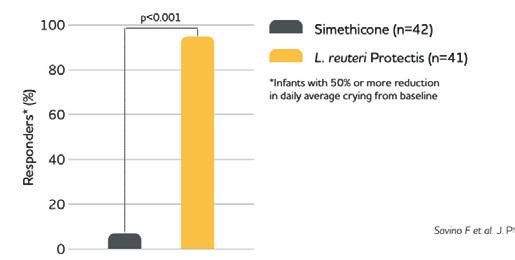
Several clinical studies have proven that BioGaia Protectis baby drops reduced as well as in healthy infants5. Clincal studies have also shown increased frequency and healthy infants10, 5 and decreased regurgitation.4-5
Can be given from birth and onwards. Intended for use in term infants.
Several clinical studies have proven that BioGaia Protectis baby drops reduced as well as in healthy infants5. Clincal studies have also shown increased frequency and healthy infants10, 5 and decreased regurgitation.4-5
Can be given from birth and onwards. Intended for use in term infants.
Can be given from birth and onwards. Intended for use in term infants.
Can be given from birth and onwards. Intended for use in term infants.
Several clinical studies have proven that BioGaia Protectis baby drops reduced as well as in healthy infants5. Clincal studies have also shown increased frequency and healthy infants10, 5 and decreased regurgitation.4-5
Can be given from birth and onwards. Intended for use in term infants.
Can be given from birth and onwards. Intended for use in term infants.
• Reduced crying time in infantile colic1-3,5
• Suitable from birth.
• Reduced crying time in infantile colic1-3,5
• Reduced crying time in infantile colic1-3,5
• Reduced crying time in infantile colic1-3,5
• Reduced crying time in infantile colic1-3,5
• Increased number of bowel movements in constipated and healthy infants 7,10
Can be given from birth and onwards. Intended for use in term infants.
• Reduced crying time in infantile colic1-3,5
• Reduced crying time in infantile colic1-3,5
• Increased number of bowel movements in constipated and healthy infants 7,10
• Increased number of bowel movements in constipated and healthy infants 7,10
• Increased number of bowel movements in constipated and healthy infants 7,10
• Reduced number of regurgitations5-6
• Increased number of bowel movements in constipated and healthy infants 7,10
• Safe for infants and children6-8
• Increased number of bowel movements in constipated and healthy infants 7,10
• Increased number of bowel movements in constipated and healthy infants 7,10
• Reduced number of regurgitations5-6
• Reduced number of regurgitations5-6
• Reduced number of regurgitations5-6
• Reduced number of regurgitations5-6
• Trusted by Paediatricians worldwide.
• Reduced number of regurgitations5-6
• Safe for infants and children6-8
Convenient administration and dosage
• Safe for infants and children6-8
• Safe for infants and children6-8
• Convenient administration and dosage
• Convenient administration and dosage


• Daily dose: 5 drops
• Convenient administration and dosage
• Daily dose: 5 drops
• Daily dose: 5 drops
• Do not affect breast-feeding or the taste of food
• Do not affect breast-feeding or the taste of food
• Do not affect breast-feeding or the taste of food







Ingredients: Sunflower (palm kernel) Shelf life: Room
PRODUCT Information 5x Use 5 drops daily Give by spoon Shake well before use
Shelf life: Room maximum 25 °C/77 Refrigerated product: seem to be strain-dependent (i.e. specific for particular strains) and should not be ascribed to other strains. Based on FAO/WHO statement from 2001 (FAO/WHO, Argentina 1-4.10.2001).
PRODUCT Information Read more on www.biogaia.com
Ingredients: (palm kernel) Shelf life: Room maximum 25 Refrigerated Please note: Positive effects of Lactobacillus reuteri seem to be strain-dependent
PRODUCT Information Use 5 drops daily Give by spoon Shake well before use * Previosuly Lactobacillus
Ingredients: Sunflower (palm kernel) and L.
5x Dosing
Dosing
Ingredients: Sunflower (palm kernel) Shelf life: Room
PRODUCT Information 5x Use 5 drops daily Give by spoon Shake well before use Dosing Available in glass bottle, 5 or 10 ml
Ingredients: (palm kernel) Shelf life:
PRODUCT Information 5x Use 5 drops daily Give by spoon Shake well before use Dosing Available in glass bottle, 5
10 ml versus Simethicone randomized study. Lactobacillus reuteri regurgitation in infants. al. (2014) Prophylactic Regurgitation, and Published online January 6. Weizman Z et al. infections in child Pediatrics 115:5-9.
or
17938)
Ingredients: Sunflower (palm kernel)
PRODUCT Information 5x Use 5 drops daily Give by spoon Shake well before use Dosing Available in glass bottle, 5 or 10 ml Savino F et al. J. Pediatrics 2007;119:124-130 95% successful treatment response Compared to simethicone, L. reuteri Protectis: • Was superior in reducing daily cry ing time • Decreased cr ying time more than twice as muc h Rate of responders* of L. reuteri Protectis versus simethicone
The Medicine Management Programme
(MMP)
recommends Tetridar® as a Best Value Medicine (BVM) for teriparatide on the High Tech Arrangement.
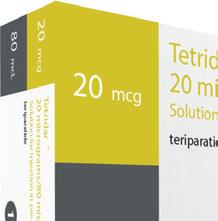
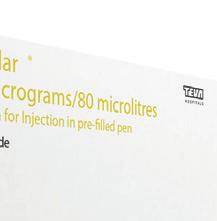
Indications
• Tetridar® is indicated in adults.
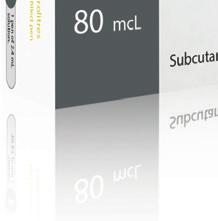
• Treatment of osteoporosis in postmenopausal women and in men at increased risk of fracture. In postmenopausal women, a significant reduction in the incidence of vertebral and non-vertebral fractures but not hip fractures has been demonstrated.


• Treatment of osteoporosis associated with sustained systemic glucocorticoid therapy in women and men at increased risk for fracture.
Further information available from the SmPC available at HPRA.ie Tetridar® (teriparatide) 20 micrograms/80 microlitres Solution for Injection in pre-filled pen Abbreviated Prescribing Information.
Presentation: Each dose of 80 microlitres contains 20 micrograms of teriparatide. One pre-filled pen of 2.4 mL contains 600 micrograms of teriparatide (corresponding to 250 micrograms per mL). Indications: Tetridar is indicated in adults for the treatment of osteoporosis in postmenopausal women and in men at increased risk of fracture. In postmenopausal women a significant reduction in the incidence of vertebral and non-vertebral fractures but not hip fractures has been demonstrated. Treatment of osteoporosis associated with sustained systemic glucocorticoid therapy in women and men at increased risk for fracture. Dosage and administration: The recommended dose of Tetridar is 20 micrograms administered once daily. The maximum total duration of treatment with Tetridar should be 24 months and the 24-month course of teriparatide should not be repeated over a patient’s lifetime. Patients should receive supplemental calcium and vitamin D supplements if dietary intake is inadequate. Following cessation of teriparatide therapy, patients may be continued on other osteoporosis therapies. Adults: Teriparatide should be administered once daily by subcutaneous injection in the thigh or abdomen. Patients must be trained to use the proper injection techniques and correct use of the pen. Until further clinical data become available, the recommended treatment time of 24 months should not be exceeded. Children: The safety and e cacy of teriparatide in children and adolescents less than 18 years has not been established. Teriparatide should not be used in paediatric patients or young adults with open epiphyses. Elderly: No dosage adjustment required. Renal impairment: Teriparatide must not be used in patients with severe renal impairment. In patients with moderate renal impairment, teriparatide should be used with caution. No special caution is required for patients with mild renal impairment. Hepatic impairment: teriparatide should be used with caution in hepatically impaired patients, as no data are available. Contraindications: Hypersensitivity to the active substance or to any of the excipients, Pregnancy and breast-feeding, Pre-existing hypercalcaemia, Severe renal impairment, Metabolic bone diseases (including hyperparathyroidism and Paget’s disease of the bone) other than primary osteoporosis or glucorticoid-induced osteoporosis, Unexplained elevations of alkaline phosphatase, Prior external beam or implant radiation therapy to the skeleton, Patients with skeletal malignancies or bone metastases should be excluded from treatment with teriparatide. Precautions and warnings: In normocalcaemic patients, slight and transient elevations of serum calcium concentrations have been observed following teriparatide injection. Serum calcium concentrations reach a maximum between 4 and 6 hours and return to baseline by 16 to 24 hours after each dose of teriparatide. Blood samples for serum calcium measurements should be taken at least 16 hours after the most recent Tetridar injection. Tetridar may cause small increases in urinary calcium excretion. Tetridar has not been studied in patients with active urolithiasis, therefore should be used in caution in patients with active or recent urolithiasis due to potential exacerbation of this condition. In short-term clinical studies with teriparatide, isolated episodes of transient orthostatic hypotension were observed. Typically, an event began within 4 hours of dosing and spontaneously resolved within a few minutes to a few hours. When transient orthostatic hypotension occurred, it happened within the first several doses. Experience in the younger adult population, including
Further information is available on request or in the SmPC. Product Information also available on the HPRA website. Prescription Only Medicine. Teva Pharmaceuticals Ireland, Digital O ce Centre Swords, Suite 101 - 103, Balheary Demesne, Balheary Road, Swords, Co Dublin, K67E5AO, Ireland.
premenopausal women, is limited. Treatment should only be initiated if the benefit clearly outweighs risks in this population. Interactions: In a study of 15 healthy subjects administered digoxin daily to steady state, a single teriparatide dose did not alter the cardiac e ect of digoxin. However, sporadic case reports have suggested that hypercalcaemia may predispose patients to digitalis toxicity. Because teriparatide transiently increases serum calcium, teriparatide should be used with caution in patients taking digitalis. Teriparatide has been evaluated in pharmacodynamic interaction studies with hydrochlorothiazide. No clinically significant interactions were noted. Co-administration of raloxifene or hormone replacement therapy with teriparatide did not alter the e ects of teriparatide on serum or urine calcium or on clinical adverse events. Pregnancy and lactation: Women of childbearing potential should use e ective methods of contraception during use of Tetridar. If pregnancy occurs, Tetridar should be discontinued. Tetridar is contraindicated for use during pregnancy and breastfeeding. It is not known whether teriparatide is excreted in human milk. Animal studies have shown reproductive toxicity. The e ect of teriparatide on human foetal development has not been studied. The potential risk for humans is unknown. E ects on ability to drive and use machines: Tetridar has no or negligible influence on the ability to drive and use machines. Transient, orthostatic hypotension or dizziness was observed in some patients. These patients should refrain from driving or the use of machines until symptoms have subsided. Adverse reactions: Anaphylaxis, serious cases of back pain have been reported within minutes of the injection, syncope, hiatus hernia, nephrolithiasis, renal failure and renal impairment. Very Common: pain in limb; Common: anaemia, hypercholesterolaemia, depression, dizziness, headache, sciatica, vertigo, palpitations, hypotension, dyspnoea, nausea, vomiting, gastroesophageal reflux disease, sweating increased, muscle cramps, fatigue, chest pain, asthenia, mild and transient injection site events, including pain, swelling, erythema, localised bruising, pruritus and minor bleeding at injection site. Consult the Summary of Product Characteristics in relation to other side e ects. Overdose: The e ects of overdose that might be expected include delayed hypercalcaemia and risk of orthostatic hypotension, nausea, vomiting, dizziness, and headache. No fatalities associated with overdose have been reported. There is no specific antidote for Tetridar. Treatment of suspected overdose should include transitory discontinuation of Tetridar, monitoring of serum calcium, and implementation of appropriate supportive measures, such as hydration. Legal category: Medicinal product subject to medical prescription. Marketing Authorisation Number: PA1986/053/001. Marketing Authorisation Holder: Teva B.V., Swensweg 5, 2031GA Haarlem, Netherlands. Job Code: MED-IE-00060. Date of Preparation: May 2022.
Adverse events should be reported. Reporting forms and information can be found at www.hpra.ie. Adverse events should also be reported to Teva UK Limited on +44 (0) 207 540 7117 or medinfo@tevauk.com
Date of Preparation: December 2023
Job Code: GEN-IE-00054
Freephone: 1800 - 201 700 Email: info@teva.ie
Continuing Professional Development
AUTHORS:
Fellow Emeritus, Professor Moira O’Brien, FRCPI, FFSEM, FFSEM(UK), FECSS, FTCD. Consultant in osteoporosis and Sports Medicine since the 70s and osteoporosis since 1990 when she set up the first osteoporosis clinic in the anatomy department of TCD. Founder and President of the Irish Osteoporosis Society. She is currently the only Osteoporosis consultant in Ireland and works in Affidea Dundrum.
Osteoporosis, what you need to know CPD
Michele O’Brien, CEO of the Irish Osteoporosis Society. Michele set up the first Falls Prevention service for senior citizens in Ireland in 2000 and has worked for the IOS Charity for 23 years.
60 Second Summary
Osteoporosis is the most common bone disease worldwide. The Irish Osteoporosis Society (IOS) have been saying for decades that it affects all age groups and both sexes. Bone loss is treatable in the majority of cases, yet more men die from the complications of osteoporotic fractures than cancer of the prostate, and men have a higher risk of morbidity and mortality than women.
Osteoporosis is a silent disease, there are no signs and symptoms, no one feels bone loss. The commonest cause is low levels of sex hormones, oestrogen in women and testosterone in men.
Osteoporosis and osteopenia are both diseases and should be thoroughly investigated, Osteopenia should not be considered “A touch of bone loss”.
The effect of medication on the prevention of fractures must be monitored closely to ensure the treatment plan is working and improve compliance.
Lifestyle, exercise, stress, diet, sleep are important factors to assess.
Effective and safe medications are available to treat osteopenia/Osteporosis. Most medications can cause possible side effects, but the benefits to bone health by preventing future fractures usually far outweighs the possible risks.
It is rarely too late to investigate and treat a patient with bone loss, even those in their 90’s with Dowagers humps.
1. REFLECT - Before reading this module, consider the following: Will this clinical area be relevant to my practice?
2. IDENTIFY - If the answer is no, I may still be interested in the area but the article may not contribute towards my continuing professional development (CPD). If the answer is yes, I should identify any knowledge gaps in the clinical area.
3. PLAN - If I have identified a
Introduction
Osteoporosis is the most common bone disease worldwide, it is a silent disease, as there are no signs and symptoms. There is a significant amount of misinformation and myths about osteoporosis, both in the public and Healthcare domain.
For example, the Irish Osteoporosis Society (IOS) have been saying for decades that it affects all age groups and both sexes, yet most believe it only affects old women. Findings from a recent survey by Athena Pharmaceuticals found that one in five adults have fractured a bone since they turned 40, over a third of these people reported to have had a fragility fracture and the rate of these low impact fractures was high amongst 40 to 54 year olds. Prevention ideally should start in childhood, which is why physical activity should be mandatory in all schools and integrated into the school curriculum, as not only does it help to prevent Osteoporosis but obesity and a list of other diseases.
knowledge gap - will this article satisfy those needs - or will more reading be required?
4. EVALUATE - Did this article meet my learning needs - and how has my practise changed as a result?Have I identified further learning needs?
5. WHAT NEXT - At this time you may like to record your learning for future use or assessment. Follow the
4 previous steps, log and record your findings.
Disclaimer: All material published is copyright, no part of this can be
More men die from the complications of osteoporotic fractures than cancer of the prostate and men have a higher risk of morbidity and mortality than women.
More women are affected, and more women die from the complications of osteoporotic fractures, than the combined deaths from cancers of the breast, ovaries, and cervix.
Now that you have picked your jaw up from the floor, these are some of the many reasons why all health care professionals need to review their knowledge on Osteoporosis, so the prevention, diagnosis and treatment rates can be improved, and why fragility fractures in those under 65 should have bone loss ruled out, as the cost of treating fractures will double by 2030.
Osteoporosis is characterised by low bone density, abnormal changes in the microarchitecture of bone tissue, particularly cancellous bone, making it more fragile, with an increased risk of low trauma fractures. It is essential to find the cause/s of bone loss and modify
as many risk factors as possible going forward.
The commonest bones to fracture are the cancellous part of the distal radius, the body of the vertebrae or the hip (neck of femur) and vertebrae but any bone can be affected. A low trauma fracture (trip and fall from a standing height or less) is usually the first sign of this silent disease, along with loss of height, postural changes such as their head protruding forward, rounded shoulders and/or a Dowagers hump developing.
It is estimated that up to 500,000 people in Ireland may have osteoporosis and that over 50,000 osteoporotic fractures occur each year in Ireland. 1 in 2 women and 1 in 4 men over 65, will develop an osteoporotic fracture in their lifetime, if it is not prevented. Younger people will develop osteopenia and/or osteoporosis if they have risk factors for bone loss, which is why in an ideal world any patient being put on a new medication or diagnosed with a new condition should be red flagged if either place them at risk for bone loss, so a plan can be
CPD
Published
downloaded from www.irishpharmacytraining.ie
by HPN. Copies can be
any
43
used in
other publication without permission of the publishers and author.
CPD: Osteoporosis
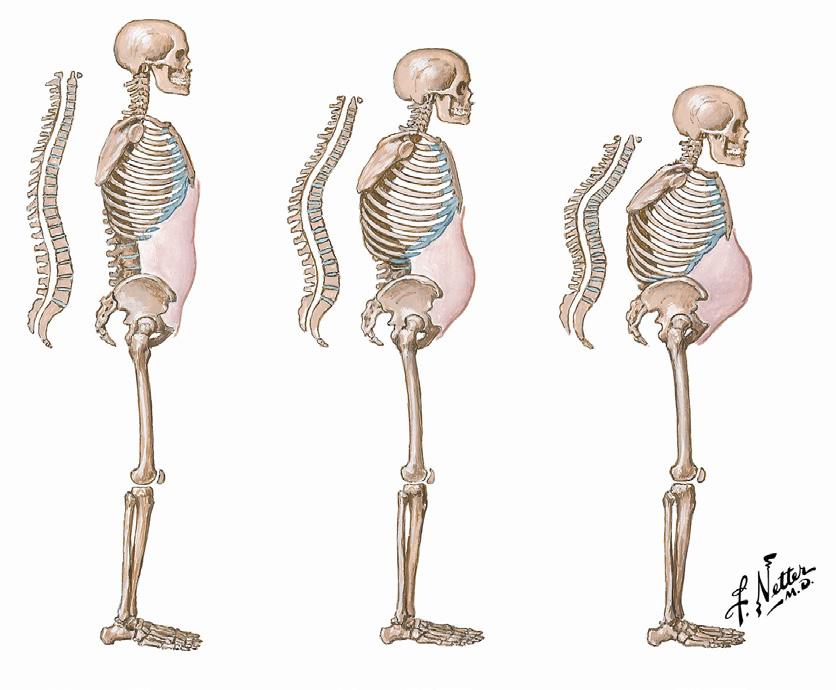
implemented to decrease their risk of fracturing. Some of the many examples; Oral steroids, early menopause, eating disorders, RA.
20% of Irish people aged 60+who fracture their hip will die within 6 to 12 months from a blood clot, infection or pneumonia which are the secondary effects of a fracture. Osteoporosis is rarely on a discharge letter or on a death certificate, even though reading the notes, the patients were admitted and treated because they had low trauma fractures. In 2022, the cost of acute hip fracture care was estimated at ¤48,569,325 nationally.
Many patients in Ireland and worldwide have untreated low trauma osteoporotic fractures, despite the fact that there are effective and safe medications available.
Osteoporotic fractures impose a huge social and financial burden in Europe and Ireland, blocking
acute beds, 50% of older people who suffer an osteoporotic hip fracture, lose their independence, have poor quality-of-life, which significantly increases costs to the Health Service. Increasing age is a factor and Ireland has one of the highest rates of fragility fractures in Europe, along with one of the greatest increases in the number of its population over the age of 80. Women and men over the age of 65 are the highest risk group but prevention in earlier life will save millions of euros long term.
NOTE: Calcium and vitamin D supplements are not treatments. Intake of Calcium and Vitamin D is essential not only for bone health; however they should preferably be taken through food. How much the patient takes from food should be assessed prior to prescribing a calcium and vitamin D supplement, as many appear to just need vitamin D supplements.
70% of the population will develop back pain in their lifetime,
this may be due to a variety of causes, either local or referred. Back pain associated with loss of height and changes in posture are red flags for osteoporotic vertebral fractures. 50% of women with vertebral fractures go undiagnosed. 75% of people with vertebral fractures may only have intermittent back pain, but 25% will have extreme pain which in many cases the pain can only be relieved by daily injections of teriparatide, which it is believed to occur secondary to the increase in rebuilding of bone.
It is very important to differentiate undiagnosed osteoporosis with osteoarthritis and degenerative disc disease, which may affect the L4, L5 nerve roots, causing pain in the distribution of the gluteal and sciatic nerves. This pain is usually aggravated by sitting too long or standing too long. Many patients may have a combination of both osteoporosis and osteoarthritis in the vertebrae.
The effects of undiagnosed bone loss
The increased osteophytes give a false higher reading on a DXA scan of the lumbar spine, which is why the coloured images on a DXA scan should be viewed and reported as well as individual vertebrae, not just the average of the four vertebrae. Fractures or multiple myeloma or secondaries from cancer in the body of the vertebrae may also cause increased false higher readings, making the bone appear healthier than it is. Cause of back pain must be investigated and addressed, and vertebral fractures ruled out.
NOTE: Low bone density increases the incidence of musculoskeletal problems. There are over 200 causes of bone loss, either the disease itself or the treatment for the disease or lifestyle choices/addictions.
Osteoporosis and its associated risk of increased fractures is rarely considered as a complication of these diseases or their treatment. You must find the causes using a multidisciplinary approach to prevent fractures, as many patients have more than one risk factor. Example A 20 year female on Depo Provera who is on an antidepressant that causes bone loss, with low calcium and vitamin D intake and is obese.
The most common cause of low bone density in females is oestrogen deficiency and testosterone deficiency in males. Family history of osteoporosis will increase the risk of osteopenia and/or osteoporosis by 70%. Genetic disorders such as cystic fibrosis, osteogenesis imperfecta, diabetes, haemochromatosis, homocystinuria and other metabolic disorders are risk factors. Chromosomal abnormalities such as Turner’s
44 CPD:
Osteoporosis
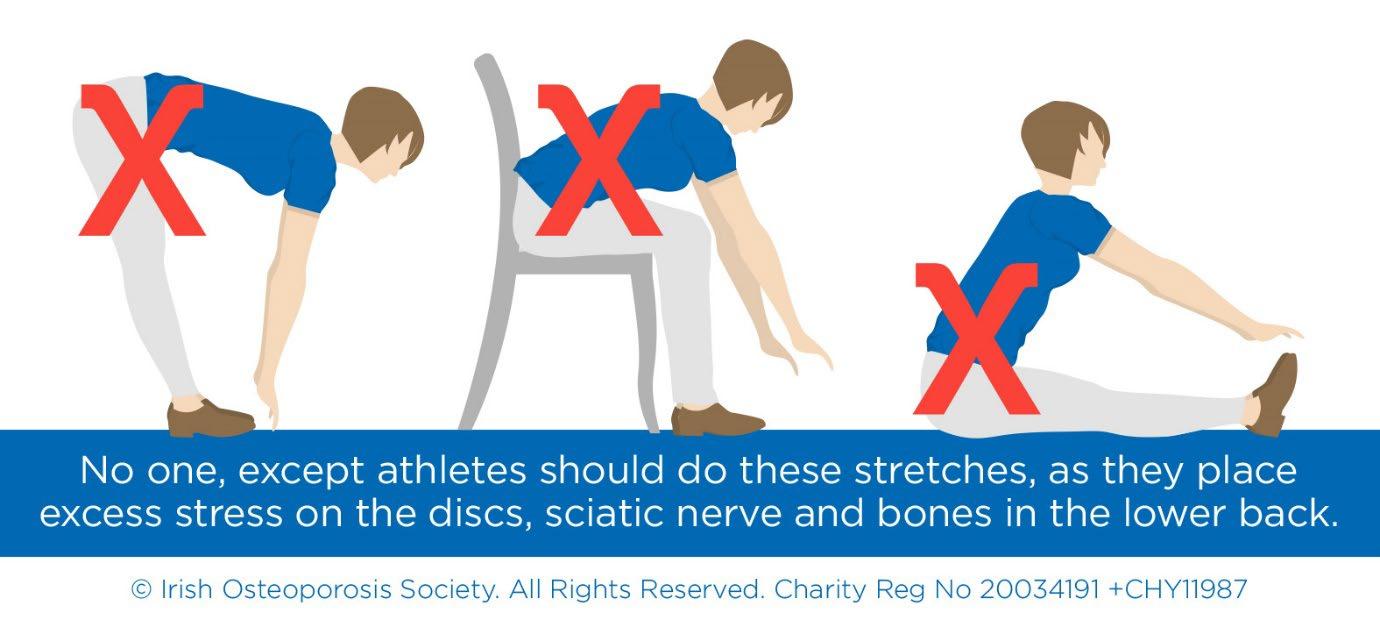
syndrome (XO) and Klinefelter’s (XXY ) in males will result in low sex hormone levels, which is why any men lucky enough to be diagnosed must have their testosterone levels checked.
Menstrual problems: Late menarche, first period after the age of 15, irregular periods, PMT, loss of periods for more than 4 months not due to pregnancy, eating disorders or Reduced Energy Deficiency Syndrome RED-S in athletes, early menopause before the age of 45, endometriosis, PCOS and Depo-Provera particularly in the teenage years during the growth spurt.
Men who have had a testicle removed, cancer of the testes or trauma causing torsion of the testes, viral or bacterial infections, need to be put on a bone loss prevention plan for osteoporosis and may require testosterone replacement therapy.
Stress either mental or physical, particularly if they have sleep issues, will increase cortisol levels which will reduce sex hormone levels. Other hormones such as high levels of cortisol, prolactin, thyroxine and parathyroid, growth hormone will affect bone metabolism.
Low levels of vitamin D (normal level for bone health should be
70 nmol per litre to 125) affects the absorption of calcium and may cause an increase in the secretion of parathyroid hormone, which takes calcium from bone, to maintain the narrow range of calcium in the blood. Hyperparathyroidism may also be due to an adenoma of the parathyroids.
Low levels of vitamin D may be due to lack of exposure to sun, inadequate intake of vitamin D in the diet or as a result of malabsorption including untreated coeliac disease or gluten and wheat intolerance, Ulcerative colitis or Crohn’s disease to name a few.
Many drugs can cause bone loss, corticosteroids, chemotherapy, radiation, aromatase inhibitors for breast cancer, androgen suppression for prostate cancer. proton pump inhibitors, warfarin, anticonvulsants and prolactin raising medication.
Poor lifestyle advice may also be a cause of developing low bone density. Running or walking they should alter the speed and the course, as bones respond to differences in strain. Cycling and swimming are non-weight bearing exercises. Patients with
and without osteoporosis should not do yoga as it contains forward flexion bending exercises, as this will compress the anterior aspect of the lumbar vertebrae, increasing the risk of fractures, excess stress on the discs and sciatic nerve. Adequate sleep and reducing stress is very important.
Nutrition plays an important role, bones require adequate calories, first-class proteins, supplemented milk’s with calcium, vitamin D, vitamin C, iron and folate help absorption. Fluid intake is also essential they should drink at least 1/2 to 2 L a day.
Diagnosis of osteoporosis
1. A detailed questionnaire (available by email from IOS) which helps find risk factors for bone loss. 95% of those who contact the IOS their causes of bone loss appear to have been assumed. If any cause of bone loss is not found and could be addressed, such as gluten sensitivity, a patient will continue to lose bone and not get the full benefit from their treatment.
2. A DXA scan - DXA is the gold standard for diagnosing osteopenia and osteoporosis, currently it is the best predictor of fractures. DXA helps to
monitor response to treatment and improve compliance. The DXA definition of osteoporosis is a T score of -2.5. The T score above 1 is normal. Osteopenia is a T score between -1 and -2.49, most fractures occur in the osteopenia range of -1.5 to -2.49. A T score of -2.5 and low trauma fracture or T score of -3 or higher is considered severe osteoporosis. For every one standard deviation of bone mineral density, the relative risk fracture is significantly increased. A DXA scan should measure the posterior anterior view of the lumbar spine, L1 to L4. Ideally the value of each vertebra should be reported not just the total values, as the density may vary, due to osteoarthritic changes, particularly in individuals with scoliosis or a dowagers hump. Increased calcium in the hyaline cartilage of the vertebrae will give a higher T score and a false high result. Increased density may also be due to vertebral fractures, multiple myeloma or secondaries.
NOTE: If a person’s DXA scan results decline, the cause/s of the decline should be investigated and addressed, changing their treatment is not the solution, as they could continue to lose bone.
45
3. Blood Investigations for causes of bone loss - List available by email from IOS. This process should also include bone turnover markers in the blood, CTX1 measures bone loss, while PINP measures bone formation. If a patient has stopped taking Denosumab (an antiresorptive) without taking another antiresorptive, or the injection has been delayed for more than approximately 4 weeks, an increase in the blood level of CTX1 may occur, indicating a high risk of spontaneous vertebral fractures.
4. Treatment plan to prevent fractures or further fractures put in place.
Monitoring bone health:
Effective and safe medications are available to treat osteopenia and osteoporosis. Most medications have possible side effects, but the benefits to bone health by preventing future fractures usually far outweighs the risk.
Treatments include
Hormone replacement therapy
- HRT should not be used in post-menopausal women just to prevent bone loss, unless they have menopausal symptoms.
Antiresorptive medication
- Bisphosphonates are nonhormonal and have to be incorporated into bone and are appropriate for some patients but not all and they can only be prescribed for 5 years in total. They may cause irritation of the oesophagus and proton pump inhibitors should not be prescribed for patients to tolerate them, as this will cause further bone loss.
Monoclonal antibody denosumab (Prolia)
The anabolic agent teriparatide for severe Osteoporosis
Evenity (Romosozumab) has been approved by the EMA several years ago but is still not available for patients in the ROI.
Patients must understand the importance of taking the medication correctly and the consequences of stopping it without consulting their doctor, especially Prolia for dental work or as many tell the IOS, they read up
on the internet they can treat their bone loss without a prescribed medication, all they need to do is buy certain supplements!
Compliance is a major problem which can be improved by DXA and 6 monthly bone turnover markers particularly CTX1 if available, as many tell the IOS they fill their bisphosphate prescription but do not take it. If you have noncompliant patients you could refer them to the IOS.
The effect of medication on the prevention of bone loss must be monitored ideally by annual or Biannual DXA’s to improve compliance and to ensure the patient is responding to the treatment, as repeat DXA scanning is much cheaper than bone markers. Since bone loss is silent, the IOS does not recommend repeat DXA scanning every 5 years, as significant bone loss can have occurred. A DXA scan contains 10% radiation of a regular chest X-ray, and a person has been exposed to more radiation traveling from Dublin to New York, than having a DXA scan.
NOTE: Are those who have heart attacks only monitored once every 5 years? At least these patients, if this was the case would usually have signs or symptoms, with bone loss there are none, except fractures that could have been prevented by monitoring the patient.
You must find and treat the causes of osteopenia or osteoporosis. Treatment also depend on whether they are pre or postmenopausal, their age, the results of the questionnaire and blood tests, the DXA result and if they have fractured. Some patients may have difficulty in swallowing or absorbing medication, while others are needle phobic which cognitive therapy can help.
It is rarely ever too late to investigate and treat a patient to improve their quality of life and prevent further fractures, the IOS know of 90-year-olds who have significantly improved their bone health and regained their independence.
Exercise
80% of the skeleton is composed
of cortical bone and 20% is cancellous. Cortical responds more to weight bearing and differences in strain. Cancellous bone is more sensitive to hormonal changes and is more fragile and is lost first. Osteoclasts are multinucleated giant cells that remove old bone, and this process takes 3 weeks, while the osteoblasts build up new bone and this process takes several months. Weight-bearing activity stimulates the osteoblasts, and they maintain the balance of bone formation and removal. When this balance is disrupted, more bone is removed than replaced causing osteopenia and/or osteoporosis.
Weight-bearing exercise plays an essential role in treatment. Patients should be advised by a physiotherapist who specialises in bone health and can understand a DXA scan report. There is no exercise programme that suits all those with bone loss and patients should be individually assessed. It is much safer to initiate exercises with elderly patients without weights, as many have never lifted weights in their life, for elderly patients there are very basic exercises on the IOS website. By slowly increasing the weights this will reduce the risk of the patient being very sore and non-compliant and also reduces the risk of fracturing. It makes no sense to rush into maximum weights, as many calls to the IOS helpline are from those who are in agony or fractured while exercising, especially those who have been instructed to do forward flexion. A patient should be thoroughly investigated and on an Osteoporosis treatment prior to an exercise program being initiated
Lifestyle advice on nutrition particularly the importance of adequate calories, fluids as well as vitamin D as it plays an important role in calcium absorption and bone metabolism. Adequate sleep and reducing stress are important factors as they increase bone loss by increasing cortisol levels. Reduce high caffeine intake, excessive alcohol and excessive fibre in their diet no more than 30g a day and cease smoking.
References upon request
Q1 Which of the following is the first step that should be taken when a person has a fragility fracture?
a. Calcium and Vitamin D supplements
b. Investigation for risk factors for bone loss
c. Weight bearing exercise plan
d. Initiate HRT
Q2 Why should Prolia (Denosumab) not be delayed more than 4 weeks?
a. It is fine to put patients on a Prolia drug holiday for more than 4 weeks
b. Spontaneous vertebral fractures can occur
c. You can for dental implants to be done
d. You can for tooth extractions
Q3 What below does not affect bone metabolism?
a. Cortisol
b. Prolactin, Thyroxine and parathyroid
c. Vitamin D
d. Iron
Q4 What one movement should those with bone loss avoid, except for dressing and washing themselves?
a. Extension of their back
b. Forward flexion of their back
c. Walking
d. Stair climbing
Q5 Which below does not cause false higher readings on a DXA scan report?
a. Fractured Vertebrae
b. Secondaries
c. Osteoarthritis changes
d. High intake of Vitamin D
46 CPD:
CPD Questions
Osteoporosis
The Irish Pharmacy
Awards 2024










Irish Pharmacy Awards 2024 Have you Booked
Your Table?
The Irish Pharmacy Awards are taking place on Saturday, May 25th 2024 in the Clayton Hotel, Burlington Road Dublin and table bookings are now being accepted.
The importance and popularity of the Irish Pharmacy Awards is reflected by the speed with which table bookings are made.
Last year’s table bookings sold out a month before the event, and for that reason, those wishing to attend are being urged to book fast, as this year’s event promises to be even bigger and better than its predecessors!
Join over 680 of Ireland’s leading pharmacy professionals, academics, VIPs and pharmaceutical leaders for a unique opportunity to network, celebrate, share in innovation and education and celebrate with the pharmacy individuals and teams leading the way, judges, finalists and sponsors.
The Irish Pharmacy Awards, seek to uncover those individuals and teams putting in the groundwork to the enhancement of community pharmacy throughout Ireland.
They represent a unique and high-profile opportunity to celebrate the excellence and amazing achievements of Ireland’s pharmacy professionals, and reaffirm Irish Pharmacy News’s commitment to the core pursuits of pharmacy: excellence in health and innovation.



Individual ticket price
¤300 + VAT
Table of 10 price
¤2,750 + VAT

All Table Bookings include (per person seated):
Champagne on arrival
Unrivalled networking
Awards Book of Excellence – programme and commentary on finalists and the night
5 course dinner
Tea, coffee and petit four
Top entertainment and keynote address
Charity entertainment featuring incredible and unique prizes and experiences
Discounted accommodation at the Clayton Hotel
To book your table today, please contact Aoife Hunter or Kelly Jo Eastwood directly at: aoife@ipn.ie Or kelly-jo@ipn.ie




Introducing...
Who Are Edia?
Established in 2021 due to a demand for MDS robots and pharmacy automation within the UK. Edia has become one of most trusted and customer focused companies in the automationed pharmacy field.
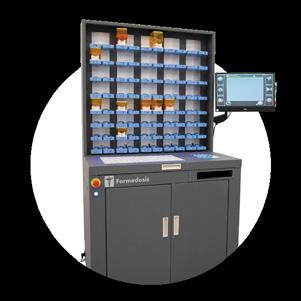
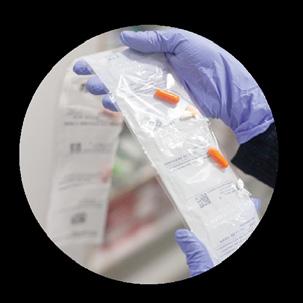
“We moved to Edia and we couldn’t be happier”
- Turf Lodge Pharmacy

Dispensing Robots
Pouch Packing
Blister Packing
Pharmacy Vending Machines
Plus More

“I couldn’t recommend Edia’s services and products highly enough to anyone thinking about moving into automation in the future”
- Armstrong’s Pharmacy

“Very knowledgeable about their products and professional with any troubleshooting issues”
- Hamilton Pharmacy
WE WILL BE ATTENDING THE COSMETIC ASSOCIATION SHOW 12TH - 14TH MAY COME FIND US
Educational Learning
A Comprehensive Guide to Treating Moderate to Severe Psoriasis
Learning Objectives
Psoriasis is a chronic multisystem autoimmune disease with prominent skin manifestations and multiple potential co-morbidities such as arthritis, inflammatory bowel disease, cardiovascular disease, and depression. Moderate-severe psoriasis is usually defined by the extent of skin involvement, although special sites or significant impact on quality of life are also considered. Topical measures should still be utilised to manage more severe psoriasis, but advanced systemic and biologic therapies have revolutionised the management of psoriasis. Phototherapy involves use of ultraviolet B or A (in combination with the photosensitiser psoralen). Systemic agents for moderate-severe psoriasis include methotrexate, ciclosporin, apremilast, acitretin, and fumaric acidic esters. Biologic targets include tumour necrosis factor alpha, interleukin-12/23, interleukin-17, and interleukin-23 inhibitors. Oral steroids should never be used to treat psoriasis due to the significant risk of potentially serious rebound flares once they are stopped and given that extremely effective targeted agents are now available.
Introduction
Psoriasis is a chronic multisystem autoimmune disease with cutaneous involvement. It is characterised by the rapid growth of skin cells, leading to the formation of thick, red, and scaly plaques, although other presentations can occur.
Approximately 73,000 people have psoriasis in Ireland. Individuals with moderate to severe psoriasis often experience significant physical and psychological co-morbidities. Most patients with psoriasis can be treated in primary care or in the outpatient setting. However, life-threatening presentations such as erythrodermic psoriasis or pustular psoriasis can require intensive inpatient management. While severe psoriasis should be managed by consultant dermatologists with access to advanced therapeutics, this article explores the various treatment options available for moderate to severe psoriasis, highlighting the importance of personalised and multimodal approaches.
Understanding Moderate-Severe Psoriasis
Psoriasis is driven by immune dysfunction that mistakenly targets healthy skin cells, triggering rapid cell turnover. This abnormal cell proliferation leads to the formation of plaques, commonly found on the elbows, knees, scalp, and lower back. Other patterns of psoriasis include guttate, flexural, pustular, and erythrodermic.
Moderate to severe psoriasis is usually defined by the extent of skin involvement, with more than 10% of the body surface affected, or a psoriasis area and severity index (PASI) over 10. Special sites that may warrant intensive treatment for localised disease include the face, palms and soles, and genitals. Additionally, individuals with
severe psoriasis may be more likely suffer from arthritis, uveitis, inflammatory bowel disease, and cardiometabolic complications, highlighting the importance of a systemic approach to treatment. Systemic or biologic therapy should be considered for extensive disease, but topical treatments are often required for localised resistant areas, in tandem with these advanced therapies.
Referral to Dermatology
Referral to a dermatologist should be considered in the following settings:
• The diagnosis is unclear
• The response to topical treatment is inadequate
• There is significant impact on quality of life
• The patient has widespread severe disease (over 10% body surface area)
• The patient has persistent involvement of ‘special sites’ –face, palms/soles, genitals
• In cases of co-morbidities, psoriatic arthritis, referral and/ or collaboration with other specialties (eg rheumatology in the case of arthritis)
Treatment Modalities
Treatment for psoriasis can be prescribed in a step-wise ladder, with topical treatments for mild disease and phototherapy, systemic agents, or biologic agents for more severe disease (Figure 1). There are theoretically more potential side effects with immunomodulatory systemic or biologic medications given that they are administered systemically, although they are
1
usually well tolerated when prescribed under the conscientious care of a dermatologist.
Topical Treatments
Emollients
Hydration and emollients are valuable and inexpensive adjuncts to psoriasis treatment. Keeping psoriatic skin soft and moist minimizes the symptoms of itching and tenderness. Additionally, maintaining proper skin hydration can help prevent irritation and thus the potential for subsequent Koebnerisation (development of new psoriatic lesions at sites of trauma). There is no secret emollient of choice for psoriasis, and patients should be led by which emollient they find most helpful.
Corticosteroids
Topical corticosteroids exert antiinflammatory, antiproliferative,
 Written by Dr Cathal O’Connor, RCPI
Written by Dr Cathal O’Connor, RCPI
dermatology
specialist registrar
in dermatology dual training in general paediatrics, ICAT paediatric dermatology fellow
and immunosuppressive actions. However topical corticosteroids have more limited ability to modify disease when used as monotherapy, so they are often combined with other topical preparations such as vitamin D analogues eg betamethasone/ calcipotriol foam. Less potent topical steroids such as hydrocortisone 1% or Eumovate should be used for facial and genital psoriasis due to greater propensity for skin thinning. There is no benefit to application more frequently than once daily, and adherence to greater than once daily topical corticosteroid therapy is very low. Topical corticosteroids generally can be continued as
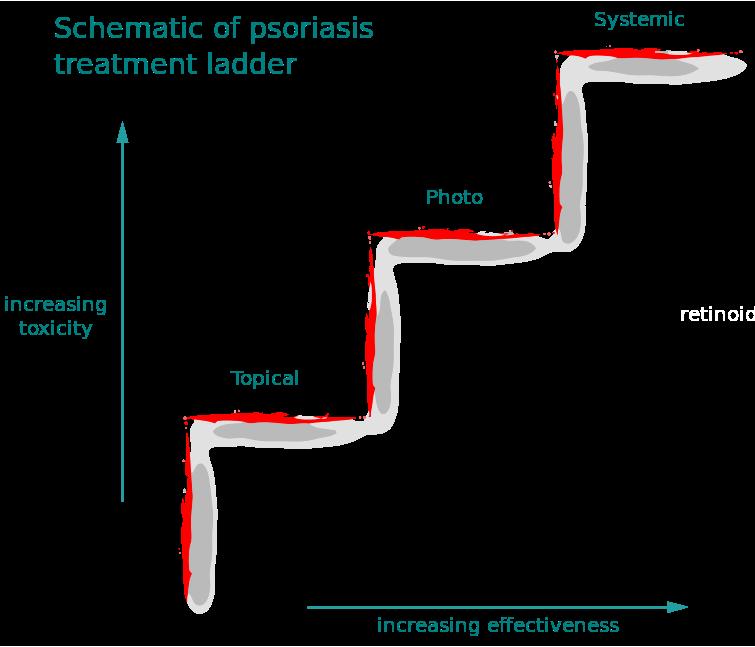
PHARMACYNEWSIRELAND.COM 49
Figure
50 Educational Learning
long as the patient has thick active lesions. Skin atrophy from topical corticosteroids is rarely a problem unless the medication is continuously applied after the skin has returned to normal thickness or if areas without psoriasis are exposed. Once clinical improvement occurs, the frequency of application should be reduced. For patients in whom lesions recur quickly, topical corticosteroids can be applied intermittently (e.g. on weekends only) to maintain improvement. The addition of noncorticosteroid topical treatments to the treatment regimen can also facilitate reduced dependence on long-term daily topical corticosteroids. The risks of cutaneous and systemic side effects associated with chronic topical corticosteroid use are greater with high-potency formulations compared with lowerpotency formulations. Oral steroids should never be used to treat psoriasis due to the significant risk of potentially serious rebound flares once they are stopped.
Vitamin D analogues
Calcipotriene and calcipotriol are synthetic forms of vitamin D that regulate skin cell growth and are used alone or used in combination with corticosteroids for enhanced efficacy.
Tar
Tar is a time-honoured modality for treating psoriasis, although newer (and less messy) treatment options
have reduced its popularity. The precise mechanism of action of tar is not known but may involve aryl hydrocarbon receptors, producing anti-inflammatory and antiproliferative effects. Tar can be helpful as an adjunct to topical corticosteroids, or be combined in the form of LPC e.g. with betamethasone. Patients should be warned that tar products have the potential to stain hair, skin, and clothing. It may help to use them at night and wear inexpensive night clothes (e.g. old pyjamas) as tar products tend to be messy. Patients may also find the odour of tar products unpleasant.
Calcineurin inhibitors
Topical tacrolimus 0.1% is effective in the treatment of psoriasis in sensitive areas such as the face and intertriginous areas, although likely less effective than topical steroids. However, they are very safe and well-tolerated, so can be used as a prophylactic agent to reduce the frequency of topical steroid use. Topical tacrolimus 0.1% is licensed from 16 years of age, while the 0.03% formulation is licensed from 2 years. However, due to the superior efficacy and lack of increased risk with the stronger version, the 0.1% option should be preferentially prescribed for children.
Topical retinoids and salicylic acid
Salicylic acid has keratolyic activity and is combined with topical
steroids eg betamethasone/ salicylic acid. Derived from vitamin A, topical retinoids eg tazarotene help normalise skin cell growth and are especially useful in areas with thick scales, such as the palms and soles. However they are used less commonly in Ireland.
Phototherapy
Ultraviolet (UV) irradiation has long been recognized as beneficial for the control of psoriatic skin lesions. UV radiation may act via antiproliferative effects (slowing keratinisation) and anti-inflammatory effects (inducing apoptosis of pathogenic T cells in psoriatic plaques). Therapeutic doses of UV light can be administered as narrowband ultraviolet B (UVB) phototherapy, or oral or bath psoralen plus ultraviolet A (PUVA) photochemotherapy. Narrowband UVB involves the delivery of 311 nm of UVB radiation. In particular, this is extremely effective for treating guttate psoriasis. Photochemotherapy (PUVA) involves treatment with a photosensitizer (either oral or bath psoralen) followed by ultraviolet A (UVA) radiation (320 to 400 nm). There are concerns about increased risk of skin cancer with very longterm use of PUVA. While individual treatment sessions are very short, a course of phototherapy can last several months, with multiple visits per week. Selection among modalities of phototherapy is based upon consideration of

efficacy, safety, availability, and ease of therapy. Narrowband UVB is generally preferred over PUVA photochemotherapy based upon greater ease of administration (administration of psoralens not required) and a less severe side effect profile. Commercial tanning beds should not be used to treat psoriasis as there is significant variability in the UV output of tanning beds and they are associated with dramatically increased risks of skin cancer.
Systemic Medications
There are multiple international guidelines on treatment decisions for systemic and biologic medications. Systemic or biologic medications usually have immunomodulatory effects but some such as acitretin reduce keratinocyte proliferation (Figure 2). Patients require a workup to ensure there are no underlying conditions or infections that may become problematic during treatment. Typically patients should have testing before starting treatment for full blood count, renal function, liver function, hepatitis B and C serology, HIV serology, varicella immunity, and tuberculosis infection (usually with interferon-gamma release assays).
Methotrexate
Methotrexate is a folic acid antagonist which has antiinflammatory effects and has been used for psoriasis for over 50 years. It is also effective for
2
PHARMACYNEWSIRELAND.COM
Figure
Introducing our E45 Face range
E45 has launched a complete skincare range that offers instant and long-lasting hydration for the face improving the skin’s natural barrier. Suitable for dry, sensitive, and eczema-prone skin. Non-comedogenic and dermatologically tested.

STRAIGHT UP SKINCARE

NEW
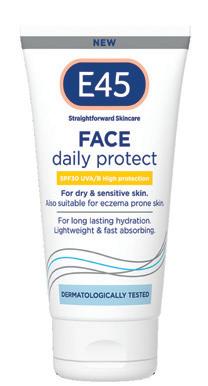
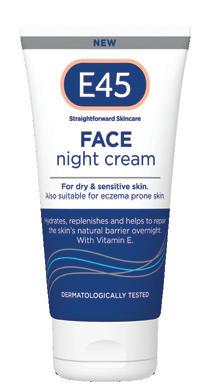
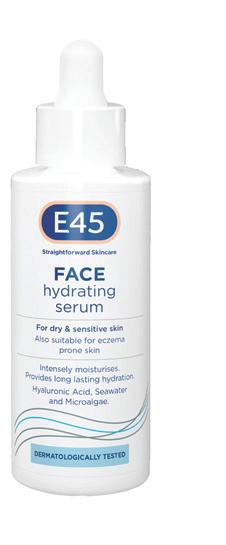
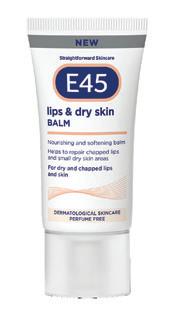
01 296 8080 | orders@oceanhealthcare.ie www.oceanhealthcare.ie

the treatment of psoriatic arthritis and psoriatic nail disease. Methotrexate has multiple contraindications including pregnancy, alcoholic liver disease or other chronic liver disease, immunodeficiency syndromes, bone marrow hypoplasia, cytopaenias, or hypersensitivity to methotrexate. Relative contraindications include liver and renal function abnormalities and active infection. In addition, concomitant treatment with certain drugs (eg, nonsteroidal anti-inflammatory drugs, certain antibiotics) can increase risk for methotrexate toxicity. Regular monitoring is essential due to potential liver and bone marrow side effects. Methotrexate is usually administered in an intermittent low-dose regimen such as once weekly, orally or subcutaneously. The usual dose range is between 5 and 25 mg per week. Subcutaneous methotrexate can be used and may be helpful when doses higher than 15 mg/week are needed, as hepatic metabolism
may limit the bioavailability of higher methotrexate doses. Unlike ciclosporin, which is generally used for only a limited duration of treatment because of cumulative renal toxicity, methotrexate can be used for long-term therapy.
Folic acid is co-prescribed to protect against some of the common side effects seen with low-dose methotrexate such as stomatitis. Concurrent use of other medications that interfere with folic acid metabolism, such as sulfa antibiotics, can increase the toxicity of methotrexate.
Ciclosporin
Ciclosporin suppresses T cell activity, reducing inflammation. Usual doses are 3-5mg/ kg/day divided twice daily. Contraindications to ciclosporin therapy include abnormal renal function, uncontrolled hypertension, malignancy, and hypersensitivity to cyclosporine. Caution is indicated in the setting of major infections or poorly controlled diabetes. Cyclosporine also has multiple drug interactions. Ciclosporin is reserved for shortterm use due to potential kidney damage with prolonged use.
Acitretin
Acitretin is a retinoid (vitamin D derivative) taken orally, which regulates skin cell growth. Acitretin is particularly useful for patients with pustular psoriasis or in patients with a history of immunodeficiency or neoplasia. Acitretin can be combined with UVB or PUVA. The usual dose range is 10-25mg daily and the onset of action is relatively slow. Monitoring for hypertriglyceridemia and hepatotoxicity are required with retinoid therapy. Common side effects include cheilitis and alopecia. Acitretin is teratogenic; it is only indicated in men and in women of nonreproductive potential. Pregnancy is contraindicated for three years after discontinuing the drug.
Apremilast
Apremilast, a phosphodiesterase 4 inhibitor, is another oral agent for the treatment of plaque psoriasis. PDE4 inhibition reduces production of multiple cytokines involved in the pathogenesis of psoriasis. Apremilast is costly, priced closer to biologics than to methotrexate. The drug can also be effective for psoriatic arthritis.
Apremilast is associated with a short-term risk of diarrhoea, especially when treatment is started, occurring in roughly 15 to 20 percent of patients. Tolerability of apremilast is improved by slowly ramping up the dose when treatment is initiated. In adult patients with severe renal impairment, the recommended final dose is 30 mg once daily. At the start of therapy, only the morning dose of the above titration schedule is given. Examples of other reported side effects of apremilast include nausea, upper respiratory infection, headache, drug interactions, and weight loss. Periodic monitoring of weight is recommended. Advising patients, their caregivers, and families to be alert for worsening depression, suicidal thoughts, or other mood changes during treatment also is suggested based upon the possibility of a slight increase in risk for depression.
Fumaric acid esters
Fumaric acid esters (fumarates) are frequently used to treat psoriasis in Germany. Lymphopenia is an occasional side effect of treatment with
PHARMACYNEWSIRELAND.COM
Educational Learning
52
Figure 3
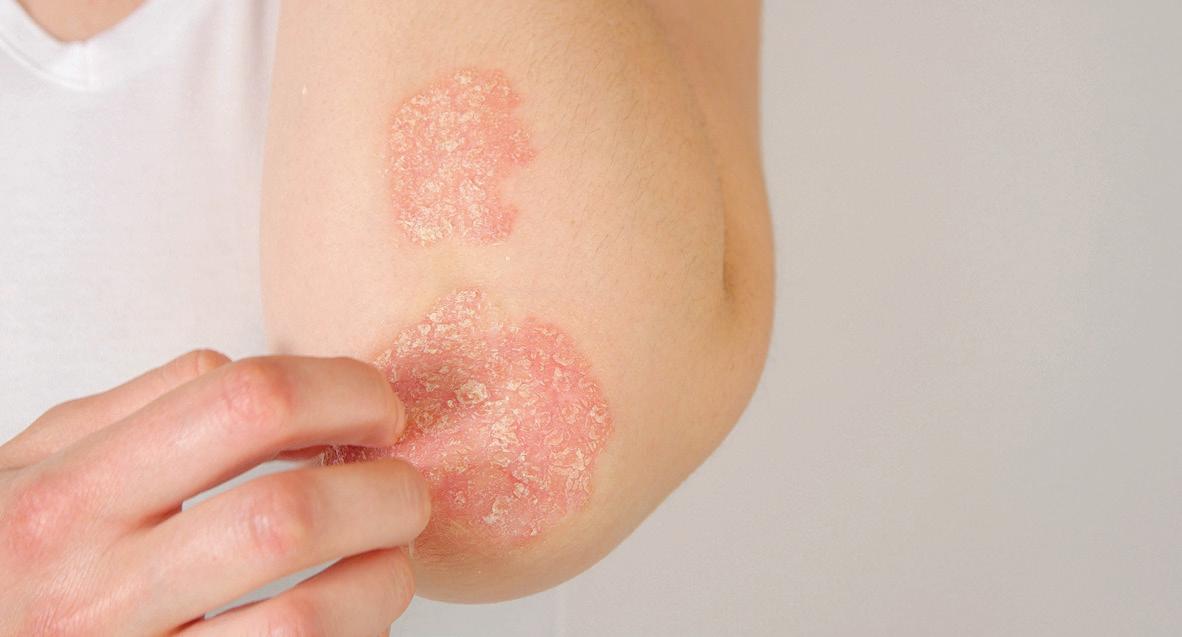
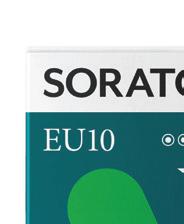
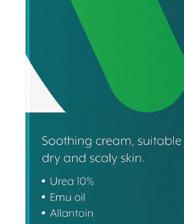
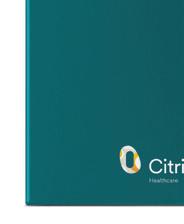


• Urea 10%
• Emu Oil

• Allantoin

• Urea 30%
• Mandelic Acid
• Allantoin













www.citrinehealthcare.com | Tel: 01 445 7206 Protect the skin you’re in Targeted skin care for dry and fl aky skin. 1 00% I R I S H OWNE D 1 %00 I R I S H ENWO D
54 Educational Learning
fumaric acid esters. In 2013, two cases of progressive multifocal leukoencephalopathy (PML) were reported in patients who continued to receive long-term fumaric acid ester therapy despite the development of severe lymphopenia. These patients did not have other known causes of immunodeficiency. PML in the setting of fumaric acid therapy for psoriasis has also been reported in patients without severe lymphocytopenia.
Biologics
Biologics are different from conventional systemic drugs that impact the immune system more globally. Biologics target highly specific parts of the immune system. The biologics used to treat psoriatic disease block the action of specific types of proteins in the immune system, such as tumor necrosis factor-alpha (TNF-alpha), interleukin 17-A, or interleukins 12 and 23 (Figure 3). These cells and proteins all play a major role in developing psoriasis and psoriatic arthritis.
TNF-alpha Inhibitors
Tumour necrosis factor alpha (TNF-alpha) inhibitors, such as etanercept and adalimumab, target specific immune system proteins involved in psoriasis. Other examples include certolizumab which is pegylated (and therefore does not cross the placenta) and infliximab (which is administered intravenously). Biosimilars are now available for etanercept, adalimumab, and infliximab, which have dramatically reduced their cost. TNF inhibitors are effective for both skin lesions and joint symptoms in psoriatic arthritis, and can be used to treat inflammatory bowel disease in patients who have comorbid disease.
IL-12/23 inhibitor
Ustekinumab is a human monoclonal antibody that targets IL-12 and IL-23. Ustekinumab is indicated for the treatment of adults and children with moderate to severe psoriasis who are candidates for phototherapy or systemic therapy. Dosing of ustekinumab is weight based. Standard dosing for ustekinumab for adults ≤100 kg is 45 mg given at weeks 0, 4, and every 12 weeks thereafter. A 90 mg dose given in the same regimen is recommended for adults who weigh more than 100 kg. Ustekinumab can also improve psoriatic arthritis.
IL-17 Inhibitors
Drugs like secukinumab and ixekizumab target interleukin-17, a protein implicated in psoriasis.
These agents are effective for individuals who do not respond well to other treatments, and are typically used as secondline agents after TNF inhibitors or ustekinumab. IL-17 inhibitors can rarely be associated with candidiasis and new-onset inflammatory bowel disease.
IL-23 Inhibitors
Guselkumab risankizumab, and tildrakizumab are examples of medications that target interleukin-23 by binding to the p19 subunit.
Novel/Emerging agents
Newer agents for psoriasis include other biologic targets and janus kinase inhibitors
Personalized Treatment Plans
The management of moderate to severe psoriasis requires a personalized approach, taking into account the patient's overall health, lifestyle, and preferences.
Lifestyle Modifications
Encouraging patients to adopt a healthy lifestyle can complement medical treatments. Smoking cessation, weight management, and stress reduction are important aspects of managing psoriasis.
Regular Monitoring
Patients undergoing systemic treatments require regular monitoring of liver function, blood cell counts, and other relevant parameters. Close communication between healthcare providers and patients is essential to address any emerging concerns promptly.
Assessing Comorbidities
Psoriasis is associated with an increased risk of cardiovascular diseases, diabetes, and other systemic conditions. Dermatologists often collaborate with rheumatologists when joint involvement is present, ensuring a comprehensive strategy for addressing both skin and joint symptoms.
Combination Therapies
Dermatologists may opt for combination therapies, such as using a biologic alongside a topical treatment for enhanced efficacy. This approach aims to achieve better control of psoriasis while minimizing potential side effects.
Patient Education and Support
Educating individuals with psoriasis about their condition is crucial for empowering them to actively participate in their treatment. Patient support groups, online forums, and educational
resources can provide valuable information and a sense of community for those navigating the challenges of moderate to severe psoriasis.
Managing Emotional Well-being
The visible nature of psoriasis lesions can significantly impact an individual's self-esteem and mental health. Mental health support, counseling, and resources can help patients cope with the emotional aspects of the condition.
Adherence to Treatment
Ensuring patient adherence to prescribed treatments is vital for achieving optimal outcomes. Understanding the importance of consistent treatment and addressing any concerns or barriers to adherence is essential.
Test your Learning
Conclusion
The treatment landscape for moderate to severe psoriasis has evolved significantly, offering a range of options tailored to individual needs. From traditional therapies like topical treatments and phototherapy to advanced biologics targeting specific immune pathways, dermatologists have a diverse toolkit to address this challenging condition. A holistic approach that considers the patient's overall health, lifestyle, and emotional well-being is essential for comprehensive psoriasis management. With ongoing research and advancements in treatment modalities, the outlook for individuals with moderate to severe psoriasis continues to improve, providing hope for better control of symptoms and an improved quality of life.
1. Which of the following conditions is psoriasis not associated with increased risk of?
A Inflammatory bowel disease
B Inflammatory arthritis
C Intellectual disability
D Depression
E Cardiovascular disease
2. Which of the following is an indication for referral to dermatology for specialist care of psoriasis?
A Strong family history of autoimmune disease
B Greater than 10% body surface area involvement
C Presence of extensor limb involvement
D Failure to respond to emollient therapy
E Joint swelling without evidence of skin changes
3. Which of the following is not a contraindication to methotrexate therapy?
A Cytopaenia
B Renal failure
C Fatty liver disease
D History of major cardiovascular event
E Alcoholic liver disease
4. Which of the following is not a tumour necrosis factor alpha inhibitor?
A Infliximab
B Secukinumab
C Etanercept
D Adalimumab
E Certolizumab
5. Which of the following tests should be performed before starting a patient on a biologic agent for psoriasis?
A Thyroid function tests
B Varicella IgG levels
C Fasting lipid levels
D HIV viral load
E Hepatitis E serology
PHARMACYNEWSIRELAND.COM
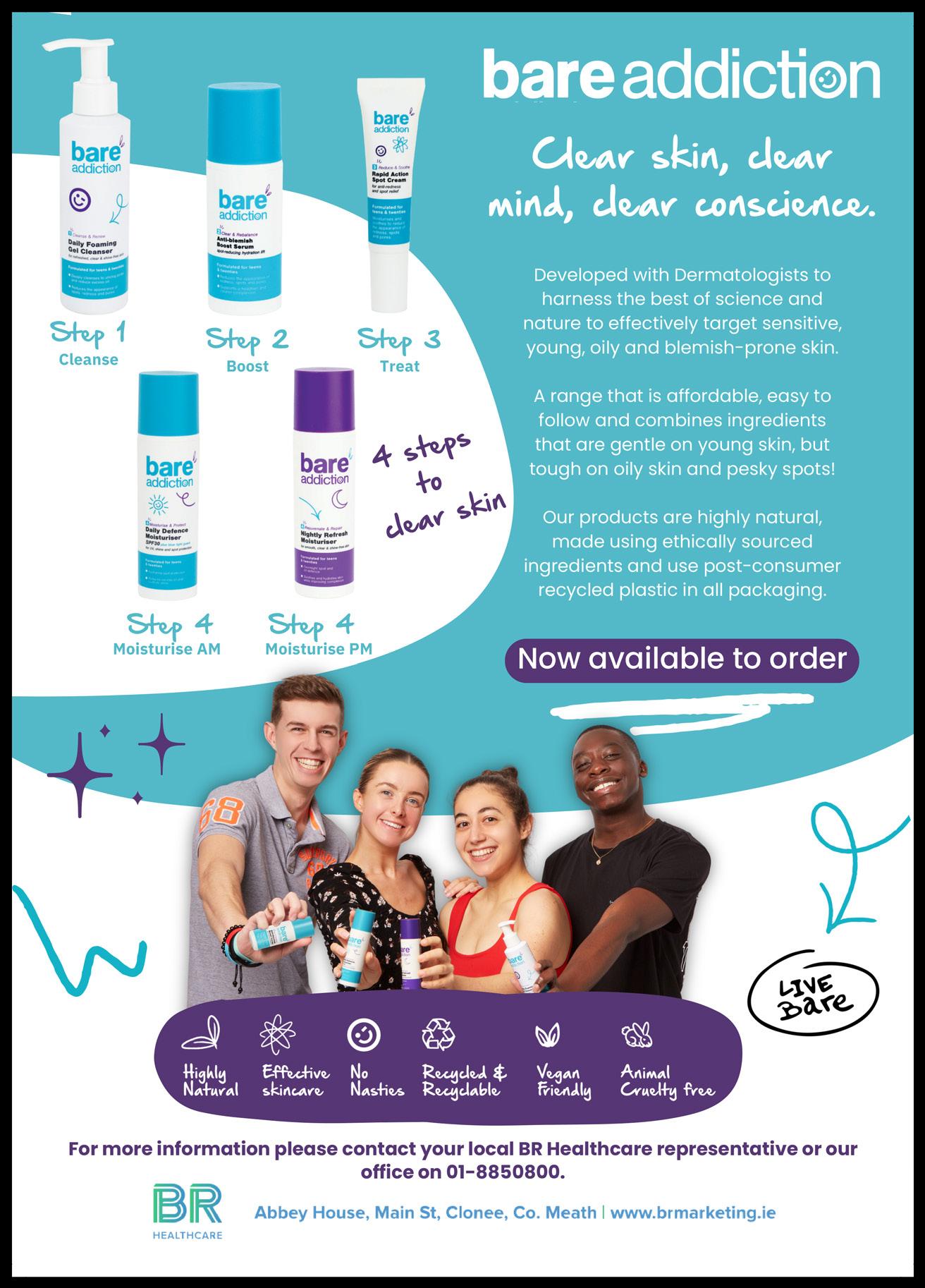
Hay Fever
The Disruptive Effects of Hay Fever
With Easter just passed, and everyone having eaten copious amounts of chocolate whilst taking the kids out for Easter Hunts, it is important to remember that this time of year isn’t so pleasant for everyone.

As hay fever season began, the Asthma Society surveyed 1,274 people in Ireland about their asthma and/or hay fever. Of those surveyed with hay fever (727), 76% said that it limits their or their child's daily activities and has a disruptive effect on their lives. Additionally, 42% of people surveyed reported missing at least one day of work or education due to hay fever in the past year, with one in five missing more than three days.
Almost half (47%) of those surveyed believe hay fever is not taken seriously by their friends or family. Furthermore, 44% of respondents don’t think healthcare providers take hay fever seriously, and 75% feel the same about policy-makers and politicians.
Professor Patrick Mitchell, a respiratory consultant physician at Tallaght University Hospital and member of the Asthma Society of Ireland’s Medical Advisory Group, commented on the findings,
saying, “While most of us are enjoying the first signs of Spring, others are facing into months of the headaches, runny noses and sore throats associated with hay fever season.
“The results of our recent survey underscore the disruptive and often unrecognised effects of allergic rhinitis, or hay fever, on people’s quality of life, with three-quarters of the respondents reporting that their daily activities are limited by their symptoms.”
Professor Mitchell warned that, allergic rhinitis can pose particularly serious health risks for people with asthma. Over 450,000 people in Ireland have asthma, and allergic rhinitis can trigger asthma symptoms, like coughing and shortness of breath, and even an asthma attack. It can also be a risk factor in developing asthma. Often antihistamines and, if needed, steroidal nasal sprays will relieve symptoms.
Professor Patrick Mitchell, Respiratory Consultant Physician at Tallaght University Hospital
Treatment for more persistent allergic rhinitis is also available, with sublingual immunotherapy (SLIT) proving particularly effective. Frustratingly for healthcare professionals and patients, though, Ireland has yet to approve SLIT for reimbursement, which presents a cost barrier to effective care. Missing school and work due to allergic rhinitis can reduce people’s immediate and future earning potential. These lost days also have implications for the wider economy. There is an onus on Irish policy-makers to catch up with the rest of Europe and make effective treatment more accessible.
Typical symptoms of seasonal hay fever and perennial allergic rhinitis include but are not limited to:
• Sneezing, as well as an itchy, blocked, or runny nose
• Red, itchy, or watery eyes
• An itchy throat, inner ear, or mouth
• A post-nasal drip
• A diminished sense of taste and smell
• Headaches, reduced concentration and general feeling unwell
A combination of medical and lifestyle advice can help people manage hay fever symptoms. Appropriate medications can be accessed through your pharmacist or GP.
Ruth Morrow, a Respiratory Nurse Specialist at the Asthma Society, said, “Typical symptoms of seasonal hay fever and perennial allergic rhinitis include sneezing, itchy or blocked nose, watery or itchy eyes, sore throat, post-nasal drip, and headaches. Pollen and dust levels are rising as the planet warms and hay fever season is getting longer. From the substantial numbers contacting me through our patient services and attending our webinars every year, it is clear that people are struggling with their symptoms.”
Ruth offers these practical tips for managing hay fever and allergic rhinitis symptoms and reducing the impact of pollen and dust on respiratory health.
• Keep doors and windows closed when the pollen count is high.
• Avoid exercising outside when the pollen count is high, and wear a cycle mask when cycling.
• Shower, wash your hair and change your clothes if you have been outdoors for an extended period.
• Wear wraparound sunglasses to prevent pollen from getting in your eyes, and splash your eyes with cold water to flush out pollen and soothe them.
• Avoid drying clothes outdoors because pollen spores may cling to them.
• Try to stay away from grassy areas and avoid mowing the lawn, as clouds of pollen can be created. Consider creating an allergy-friendly garden.
• Minimise contact with pets that have been outside, as pollen can linger on their fur.
• Keep your car windows closed when driving. Some cars can be fitted with a pollen filter.
• Apply a barrier gel/spray to the nostrils to prevent pollen from settling in the nose.
• If drying clothes outdoors, shake clothes to remove pollen spores before bringing them indoors and to put them in the airing cupboard before use.
• Discuss the use of treatments for hay fever with your pharmacist or GP.
• For those with asthma, make sure you have a personalised Asthma Action Plan. An Asthma Action Plan sets out the steps each patient needs to take to stay well with asthma and how to manage flare-ups when they happen. It should be filled out by a GP, nurse or consultant and reviewed regularly. These are available from your healthcare professional or can be downloaded from www.asthma.ie.
• One in five people reported that they or their child had missed more than three days of work or education in the past year.
• 42% of those surveyed stated that they or their children had missed at least one day of work or education due to hay fever in the past year.
• 75% of those surveyed don’t believe policymakers and politicians take hay fever seriously.
PHARMACYNEWSIRELAND.COM 56


CETIRIZINE DIHYDROCHLORIDE
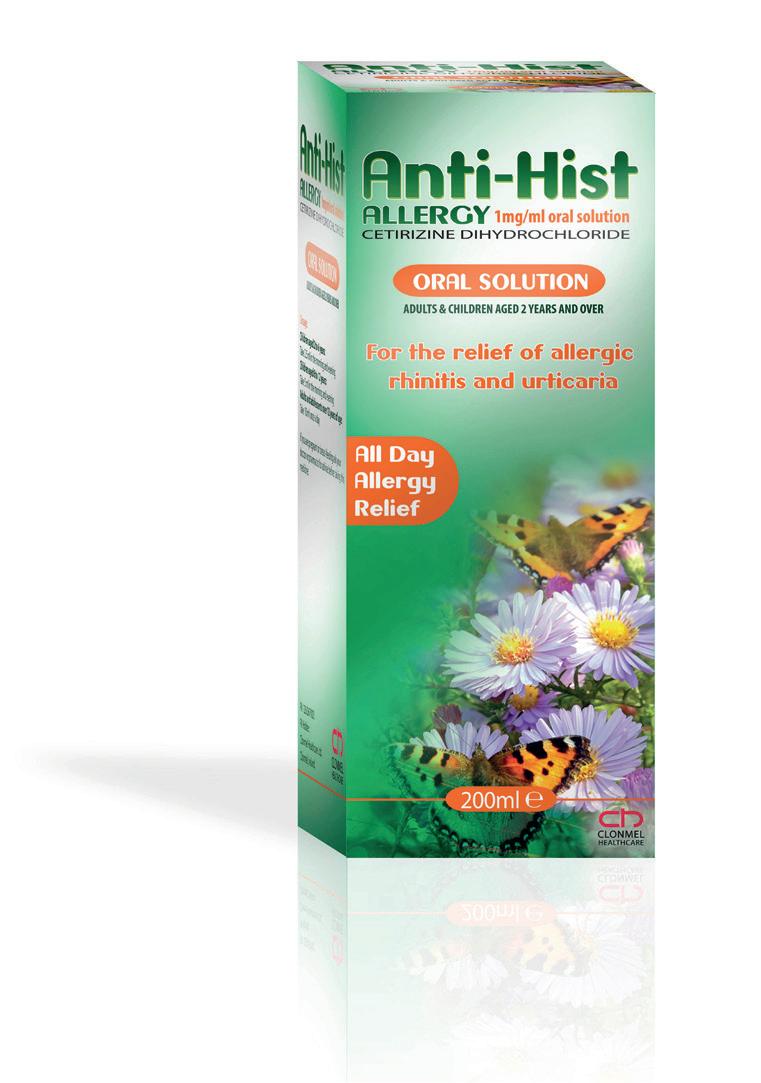




Clearing ...to
a brighter day
For relief of symptoms of hay fever and other allergic conditions, skin rashes or itchy, watery eyes.
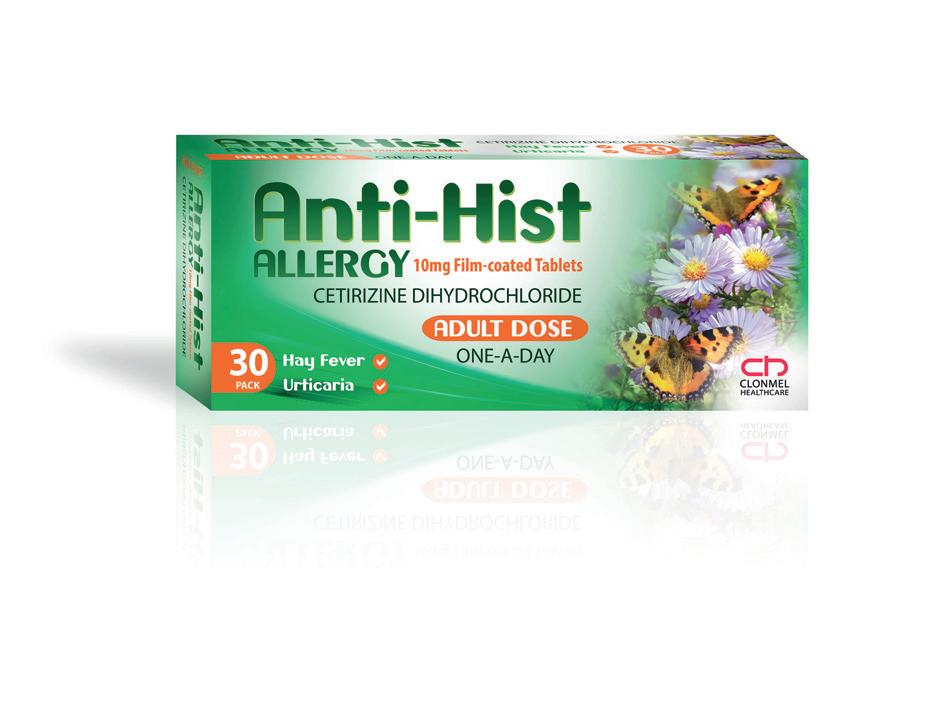



Contraindications: Hypersensitivity to the active ingredient, any of the excipients, hydroxyzine or to any piperazine derivatives. Patients with severe renal impairment at less than 10ml/minute creatinine clearance. For supply through pharmacies only. A copy of the summary of product characteristics is available upon request. PA 126/267/1-2. PA Holder: Clonmel Healthcare, Waterford Road, Clonmel, Co. Tipperary. Date prepared: July 2022. 2022/ADV/ANT/188H









OTC Counter Assistant of the Year Award 2024 Awards 2024
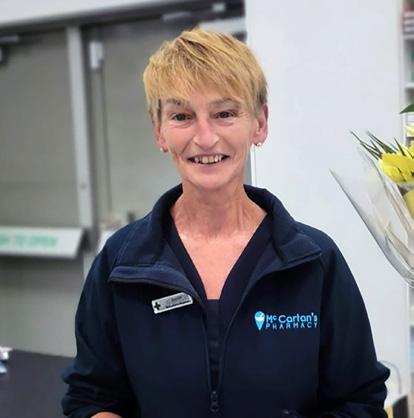
Bernie Walsh, McCartans Pharmacy, Maynooth
Bernie has worked in the pharmacy for over 40 years and in McCartans Pharmacy Maynooth store for over 35 years. She plays such a fundamental role and backbone for support to not only her colleagues but to the local community of Maynooth having built lasting friendships and connections.
She plays a integral role in the pharmacy and is a huge team player and with any new staff members that have come through over the years she has always mentored and trained them. She is a extremely compassionate and helpful person and has been delivering outstanding customer service to the local community.
Shauna McElligott, LloydsPharmacy, Jetland
Shauna has been with LloydsPharmacy Jetland for 5 years as an OTC Assistant and was recently promoted to Assistant Manager this past December.
Shauna’s diverse background in the hospitality industry has enriched her approach to customer service. Her experience in various management roles, particularly in frontof-house concierge services, has honed her ability to care for customers. Shauna’s commitment to excellence shines through her favourite saying: “The customer should always feel good on their departure.” She consistently provides first-class service, ensuring that every interaction leaves a positive impression.

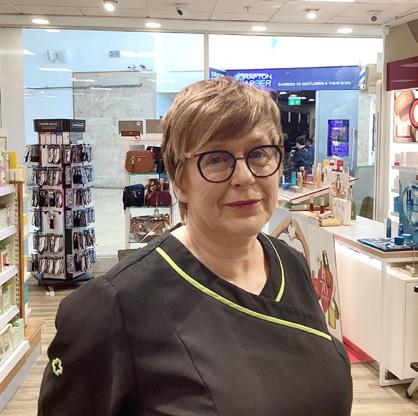
Maria's kindness and attentiveness shine through in every interaction. Her ability to brighten someone's day with a joke or a thoughtful recommendation is truly remarkable. She goes above and beyond to make sure those around her feel valued and supported. Maria's genuine interest in others and her willingness to help truly make her a special and cherished individual.
Maria's dedication to her role is truly inspiring. She exudes passion and brings a vibrant energy to the dispensary, making it a welcoming place for all to work in. Maria works so well with others, supporting the pharmacists and her enthusiasm for implementing positive changes is infectious, driving improvements in store layout, product selection, and service quality for our valued customers.
58 | PHARMACYNEWSIRELAND.COM
Irish Pharmacy Finalists Finalists
The
Maria Kennedy, Meaghers Pharmacy Kinvara
Jenny Percival, Ryan’s Pharmacy, Derrinturn
Jenny Percival has had a huge impact on her pharmacy team and the community. It is very clear immediately that Jenny goes above and beyond time and time again. Nothing is too much of an ask or too far beyond Jenny’s reach. Her pharmacy in Derrinturn is treated with so much love and attention.
To many customers, Jenny is a counsellor, a friend to listen, a source of valuable healthcare information, a “free” courier service, an out of hours point of contact, always someone to have a joke and a laugh with to brighten your day, a personal shopper, a trusted salesperson, a forward planner/budgeter (ringing customers to tell them something they might like has come in, noticing them that a sale is about to happen), a first aider, the main point of contact even for their dispensary related queries, a mother figure.
For pharmacy staff members, a counsellor, a listener, a minder, mother like figure, a manager, a mentor, a huge support to all staff members, a driver of business, a delivery woman, a mediator, a baker, helping the gardai with all their CCTV queries.

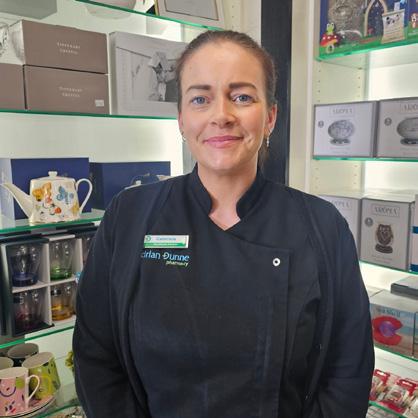
Cathriona is an exemplary Health Care Advisor within the Adrian Dunne Rush pharmacy team, where she has been making significant contributions since joining in 2023. With a comprehensive background in healthcare, including respite and palliative care, Cathriona brings over a decade of experience in patient-centred service to her role. Her qualifications are extensive and include FETAC certification in healthcare, along with qualifications in crisis prevention, first aid, and medication administration.
This diverse skill set enables her to provide expert advice on a wide range of healthcare and skincare topics, over-the-counter medications, and supplements, ensuring that patients receive the most informed and compassionate care possible.
Tara McKenna's long-standing service, broad experience, and formal qualifications in the pharmacy sector, along with her role as Pharmacy Supervisor at Mark's Pharmacy, make her an outstanding nominee for the Counter Assistant of the Year Award. Her commitment to customer care, her ability to manage a wide array of pharmacy responsibilities, and her seamless collaboration with her colleagues and the local community, all attest to her excellence in the field.
Tara embodies the qualities of an exceptional counter assistant – leadership, innovation, commitment to customer care, and operational efficiency. Her efforts have not only enhanced the functioning of Mark's Pharmacy but also significantly improved the customer experience.

PHARMACYNEWSIRELAND.COM | 59
Cathriona Cullen, Adrian Dunne Pharmacy, Rush
Tara McKenna, Mark’s Pharmacy, Ardee
The Irish Pharmacy









Haleon Self-Care Award 2024 Awards 2024

The team in Village Pharmacy expertly led by Nikki the manager who has been instrumental in making the local community healthier in driving this initiative deserves recognition for all the hard work, commitment, and dedication in making this store as successful as it is. As is commonly known no one person makes the dream work and the girls have always been there encouraging and supporting all events and promotions and continually striving to educate themselves by attending various courses and instore training.
This store was the first Chemist Warehouse pharmacy established in Ireland and after three years of growth, it was decided to move location to a bigger, brighter, brand new store. One of the key drivers behind this was to ensure we could facilitate increased footfall, increased prescription numbers and increased interactions between the pharmacy team and their patients. The Blanchardstown team have now set the bar for all the other Chemist Warehouse stores and the bar has been set high. Their engagement with their community and their commitment to patient care has ensured that the other pharmacies want to get on board and produce the same results in their store.






















Mark’s Pharmacy, Ardee

Blanchardstown pharmacy is at the heart of the community and the team consider themselves the pillar of local society, giving customers 110% of everything they do.
Since Covid, they have been faced with many new challenges and had the opportunity to transform the way they support and engage with patients. They provide regular home deliveries for medicines, as well as, everyday support, like food shopping. Stemming from Covid, many patients continue to struggle to leave their home, this pharmacy team pride themselves on being an added support lever for these patients. Implementing these changes have led them to be more efficient and customer centric.They have joined the vaccination team, becoming a hub for Covid, Shingles & flu vaccines. This has fulfilled the needs of many elderly patients who could not travel to vaccination centres.
Mark's Pharmacy in Ardee represents the essence of community healthcare, embodying exceptional service, innovation, and a deep-rooted family ethos. Situated in the heart of Ardee, a town renowned for its community spirit and historical richness, the pharmacy has become a pivotal part of the local fabric.
Mark's Pharmacy consistently introduces advanced healthcare solutions tailored to the evolving needs of the Ardee community. From managing chronic conditions to wellness advice, their initiatives reflect a proactive and empathetic approach to health and wellness.


The team in Spooner’s CarePlus Pharmacy recognised a lot of the same general health and wellness needs coming up among their customers coming into the pharmacy. Supervising Pharmacist Shaunagh Galgey felt as though the community could benefit from a pharmacy service that would check the customer for a number of these different health issues that she noticed coming up a lot, with advice offered at the end based on your results.
The goals set by the pharmacy were to educate their customer base on their own health status by offering these services, while also offering advice on how to improve any issues that did arise.
60 | PHARMACYNEWSIRELAND.COM
Finalists
Finalists
Chemist Warehouse, Blanchardstown
Introducing...
Village Pharmacy, Carlingford
MGK9299 Haleon Trade Ads.pdf 1 10/08/2022 14:58
Haleon, formerly part of GSK
LloydsPharmacy, Blanchardstown
Spooner’s CarePlus Pharmacy, Templogue




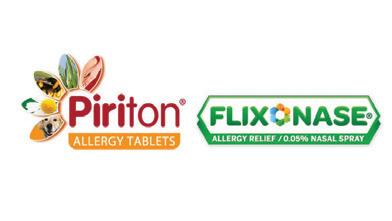

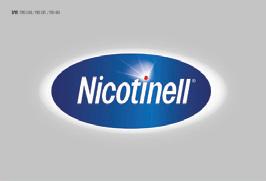

























Introducing...
Haleon, formerly part of GSK
The Irish Pharmacy










Easolief DUO Business Development (Chain) Award 2024 Awards 2024
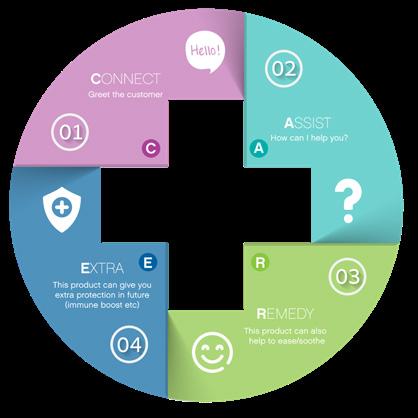
This development initiative was called the CARE campaign, developed in Head Office and rolled out across the CarePlus Pharmacy network. The challenges the CARE campaign tackled were customer service improvements in pharmacy, stagnant sales and margin, and the lack of product training knowledge in the wider pharmacy team. The CARE campaign was created into an easy to follow graphic which was made available to all stores and provided in the training packs that came along with the campaign.
This project serves as a fantastic initiative which was designed to benefit both the pharmacies within the CarePlus network and the communities they serve, so it was a two pronged approach in order to benefit everyone involved.
The enthusiasm with which the pharmacies took the CARE campaign and the training on board and executed it in their pharmacies was very admirable, and it resulted in fantastic increases in both sales, margin and customer satisfaction overall.
The main objective of this initiative was to create a Pharmacy Vaccination Service utilising all levels of the pharmacy organisation that would provide an exceeding level of care to the community, particularly for those who are at risk.
This includes patient safety but also extending to patient comfort, striving to ensure that all capabilities are satisfied for each individual. Providing an area safe from transmission of the general public and also providing deserving comfort and care ensured that the community could be provided vaccinations which in turn benefit the entire community.

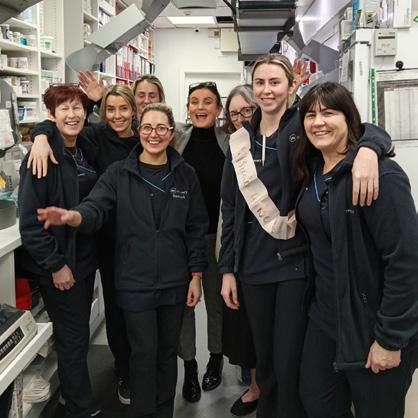
Seeing a gap in the pharmacy market, TCP pharmacy developed a system in 2024 to capture pharmacy clinical interventions. The clinical intervention system allows the pharmacy team to trend and highlight the pivotal role pharmacists play and our impact on patient safety. The system is used to record all pharmacy recommendations in terms of prescribing excellence and the optimization and safe use of medicines.
TCP has demonstrated our commitment to providing outstanding and exceptional care to their patients by designing and implementing a clinical intervention tool, which has patient safety at its core.
62 | PHARMACYNEWSIRELAND.COM
Finalists Finalists
TCP Pharmacy, Dublin CarePlus Pharmacy Group
Newpark Life Pharmacy, Kilkenny






The Irish Pharmacy Finalists Finalists



BOI Payment Acceptance (BOIPA) Innovation & Service Development (Chain) Award 2024 Awards


Genecheck is an innovate testing service which allows the pharmacy team at Pure Pharmacy to test a persons genetic response to prescribed medicines using pharmacogenomics. It is the first of its kind to be offered in Ireland and more importantly in community pharmacy. It is the future of healthcare as it allows patient (and Doctor) to analyse a patient's response to commonly prescribed medications using their DNA allowing for personalised prescribing. This service eliminates guess work during early stages of prescribing in the sense that if a patient does not suitably respond or metabolise a particular medication efficiently or successfully.
David Beggs, Pure PharmacyWarehouse
Dun Laoghaire
TCP pharmacy developed a system in 2024 to capture pharmacy clinical interventions. The clinical intervention system allows the pharmacy team to trend and highlight the pivotal role pharmacists play and their impact on patient safety. The system is used to record all pharmacy recommendations in terms of prescribing excellence and the optimisation and safe use of medicines. TCP has demonstrated their commitment to providing outstanding and exceptional care to patients by designing and implementing a clinical intervention tool, which has patient safety at its core.


Meaghers Pharmacy Group have introduced the Pharmacy 360˚ project across all 10 Meagher’s Pharmacies in Dublin, focusing on how they can support their customers in integrative health. The aim of the Pharmacy 360 project is to adopt a holistic approach to health in the pharmacy setting, encompassing lifestyle medicine, conventional medicine, and complementary therapies. To take a 360˚, whole-bodied approach to a person’s health, combining all aspects of treatments from lifestyle medicine to conventional medicine, to suitable complementary & alternative therapies.
The team behind Navi Group and CarePlus Pharmacy have created DispenSense, a cloud-based pharmacy management solution that is the first of its kind in Ireland.
Designed to enhance the efficiency of pharmacy operations while simultaneously improving patient care, the system's robust architecture ensures that dispenSense is not just a software solution, it is a catalyst for positive change within the pharmacy landscape, setting a new standard for resilience and efficiency in pharmacy management.
This cutting-edge software strives to make dispensing reliable, safe and efficient, empowering teams to overcome everyday challenges.

PHARMACYNEWSIRELAND.COM | 63
2024
TCP Pharmacy
Meaghers Pharmacy Group
CarePlus Pharmacy/Navi Group
Dublin
Pure Pharmacy









United Drug Business Development (Independent) Award 2024 Awards 2024

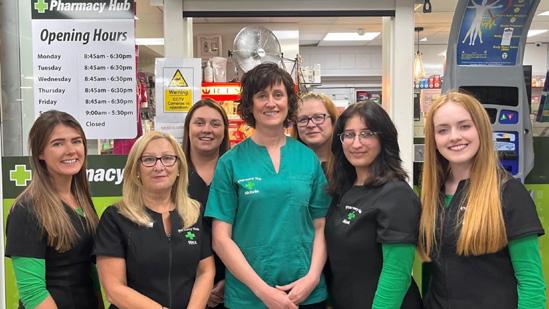
Newtownpark Pharmacy, Blackrock
When deciding to investigate new ways of working, following staff meetings, market research, a customer survey and financial considerations, the team at Pharmacy Hub Killinarden decided collectively to introduce a new Pharmacy APP. It was deemed that this would be a perfect solution to meet the ever growing business needs.
The team have taken a leap introducing the Pharmacy App and committing to financial investment for their future. It strengthens and demonstrates the vision they have as an independent Pharmacy to listen to their customers and reach standards of excellence, innovate ways to improve their service and grow the business. The team feels that the addition of the App shows how they invest in the Business and this gives them confidence to grow with the business and access training.
Newtownpark Pharmacy recently launched an app in 2023. Their patients can download the app and use it to order prescriptions, make payments and much more. The app also serves as a user-friendly platform for ordering, storing patient information, engaging in two-way communication, processing payments, and managing deliveries.
Newtownpark Pharmacy are a strong, focused team with customer satisfaction at the heart of everything they do, hence the thinking behind launching a patient focused app, to make life easier for their patients and therefore also for their team.

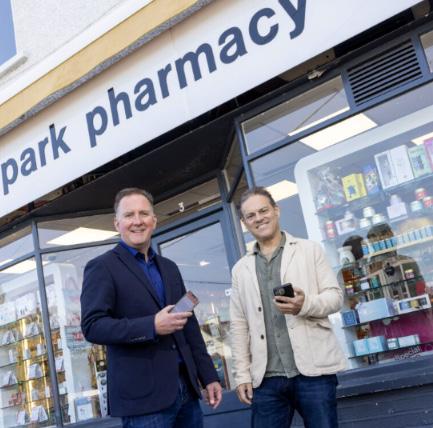
North Road Pharmacy came up with a unique and different to idea by opening a Sports Department instore and targeting the individuals who wanted to improve or even begin the road to an active and healthy lifestyle. This proved and is continually proving to display that this was the right decision for the pharmacy.
North Sports is a one-of-a-kind department within North Road pharmacy which is unique to pharmacy throughout the country and boasts its uniqueness. They stock a wide range of sports equipment, accessories, and sportswear. It bridges the gap between healthy wellbeing and an active lifestyle. North Road are the first and only pharmacy nationwide to include a sports section.
64 | PHARMACYNEWSIRELAND.COM
Finalists
The Irish Pharmacy
Finalists
North Road Pharmacy, Drogheda Pharmacy Hub, Killinarden









Uniphar Training & Development Award 2024 Awards


The management team with Adrian Dunne Pharmacy, Trim are huge believers in the value of quality training for all colleagues. They believe their colleagues should be experts within their own role and where possible cross-trained for other roles and departments to enhance the customer experience. They provide a service that is personable, efficient and one that goes the extra mile for their customers. To achieve that, training is key. They feel training and development has been hugely important for them to retain their team, ensuring they are engaged and motivated to perform.
In order to sustain and future proof Chemist Warehouse, the pharmacy management team have developed an Intern Training Programme for their 5th Year Interns, that not only helps the interns fulfil their competencies as set by Appel, but also exposes them to all areas of the pharmacy business, with the aim of producing highly skilled and confident pharmacists who will have the tools necessary to walk into any new store and help build it from scratch.


Over the course of the last year or so, Donaghmede has moved from a pharmacy where training was seen as more of a chore, to a team environment where everyone is looking to grow their skillset and individual development goes hand in hand with the business growth. The two senior pharmacists both went through their IIOP CPD cycles, with the other pharmacists supporting them on this. All of the pharmacists received vaccination training and this has led to a dramatic increase in vaccine numbers. Everyone working in the pharmacy knows that they are valued and supported. They are encouraged to look for career development, and to seek out the skills to not only do their job, but to stretch themselves to develop further.
Newtownpark Pharmacy launched its branded app with fintech company PharmacyConnect, aiming to streamline communication and support every step of the patient pharmacy journey. The PharmacyConnect app facilitates Healthmail, prescription collection and payment, and serves as a userfriendly platform for ordering, storing patient information, engaging in two-way communication, processing payments, and managing deliveries.


Amidst the challenges presented by the current healthcare landscape and the transition to remote work due to the COVID-19 pandemic, the pharmacy team at TCP Homecare recognised the imperative requirement for a fresh and sustainable approach to training and development within the team. Their conventional manual systems became unsustainable in this evolving environment, prompting them to embark on a journey of digital transformation and innovation. Thus, the conception of their Learning Management System (LMS) emerged.
PHARMACYNEWSIRELAND.COM | 65
2024 The
Irish Pharmacy Finalists Finalists
Jenny Hynes, Pharmacist, Chemist Warehouse Dun Laoghaire
Chemist Warehouse, Dun Laoghaire
Adrian Dunne Pharmacy, Trim
Donaghmede Pharmacy, Donaghmede
TCP Homecare, Dublin
Newtownpark Pharmacy, Blackrock
Awards 2024











Alliance Community Pharmacy Technician of the Year Award 2024
Caitriona is described as a ‘powerhouse’ since she has started working with McCauley Pharmacy. She has gone from strength to strength displaying what can only be described as an outstanding work ethic in the most professional way. She uses her education and knowledge of Pharmacology in such an efficient and impressive way it is inspiring to others, to follow her lead. She displays excellent technical skills while dispensing and follows it up with such organization and problem solving it enables the dispensary to function at a high standard. Her attention to detail in relation to drug reactions / side effects/ dosage calculations / drug classifications knowledge is very extensive.
As a pharmacy technician dedicated to serving her community, Nicoleta has consistently demonstrated a passion for patient care, a commitment to professional development, and a drive to innovate and improve pharmacy services. Her contributions extend beyond the pharmacy counter, as she actively engages with patients, collaborates with colleagues, and seeks opportunities to enhance the quality of care provided.
Nicoleta is described as someone who has an unwavering dedication to patient care. She understands that each patient is unique and deserving of personalised attention and support. Whether it's assisting them with medication inquiries, providing health screenings, or simply lending a compassionate ear, she prioritises building trusting relationships with every individual who walks through the pharmacy doors.

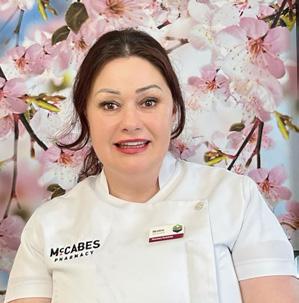
Emily is currently working as part of a busy and dynamic Dispensary team. She is a vital part of The pharmacy team and has recently taken up a more senior role. She is eager to learn and is a keen student. Emily is at the end of her IPU Technician course and has excelled in every part of it. She is self-motivated and it is evident she enjoys learning about all aspects of a Pharmacy Technician’s role.
Her journey from a part-time employee to a lead technician underscores not just her commitment to her role but also her exceptional ability to grow, adapt, learn, and excel in the fast-paced environment of community pharmacy. She is forward thinking, dynamic and innovative. Her exceptional IT skills have directly contributed to the innovation and improvements in efficiency within the pharmacy.
Niamh Murphy, Meaghers Pharmacy, Ranelagh
As a technician in a store open 7 days a week Niamh has put special emphasis in implementing and maintaining a number of processes to ensure safety and efficiency within the dispensary. When a new locum visits Meaghers Ranelagh they often comment on the ease of work due to these systems. Niamh has a deep-rooted understanding of patient safety and the importance of effective communication in the dispensary with her pharmacist colleagues. Niamh has pushed her own limits allowed herself to grow and excel in her role all while knowing when to ask for help or guidance from her pharmacist colleagues.
Niamh also manages the everyday running of the processes that ensure the safe and efficient supply of medicines to a busy nursing home. Niamh has not only enhanced the efficiency of operations but also raised the standard of patient care to new heights.

66 | PHARMACYNEWSIRELAND.COM
Finalists Finalists
The Irish Pharmacy
Nicoleta Talos, McCabes Pharmacy, Glasnevin
Caitriona Mackey, McCauley Pharmacy, Carrick on Suir
Emily Ashmore, Adrian Dunne Pharmacy, Ashbourne
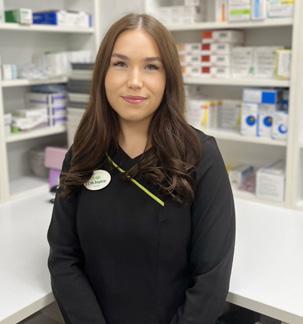
Sophie Boylan, LloydsPharmacy Nutgrove SC, Rathfarnham
Sophie is the head technician in LloydsPharmacy, Nutgrove Shopping Centre. She began the role in 2020 after successful completion of the Dispensary Assistant Programme and has gone from strength to strength since she joined the team. LloydsPharmacy Nutgrove is a customer focussed community pharmacy with an emphasis on providing a high-quality prescription and healthcare service to the local community.
Sophie is an example of a colleague that provides next-level patient care to the highest possible standard. She is a hardworking, ambitious and determined individual with a drive to succeed. She was nominated by her colleagues in 2023 for the Inspire award as part of the PHX Ireland awards and became a finalist. At 25 years of age, she has achieved what many others would hope to achieve over the course of their full career.
Ciara is a high energy, passionate and caring individual. She has become an integral part of the pharmacy for both staff and customers. She is a pharmacy technician and holds the position of dispensary manager. She is professional, highly dependable, motivating and forward thinking. She is a natural leader.
She has a positive approach to all tasks and has the ability to motivate others to achieve required outcomes. She recognises the needs of both staff and customers and engages to come up with a positive framework to encourage positive change. With staff she initiates staff meetings to discuss how the team can improve and actively welcomes staff feedback. She takes a lot of pressure off the pharmacist in a time where administration burden is high and demands are great.

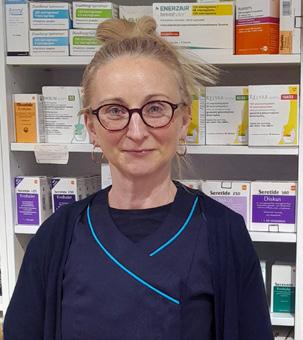
Daniela Haruta, Allcare Pharmacy, Drogheda
Daniela is diligent and infectious to work with. She is known personally to customers for her exceptional care and advice. She comes to work with a can-do attitude and she is always in great form which rubs off on all her colleagues. Speaking Romanian, Daniela is able to help many customers who speak that language and they personally look to speak to her.
She has an unbelievable reputation for her diligence with the claim and paperwork she always has the top percent among the company. Daniela is described as someone who single handily kept the pharmacy afloat when it was a constant churning of locums to cover maternity placement. She also ensured patients are cared for through the delivery service and our script scheduling service which she is the back bone of.
Laura Manley, Moorefield Pharmacy, Newbridge
Laura has worked with Moorefield Pharmacy in Newbridge for the last two years, with over seven years experience under her belt as a Pharmacy Technician.
Laura looks after all the pharmacy blister pack patients as well as the high-tech patients. She also carries out daily dispensing and stock reordering. Her nominator says that for “such a young girl Laura has taken on many roles and leadership qualities in the pharmacy and myself as the manager for the last 18 years can rely on Laura completely for the efficient running of the dispensary. I feel Laura gets on well with every staff member in the pharmacy in fact we call her 'Lovely Laura'.”
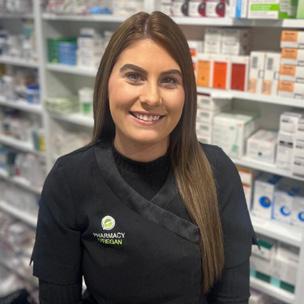
PHARMACYNEWSIRELAND.COM | 67
Ciara Speight, Castle Pharmacy, Castlemartyr
The Irish Pharmacy
Awards 2024

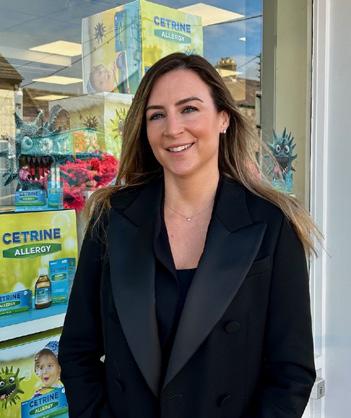









Perrigo Superintendent Pharmacist of the Year 2024
Ciara's leadership continues to drive success in Adrian Dunne Pharmacy Group, fostering a culture of collaboration, support, and excellence. Ciara's dedication to staff development underscores the pharmacy commitment to providing compassionate and respectful care to their customers. Notably, she spearheaded the pharmacist-led training initiative, empowering pharmacists to share their expertise through cross-training sessions and collaborative learning opportunities, ultimately enhancing the pharmacists ability to serve their community with excellence.
Under Ciara's leadership, Adrian Dunne Pharmacy Group was honoured with the prestigious Best Workplace 2023 award by Great Place to Work. This recognition, with the Adrian Dunne Pharmacy Group ranking among the top 30 medium-sized companies, highlights their commitment to cultivating an exceptional workplace environment, a remarkable achievement within the pharmacy industry.
Mark McPhillips’ contributions to public health over the last year are extensive and multifaceted, highlighting his role as a community leader in healthcare. In summary, his role has been exemplary in promoting public health. His mentoring of pharmacists and interns, involvement in setting professional standards, introduction of specialised health services, commitment to community education, and pursuit of professional development, collectively underscore his profound impact on community health and the pharmacy profession.
Mark’s impact on Mark's Pharmacy and the Ardee community over the past year has been significant and multifaceted. His leadership and innovations have led to measurable improvements in both business performance and community health outcomes.


John’s professionalism and ongoing awareness of changes in pharmacy, including changing legislation, code of conduct, drug shortages, price changes and upcoming de-regulation of drugs is unparalleled. He leads by example by re-enforcing the professional culture the pharmacy team has developed in all 3 stores. His extremely approachable personality in many situations albeit sensitive or otherwise is a very special trait he possesses. John will always use negative experience as a learning tool and an opportunity to grow confidence and self-belief in his fellow colleagues, if any errors or near misses occur.
He is an integral part of the team and has been the driving force behind growing the dispensary business in Millmount Pharmacy.
68 | PHARMACYNEWSIRELAND.COM
Finalists Finalists
Mark McPhillips, Mark’s Pharmacy, Ardee
John McCourt, Millmount Pharmacy, Drogheda
Ciara Toolen, Adrian Dunne Pharmacy Group









Online Pharmacy Retailer Award 2024 Awards

McCauley Pharmacy Online
Allcare Pharmacy Online
Allcare Pharmacy offer an online service that is unique providing a free click & collect service to over 90 community pharmacies across Ireland and free next day delivery when ordering before 2pm Monday to Thursday amongst their many services.
As an online pharmacy they also offer over the counter medication, vitamins and supplements, beauty, skincare, fragrance, electrical items, mother & baby care and healthcare services; Medical equipment for assisted living; An online Doctor service, which is a quick, safe and discreet way to obtain prescriptions and an express script service, where a customer fills out a short online form and uploads a photo of their script.
As an online pharmacy, McCauley offers vitamins and supplements, beauty, skincare, fragrance, electrical items, mother & baby care and healthcare services.
They also have an online photo centre with an amazing range of digital prints and cameras and online Doctor service. The Mccauley App is available for prescription ordering, advice from doctors and online shopping.
The objective as an online pharmacy is to be one of the leading premium skincare, beauty and haircare providers in Ireland. The team are always updating their range to include the newest products on the market that they see fit the McCauley customer.

Life Pharmacy are giving customers the best online journey using AI tools for personalisation. Life Online also uses email segmentation to send their customers personalised emails based on demographic information and shopping behaviours. The pharmacy has had exponential growth of app prescription orders due to the convenience, the ease of repeat usage and accessibility to in - app history. Benefits of our app include: Multiple Patient support added to app to enhance convenience; Inclusion of EHC, Viagra, Online Doctor and Vaccine booking service to app and; Push Notifications to periodically send promotions to patients – instant touchpoint to communicate with channel to drive engagement.
Over the last year they have updated their warehouse system. This has increased efficiency throughout the entire warehousing and distributing process.The team strive to provide a high level of online customer service and support. They have set about achieving this objective by investing in Zendesk customer support software, which allows them to nurture customer relationships with personalised, responsive support across all channels.
The pharmacy team at Lilly’s bring some very unique things to the table. Lillys is a health store and also uniquely, have a functional medicine practitioner in store in Ola the owner/pharmacist, and as a result they are able to offer some specialised supplements that are practitioner only brands, combined with the knowledge to recommend and sell these products.
The team have recently launched a Made in Ireland section which is comprised of over 20 Irish brands that they support. It is a passion to support local and as a small Irish business. From established skincare brands to start up supplement brands, Lillys pharmacy will always support. They also offer a huge range of specialist skincare and are also looking to get into aesthetic skincare.

PHARMACYNEWSIRELAND.COM | 69
2024 The Irish Pharmacy Finalists Finalists
Lillys Pharmacy, Ratoath
Life Pharmacy Online
Awards 2024











Reckitt Community Pharmacist of the Year Award 2024
Michael O’Kane, Hickey’s Pharmacy, Dundalk
Michael offers excellent patient focussed customer service in Hickey’s Pharmacy Dundalk store. He continually goes that extra mile for all of his patients, from advising them about the different government healthcare schemes available to them right through how to take/use their medicines. He has an empathetic approach in advising/counselling patients and their carers on their medicines and how best to take/use them. He is an active listener and communicates with patients in a supportive and sympathetic manner providing private consultations when required. He is actively involved in the promotion of the New Medication Service whereby after a patient receives a new medication he will offer to ring them after a few days to find out how they are getting on with their new medication and will subsequently advise them if they have any questions regarding it, this has proved invaluable in building customer loyalty and helps improve medicines compliance.
Anna Cotter, McCabes Pharmacy, Newcastle
Anna has successfully implemented various strategies to make the pharmacy run more efficiently. She has successfully improved the dispensing process via applying Lean Manufacturing Tools. In order to be able to do this, she underwent Green Lean Six Sigma Belt course in January 2023 and received a certificate of completion in May 2023.
She has trained McCabes Newcastle Staff to help them advance according to their interests, and at the same time to improved productivity in the pharmacy. During that informal training in the workplace, she applied mentoring tools to ensure the learning is more effective and its’ effects last longer. Anna was able to do that thanks to completing the Professional Diploma in Coaching and Mentoring in Kingstown College (diploma received May 2023). Ever since starting maternity leave in November 2023, she has made it a point to stay in tune with the Irish community pharmacy, engaging in various projects, including IIOP Mentoring Programme 2023/2024 as a mentor and Mentoring Ambassador.
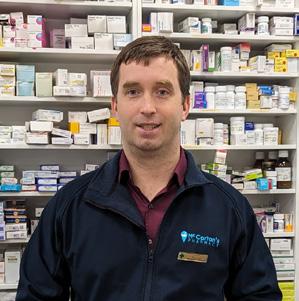

Colum Clarke, McCartan’s Pharmacy, Portmarnock
Colum is described as someone who always goes above and beyond for both his staff and community. His care and diligence to people is next to none, the knowledge he has about all pharmacy products including beauty is un-rivalled. The team in Portmarnock is a small one and he helps all of his colleagues with all their individual jobs. The following is just one of the many messages received from customers who wish to show their appreciation to Colum and all he has done from them over the years. “Colum is very much a treasured friend in our ‘family’ and there are four families and three generations who know him well. Nothing is ever a problem ‘cool under pressure’ is how I would describe him and such a kind hearted individual. We lost 2 parents last year, medication in blister packs constantly changing. Colum would say ‘are you going into Dunnes? Give me 15 mins and I’ll have it sorted’. That level of care and service is a rarity in today’s world.”
Sarah Mackessy, Boots Pharmacy Wellpark, Galway
Supervising Pharmacist, Sarah Mackessy is a deeply committed, professional and passionate community pharmacist in one of Boots newest stores. No matter what service or initiative the business launches, Sarah has proven that she is a true advocate for ensuring accessible healthcare for all in her community, and is a constant champion of her colleagues in her team.
Key to her success is the time and care she takes to talk to patients about services, the efficiency of her delivery of services and the accessibility she ensures with appointment availability spread throughout the day, before and after work and at lunchtimes. She ensures the workload of the pharmacy is exceptionally well planned to support this.

70 | PHARMACYNEWSIRELAND.COM
The
Finalists Finalists
Irish Pharmacy
Frank Olden, Hickey’s Pharmacy, Cork

Over the last 12 months, Frank Olden has made significant contributions to public health and pharmacy practice, demonstrating his commitment to advancing the profession and enhancing patient care.
Frank’s contributions over the past year encapsulate a blend of clinical excellence, educational mentorship, and proactive community engagement. His work in public health initiatives, educational roles, and clinical practice reflect his strong character, professional accomplishments, and deep understanding of the goals of pharmacy. He exemplifies the evolving role of the community pharmacist in healthcare.
Frank has had a profound impact on both Hickeys Pharmacy and the Cork community. His leadership has led to increased business efficiency and growth, while his community initiatives have significantly contributed to public health awareness and education. Frank’s influence extends beyond the walls of the pharmacy, cementing his role as a crucial healthcare provider in the community.
Michelle O’Hagan, Pharmacy Hub, Killinarden
Michelle is an advocate for her patient’s health, and for the health of the local community. She is heavily involved with South Dublin County Partnership and their HSE health promotion officers. She regularly has the smoking cessation officer in the pharmacy, carrying out clinics and providing information to the community on the free HSE We Can Quit Smoking Cessation programmes. She runs vaccination clinics, all year round for covid vaccines, and the seasonal flu vaccine.
She is also an advocate for mental health and wellbeing, getting personally involved in the ’Darkness into Light’ campaign (Pieta House) every year and the ‘Hello, How are you’ campaign (Mental Health Ireland) in 2023. She organised for the Marie Keating Mobile Unit to visit the pharmacy in October 2023 (for Tallaght Health Awareness Month) to encourage breast cancer health awareness. Michelle also enrolled the pharmacy in the IPU Safe Pharmacy initiative, and ensured all staff completed the training and that our pharmacy can be seen as a safe space for those who fall victim to domestic violence.


Shane Ryan, Ryan’s Pharmacy, Rathangan
Shane has grown the Ryan’s Pharmacy business over the last 28 years. They are now five independent community pharmacies based in Rathangan, Edenderry, Rhode, Daingean and Derrintun.
Ryan’s Pharmacy is a vital part of the community and Shane believes passionately in developing strong relationships with customers while striving to provide a service that is not only excellent but reflects their high standards and delivers on their commitment. This is tangible from the top down, from Shane throughout the team of 70 staff across five locations. Shane is the driving force behind this and he has surrounded himself with likeminded people who believe in a strong sense of community. He is overseeing investment and growth in the Edenderry pharmacy store, doubling in size, furthered Cholesterol diabetes testing within the pharmacies and is actively collaborating with GP’s with increased communications on patient medications.
James Coughlan, Hickey’s Pharmacy Johnstown
Over the last twelve months James has had a massive impact on the public health of his local community. James has built his Winter Flu and COVID booster vaccination service from a low foundation of 230 vaccines in the season before he joined the team, to delivering the most successful vaccination service in our entire group in the space of twelve months.
His leadership in implementing innovative practices and advocating for the advancement of his pharmacy sets him apart. James has made significant contributions to improving patient care and enhancing delivery within his pharmacy. His dedication to evolving the role of pharmacists in healthcare aligns perfectly with the criteria for this award. Whether through his professional practice or advocacy efforts, James has consistently demonstrated a commitment to excellence.

PHARMACYNEWSIRELAND.COM | 71
The Irish Pharmacy









JPA Brenson Lawlor Young Community Pharmacist of the Year Award 2024 Awards 2024
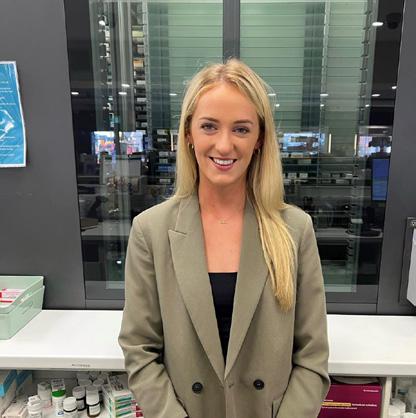
Sadhbh is highly valued by her customers in Wexford Town, and that her commitment to providing excellent patient care extends beyond the walls of the pharmacy. Her willingness to go above and beyond in ensuring that her patients receive the care they need, even if it means making house calls, is a testament to her dedication to her profession and her customers. This level of personalized care is what sets great pharmacists apart and helps to build strong relationships between pharmacists and their patients.
Sadhbh has also engaged with other local healthcare professionals to understand the range of services available within her community.
Teo Vuckovic, CARA Allcare Pharmacy, Dun Laoghaire
Teo is a dedicated and hardworking pharmacist, who has patient care and safety at the forefront of his mind with every task he performs. Teo works in a very challenging environment, where stressful situations, management challenges and timeframes are all impacting on his role on a daily basis. Regardless of the challenges put to Teo on a daily basis he will always get his job done and to a very high standard.
Teo has shown over his time working in this pharmacy that he is consistently trying to help others within his team in order to improve the pharmacy processes and procedures. He is approachable and flexible in his role and always willing to help out new pharmacists and technicians.

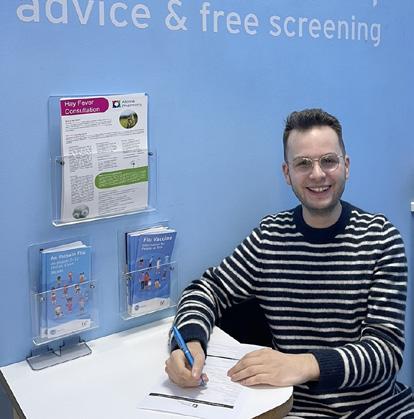
Jill has really embraced the expansion of the pharmacists’ role in the Johnstown community. She played a strong role in the delivery of both Covid and flu vaccinations in the store. In addition to her fantastic vaccine performance, she has carried out many health checks in conjunction with the ‘Healthy Meath’ initiative funded by Meath County Council and the Irish Pharmacy Union.
Jill has had a tremendous impact on not only the pharmacy’s business, but the Johnstown community. Her commitment to educating staff and patients on the importance of overall health, and in particular gut health, has seen the business’ performance thrive. Jill’s dedication to continuous learning and remaining up to date with the latest advancements in pharmacy is evident in her everyday pharmacy practice. She is willing to share her knowledge and expertise with the Johnstown team so that the team stay informed and provide evidence-based advice for patients.
72 | PHARMACYNEWSIRELAND.COM
Finalists Finalists
Jill Jennings, Hickey’s Pharmacy, Johnstown
Sadhbh Whitty, McCauley Pharmacy Redmond Square
Paul John Charles Sambrooks, Mahers totalhealth Chemist, Drogheda
Paul has worked tirelessly to deliver the best possible pharmacy service he can. He is dedicated to his patients and takes immense pride in his role and the work he does. He has continually demonstrated dedication to his pharmacist role, coming in early to prepare the dispensary for the day ahead to make sure the day starts the best it can and will drop what he is doing to support his team members.
In little over the year, Paul has introduced positive changed and built strong effective relationships with his patients, customers and members of the local community. He has also developed excellent professional relationships with members of the Healthcare Community within the area and has ambitions to develop the sector further on a local level.
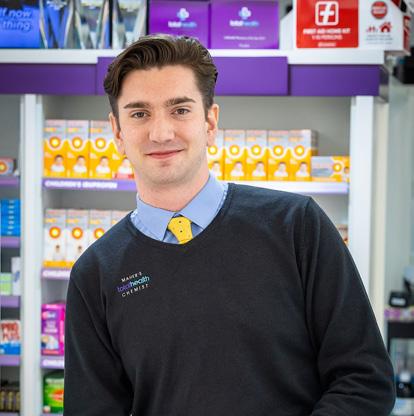
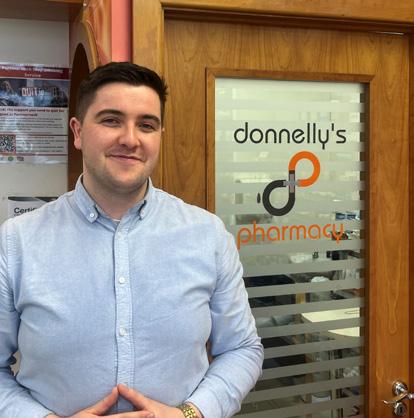
Enda Donnellan, Donnelly’s Pharmacy, Portmarnock
Enda took on the role, covering for Donnelly’s Pharmacist who has many years experience, seamlessly. He is always patient despite working in a high-volume dynamic environment. He takes the time to explain both HSE and Company directives to all the staff members.
Donnelly's has a significant proportion of elderly customers and Enda takes the time to explain any of their concerns regarding medications, and is very empathetic. He goes above and beyond the community pharmacist role. He has also promoted and arranged to hold open consultations with anyone from the local community about Dementia.
Kostas Papadimas, Donaghmede Pharmacy, Donaghmede
Kostas is known for giving his patients that need counselling so much more of his time, ensuring that they are confident with a new medicine, or where a dose has changed. He has a calming voice which always reassures the patient where they may have a concern. Everyone who comes in contact with Kostas will have had their day brightened by the experience.
He has built a great relationship with the local doctor surgeries and indeed has vaccinated many of the local surgery staff. Donaghmede Pharmacy is one of the busiest pharmacies in North Dublin, dispensing being the number one priority and Kostas is great at working under the most intense pressure, while also finding time to vaccinate, take blood pressure readings, serve on the OTC counter and all the other jobs required.

PHARMACYNEWSIRELAND.COM | 73
The Irish Pharmacy
Awards 2024
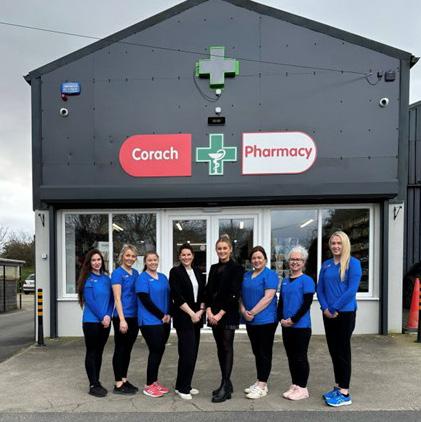









Viatris Community Pharmacy Team of the Year Award 2024
Corach
Since opening in August 2023 Corach Pharmacy has proven to be a success. Every member of staff is invested in providing the best possible service and giving their all on a day to day basis to make sure the smooth running of the pharmacy.
Corach Pharmacy is Wexford and Irish owned by Brian and Therese Hogan. The team provide a delivery service to those living in rural Ireland who can’t always arrange a lift or have a mode of transport to a local pharmacy. They plan on rolling out more events for the elderly like the Dementia Café to other surrounding areas covering different topics and health issues effecting the elderly. It is important to understand the care that our elderly need on a day-to-day basis and to support them with any health issues that may arise.
Adrian Dunne Pharmacy, Rush
In the dynamic and ever-evolving world of community pharmacy, the journey from adaptation to excellence is both challenging and rewarding. Since acquiring the pharmacy in April 2023, the pharmacy team at Adrian Dunne in Rush have embarked on a transformative journey, marked by significant changes and remarkable adaptability.
Central to their success has been the unwavering support and teamwork exhibited by every member of staff. In a pharmacy that sees a daily influx of at least 13 dedicated professionals, the spirit of collaboration is not just beneficial but essential.
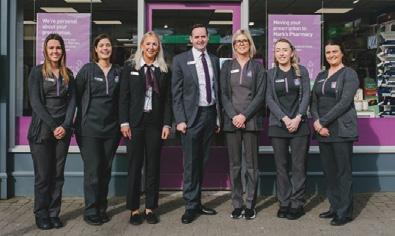
LloydsPharmacy, Kenmare

The team at Mark's Pharmacy epitomizes the essence of collaboration. Each member, from the pharmacist to the sales assistants and technicians, has played a vital role in delivering comprehensive healthcare services. Their combined efforts in the ambitious project of conducting over 1,000 blood pressure screenings in a year – a target they achieved well ahead of schedule – is a testament to their cohesive and effective teamwork.
The pharmacy team has not only met but exceeded community healthcare needs through innovative services. Their efforts not only enhance the health and well-being of the Ardee community but also set a high standard for what a community pharmacy team can achieve.
Teamwork and collaboration are the cornerstones of our success for the LloydsPharmacy team in Kenmare. The team actively listen, share insights, and seek feedback and each team member brings unique skills to the table. They celebrate diversity—whether it’s expertise in medication management, counselling, or administrative tasks, their combined strengths create a holistic approach to patient care.
The Kenmare team’s unwavering dedication to the store’s success is truly commendable. Their proactive approach, constant inquiry into figures and targets, and genuine motivation exemplify their commitment.
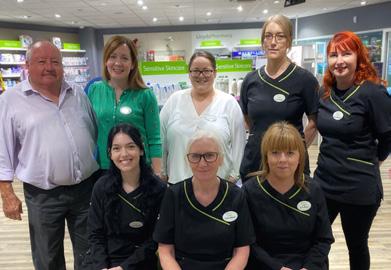
74 | PHARMACYNEWSIRELAND.COM
Finalists
Finalists
Pharmacy, Wellingtonbridge, Wexford
Mark’s Pharmacy, Ardee

Bluebird Pharmacy trading as Clearys, Portmarnock
The Cleary's pharmacy team stands out, embodying dedication, expertise, and compassion in their daily endeavours. Their relentless commitment to enhancing patient outcomes, promoting community health, and upholding professional standards makes the team not just practitioners but pillars of support in the healthcare ecosystem.
The Clearys pharmacy team epitomises excellence in patient care. Each member of the team, from the pharmacist to the OTC assistant, is driven by a profound sense of responsibility towards the well-being of their patients. They go above and beyond to ensure that every individual who walks through the doors receives personalised attention and tailored pharmaceutical solutions.
Hiltons Pharmacy, Cornelscourt, Dublin
Hilton’s Pharmacy is a community pharmacy, which to them means that they strive to provide exceptional pharmaceutical care to their community, demonstrating a commitment to delivering a personalised service for their patients, accurate medication dispensing and compassionate patient counselling.
Their goal is to enhance the health and well-being of every patient they serve. Through dedication, teamwork and a patient centred approach, they strive to be a trusted pillar in our local community supporting all of their patients on their healthcare journey. The team embrace every challenge with a smile and a laugh along with a dedication to deliver what is asked of them. It is this togetherness and enjoyment of each other’s company that has allowed the business to thrive.
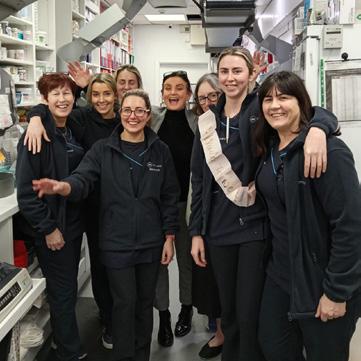
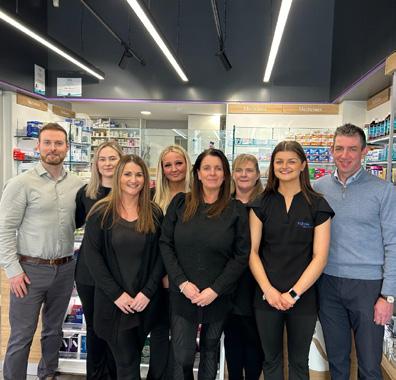
Newpark Life Pharmacy, Kilkenny
The staff at all levels of Newpark Pharmacy are deserving of recognition for their contribution to the community through the many innovative services they offer with the patient at the heart of everything they do. This service provided essential care and well-being to those in need who wish to receive a vaccination but have concerns for their comfort and also being in a busy pharmacy setting.
Providing an area safe from transmission of the general public and also providing deserving comfort and care ensured that the community could be provided vaccinations which in turn benefit the entire community. It also produced an increase in output of vaccinations, ensuring further safety in the community for another season. The entire team pooled their resources together to make sure that the patients came first.
Hickey’s Pharmacy Northside, Dublin
The team in Northside pride themselves with always providing a high level of customer service and patient care. Their patients trust all team members in looking after their health care needs and keeping them or their family well. Their pharmacists offer a wide range of vaccination services including shingles, pneumonia, b12 and travel vaccinations. They continue to engage and support HSE campaigns regularly including the annual flu campaign, COVID booster campaigns and most recently the shingles campaign.
The team acknowledge the importance of participating in wider public health campaigns and how they can play an active role in supporting and strengthening their success. Over the years they have built great working relationships with local GPs and over the last year have become a great source of support to them as they too continue to work under pressure.

PHARMACYNEWSIRELAND.COM | 75
Awards 2024









McLernons Independent Community Pharmacy Award 2024

Lillys Pharmacy, Ratoath Finnegan’s
Finnegan’s Pharmacy have been shortlisted due to the level of care and attention that is given to their local community.
All staff operate at an elite level and give the customers the best possible service. The values that Peter Finnegan has instilled in all staff members is one of empathy and compassion and one that they are truly here to support their customers and community and when some people say that there is no job to big or too small that is something that resonates with the team. If possible, they will do everything possible to help their customers.
Finnegans Pharmacy stands out as the best pharmacy in the country for several reasons, rooted in their commitment to old-school values in community pharmacy and strong bonds with customers.
Lillys Pharmacy are a family pharmacy with a heart who extend their care to every customer that walks in their door. The team offer a one stop shop for all health needs including a nurse that takes bloods once a week. They try to fulfil prescriptions a quick as they can and try to provide the best service making sure the customer's health and happiness is paramount.
The team are a tight knit group and that's why they are there as long as they are at the heart of their community. They offer a huge range of supplements both in store and online, along with vaccines, blood pressure monitoring, blister packs, medication reviews, Cholesterol and HbA1c testing, blood clinic, functional medicine clinic and throw in a joke or 2 to try and make customers laugh. They may be small but pack a punch in terms of their range of services and the level of care provided.


The belief and motto of this team has always been “it’s all about you”, and no more is it apparent than in Village Pharmacy. The team’s aim is to ensure every customer leaves the store feeling better after having a pleasant, courteous and professional experience. Everybody works together to make this a reality. During regular team brainstorming meetings, the upcoming events, new ranges, new products and ideas on how to reach and excel in targets for the store, are always discussed.
The store is a pivotal part of the Village and community and is a go to place for many to meet albeit necessary and chat to other locals. All the team understand that most people crossing our door have their own problems and challenges and require professional advice, understanding, careful approach, a listening ear and at times a bit of light conversation to help them.
Corach Pharmacy, Wellingtonbridge, Wexford
Recently Corach Pharmacy has undertaken a number of initiatives and introduced new services. Supervising Pharmacist Laura delivered a Dementia Café in the Local Grantstown Daycare center, which was a great success, with excellent feedback from both people who attend the center and from workers and carers who attended on the day.
The pharmacy was involved in both the Winter Flu and covid vaccination programs. Clinics were held in the pharmacy and housebound patients benefited from the service as pharmacist Laura conducted house calls when Elaine was on site.
A prescription delivery service was launched for anyone in the surrounding areas covering a 20KM radius. The team have also taken part in the Carrig On Bannow St Patrick’s Day Parade where they launched a Quit Smoking Campaign. The pharmacy sponsored first-aid kits for local sports teams. Annemarie reached out to local chairpersons and representatives called in-store to collect a fully kitted first aid kit.
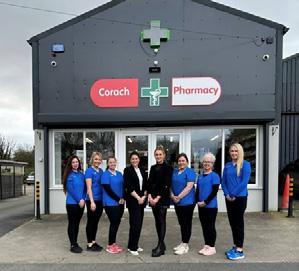
76 | PHARMACYNEWSIRELAND.COM
The Irish Pharmacy Finalists Finalists
Dublin
Pharmacy,
Village Pharmacy, Carlingford
Award for RCSI
RCSI’s commitment to making a positive environmental impact and contributing to a sustainable future has been recognised at the 2024 PWC Business Post Awards.
The university’s Estates team was named as the 'Sustainable Business Team of the Year' for their leadership in embedding sustainable practices across the university’s campus.
RCSI has a deep professional responsibility to enhance human health, which is intertwined with planetary health. The university’s community of staff and students is committed to contributing to the achievement of the UN Sustainable Development Goals and working with others to making a positive and lasting impact on the health and wellbeing of individuals and communities in Ireland and around the world.
Some of the sustainability measures implemented by RCSI include:
• Establishing a Sustainability and Climate Health Committee to ensure a cross-university integrated approach to promoting sustainability
• An energy performance initiative at 26 York Street which has seen the building’s gas consumption reduce by 73%, and its electricity consumption decrease by 27%
• A Green Labs initiative that will see all RCSI labs accredited by the end of 2024
• Water conservation works that have resulted in a 62% reduction in water use since 2019 through the implementation of several water efficiency initiatives
• The elimination of single-use plastic from the campus – all take-away food cartons on campus are compostable.
“This award is a very important validation of our commitment to sustainability across our campus”, said Bryan Sheils, RCSI Head of Campus Services. “It reflects a significant piece of work led by our Estates team, with their Catering, Cleaning, Energy and waste partners and vendors. Some of this work is visible but a lot of it is behindthe-scenes. This external recognition is a great celebration of that effort.”
Urgent Need for National Heart Strategy
Croí, the heart and stroke charity has called for the urgent implementation of a new national strategy to tackle cardiovascular health. The call takes centre stage in the charity’s new manifesto, which was launched last month.
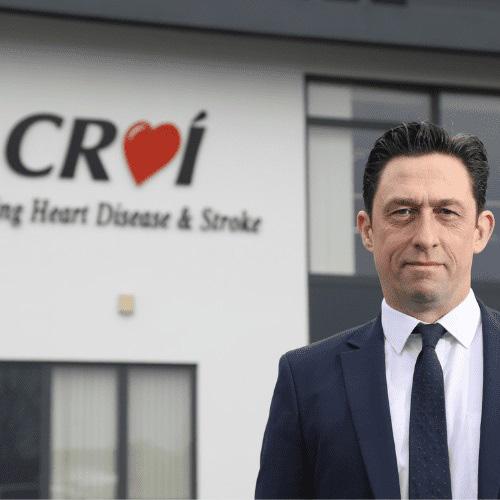
The manifesto, developed in consultation with patient advocates, leading civil society organisations, professional bodies, and voluntary & community groups, outlines five key policy actions. If implemented, these actions will significantly reduce the occurrence of heart disease and stroke (Cardiovascular Disease), in the population and reduce the burden it currently places on our healthcare system.
Cardiovascular Disease is the biggest annual cause of death & disability globally, with over 9,000 people in Ireland losing their lives as a result each year. Furthermore, the disease is responsible for 40% of all hospital admissions, and 75% of all bed days in hospitals. Despite this, Ireland’s last national cardiovascular health strategy expired in 2019, with no evaluation or renewal.
Croí Chief Executive, Mark O’Donnell
Croí is calling on politicians to immediately develop a new national strategy on cardiovascular health akin to that in place for Cancer; the allocation of a multi-annual budget from the department of health; the appointment of a dedicated policy lead in the department of health; and the establishment of a Cardiovascular Disease Prevention Implementation Taskforce.
Speaking at the launch event, Croí Chief Executive, Mark O’Donnell said, “Heart disease and stroke impacts about one in every two families in Ireland, whether through premature death, disability or living with long term chronic ill health –so this is an issue that affects all of us. The old adage that prevention is better than cure is certainly true when it comes to cardiovascular disease given that the majority of the burden is preventable.
“What we need to see is a shift from the short-term management of acute events, such as heart attack and stroke, to a long-term strategy which is focused on early detection and risk management. This will reduce the rate of Cardiovascular Disease, and the associated burden on our healthcare system,” Mark added.

The Cosmetic Association was formed over 35 years ago to offer the Pharmacy sector a one-stop-shop for their Christmas trade. As the years went by, exhibitors took the opportunity of introducing new brands at the Trade Fair and this was a welcome addition. For Buyers to see a full stand of cosmetics, or a display of perfumes, or a range of jewelry or a display of wrapping / bags, in one day, and in one place, is a huge benefit.
We have extended in a full selection of ‘front of house’ products in Pharmacy. We have included gift retailer, garden center shops and some beauty salons with retail section.
The event will be the most colourful to date and we hope you will all enjoy your visit. Remember, we have free parking within the RDS grounds.
The Cosmetic Association was formed over 35 years ago to offer the Pharmacy sector a one-stop-shop for their Christmas trade. As the years went by, exhibitors took the opportunity of introducing new brands at the Trade Fair and this was a welcome addition. For Buyers to see a full stand of cosmetics, or a display of perfumes, or a range of jewelry or a display of wrapping / bags, in one day, and in one place, is a huge benefit.
Our event is scheduled for May 12th, 13th and 14th 2024 in the Main Hall and Hall 3, in the RDS, Merrion Road, Ballsbridge, Dublin 4, and we will be delighted to see you all there. Registration is available at the door. Jo Somerville, Managing Director, The Cosmetic Assocition
We have extended in a full selection of ‘front of house’ products in Pharmacy. We have included gift retailer, garden center shops and some beauty salons with retail section.
The event will be the most colourful to date and we hope you will all enjoy your visit. Remember, we have free parking within the RDS grounds
PHARMACYNEWSIRELAND.COM 77
News
Written by Colm Moore, Moore Wealth Management
Auto Enrolment is Coming Soon – We Think!
First mentioned over 20 years ago as the solution to our ageing population with no private provision other than state supports, auto - enrolment is ‘fast’ approaching.
First mentioned over 20 years ago as the solution to our ageing population with no private pension provision other than state supports, auto-enrolment is ‘fast’ approaching.
Current estimates from the CSO state that only 35% of the population have a private this government has decided they will be the ones to address the issue which deserves heaping another cost on small businesses at the moment is unlikely to be perceived friendly with us a year away from an election.
Fund Choices

Current estimates from the CSO state that only 35% of the population have a private pension and this government has decided they will be the ones to address the issue which deserves praise. However heaping another cost on small businesses at the moment is unlikely to be perceived as business-friendly with us a year away from an election.
Who Will Run This ?
A body known as An tÚdarás Náisiúnta um Uathrollú Coigiltis Scoir (the “Authority”) will be established to run the autoenrolment scheme.
Who is Eligible ?
Approximately 800,000 employees who are aged between 23 and 60, earning over ¤20,000 across employments, and who are not already enrolled in an occupational pension scheme, qualifying PRSA or qualifying trust RAC with an employer making contributions.
What Employment is Exempt?
Employment, in which the employer already makes contributions in respect of the employment of the employee at that time, to a qualifying occupational pension scheme, qualifying PRSA or qualifying trust RAC. The Authority, in consultation with the Pensions Authority, shall draw up standards that these
Written by Colm Moore, Moore Wealth Management
Colm Moore is a CERTIFIED FINANCIAL PLANNER™ with Moore Wealth Management. They have been advising the pharmacy community for over 20 years. He can be contacted on 086-8603953. For more see www.mwm.ie
This will be a simple choice of 4 funds with increasing risk appetite. Unfortunately many here will end up in the wrong fund choice due to the lack of an advice process to accompany AE. Anyone with 7 to 10 years to retirement should be in 100% equities for the best return but this will not happen.
An tÚdarás Náisiúnta um Uathrollú Coigiltis Scoir (the “Authority”) established to run the auto-enrolment scheme.
What happens if I change jobs after being enrolled?
What Employment is Exempt ?
pension products must meet in order to exempt employees contributing to these schemes. These standards have yet to be published.
Opt In or Opt Out
The system will be voluntary but will operate on an ‘opt-out’ rather than an ‘opt-in’ basis.
Opt In or Opt Out
If you change jobs after being automatically enrolled, you won’t need to change pension or join a new scheme. You will remain a member of the auto-enrolment scheme on a ‘pot-follows-themember’ basis. You won’t have to do anything, as the new National Automatic Enrolment Retirement Savings Authority will manage the change.
Approximately 800,000 employees who are aged between 23 and 60, earning over €20,000 employments, and who are not already enrolled in an occupational pension scheme, PRSA or qualifying trust RAC with an employer making contributions.
What if an employer does not partake?
Employment, in which the employer already makes contributions in respect of the employment of the employee at that time, to a qualifying occupational pension scheme, qualifying qualifying trust RAC. The Authority, in consultation with the Pensions Authority, shall standards that these pension products must meet in order to exempt employees contributing these schemes. These standards have yet to be published.
If an employer does not join and contribute they will be subject to penalties and possibly to prosecution. If they don’t make contributions on an employees behalf, they may be fined and have to make repayments with interest. What do employers need to do
Eligible employees will be automatically opted-in but will have the choice after six months’ mandatory participation to opt-out or suspend participation. Opt out can occur after 6 months but not more than 8 months after the date of notice of enrolment, and there will be opt out windows after years 1 – 3 , 4 – 6 and 7 – 9.
“Despite the Automatic Enrolment Retirement Savings System Bill 2024 being published on the 5th April 2024 there is a consensus that there is too much to do to have this in place in 2024 with 2025 seen as a more realistic target”
The system will be voluntary but will operate on an ‘opt-out’ rather than an ‘opt-in’ basis.
Eligible employees will be automatically opted-in but will have the choice after mandatory participation to opt- out or suspend participation. Opt out can occur after but not more than 8 months after the date of notice of enrolment, and there will windows after years 1 – 3 , 4 – 6 and 7 – 9.
Persons will be exempt from reenrolment if they, have reached pensionable age or they are contributing to a pension that meets the yet to be published standards set out by the Authority.
Cost
Both the employer and employee will make matching contributions and the state will put in one third of the employee contribution. The eagle-eyed among you will note that this is less than the tax relief they currently give on employee contributions for those in the 40% tax bracket.
Supposedly not a lot apart from put your hand in your pocket. The Authority advise they are working to ensure that autoenrolment is as easy for employers as possible. This means using existing processes that you’re familiar with, like payroll software. You’ll have to make sure that your payroll software is up to date at launch time and keep an eye out for notifications. There will be more information and guides available for employers closer to go-live.
Can Employers claim tax-relief on the contributions?
Persons will be exempt from re-enrolment if they, have reached pensionable age contributing to a pension that meets the yet to be published standards set out by the Authority.
Yes. If you are paying corporation tax, you will be able to claim tax relief on the employer contribution. You will not be able to claim relief on the employee contribution.
Do owner directors on payroll get auto enrolled or are they regarded as self-employed?
The simple answer to this is that it depends on the PRSI class that you are contributing through as an owner director. If you pay PRSI as an employee and meet the
PHARMACYNEWSIRELAND.COM 78 Auto Enrolment is Coming We think!
Years Employee Employer State 1 to 3 1.5% 1.5% 0.5% 4 to 6 3.0% 3.0% 1.0% 7 to 9 4.5% 4.5% 1.5% 10 Onwards 6.0% 6.0% 2.0%
Cost
Finance
eligibility criteria, then you will be enrolled. But if you are registered as self-employed then you will not be eligible.
What should employers do now?
What should employers do now?
Our View
Firstly and most importantly for employers, you need to budget for the introduction of AE late this year and in the years going forward.
Will there be additional employer returns to be made by employers or will all the pension deduction information be processed through existing Revenue PAYE returns?
Firstly and most importantly for employers, you need to budget for the introduction of AE late this year and in the years going forward.
If you operate a pension scheme in your business already, but not all of your employees are enrolled, they could likely be enrolled in AE. This means that you could have two schemes operating side by side for your employees.
Other concerns would be no provisions for females who typically have more time out of work for childbirth and care reasons to catch up on missed contributions along with no ability to make an additional contribution above the initial 1.5% if the employee wished.
If you operate a pension scheme in your business already, but not all of your employees are enrolled, they could likely be enrolled in AE. This means that you could have two schemes operating side by side for your employees.
As an employer you will need to make a separate return through payroll directly to the central body administering the scheme. Information on how this process will work will be made available to employers closer to go-live. The calculations on contributions will be made through your existing payroll software.
It also means that if there is a waiting period for your pension scheme, employees could be enrolled in AE during this time. If an employee is enrolled in AE and subsequently wants to join the other scheme, they will be able to do so at any time.
AE Process Walkthrough
Process Walkthrough
Despite the Automatic Enrolment Retirement Savings System Bill 2024 being published on the 5th April 2024 there is a consensus that there is too much to do to have this in place in 2024 with 2025 seen as a more realistic target. There is a lot to be done including appointment of fund managers, selection of the processing database and to my mind the most important part is the education piece. There is not a high level of financial literacy in Ireland and this will lead to confusion and mistakes being made. The fact that no advice is received by those enrolled is concerning and will have an impact on participation.
It also means that if there is a waiting period for your pension scheme, employees could be enrolled in AE during this time. If an employee is enrolled in AE and subsequently wants to join the other scheme, they will be able to do so at any time.
The AE system is needed but the government has a lot of work to do to get buy-in from employers and employees. As an employer putting in place a scheme that has the same cost to you as an employer with better fund options along with retirement options could be a good move at this point as part of a proactive employee hiring and retention policy.
Eligible employees identified through Revenue data with no waiting period for employees
PHARMACYNEWSIRELAND.COM 79
Payroll
will be sent via payroll software and employer applies payroll notification Contributions based on gross pay collected from employer and employee Contributions are invested on behalf of employees Pots will follow employees across jobs through their working life AE
notification
Keeping a Heart Healthy Diet Through Menopause
Menopause & Heart
“My cholesterol was totally normal until I hit menopause. I couldn’t tolerate statin medication nor did I really want to go on it, so with a few changes to my diet and lifestyle this seems to be helping”. - Katherine, age 57
Keeping a Heart Healthy Diet Through Menopause
“My cholesterol was totally normal until I hit menopause. I couldn’t tolerate statin medication nor did I really want to go on it, so with a few changes to my diet and lifestyle this seems to be helping”. - Katherine, age 57

Heart health issues have always been believed to be a man’s issue more so than women’s. This is true, up to a point. But from the age of 40, a woman’s risk of heart disease and stroke increases as she moves into menopause.
Gillian McConnell, CORU Registered Dietitian DI019371, BSc(Hons) Dietetics, PgC Applied Sports Nutrition
We recently spoke to Gillian McConnell, CORU Registered Dietitian DI019371, BSc(Hons)

Dietetics, PgC Applied Sports Nutrition to find out more about how women can keep a healthy heart diet through menopause.
Inflammation, a hot topic, but not often associated with heart health. Chronic inflammation, the type that persists for months or years, can irritate the blood vessels, possibly promoting the growth of plaque, loosening plaque and triggering blood clots that may cause a heart attack. We’ll talk more on reducing inflammation later. Oestrogen exerts anti-inflammatory effects, leading to a protective effect on blood vessels.3
After the age of 50, women are seven times more likely to die from heart disease, than breast cancer. Gillian told us, “The silver lining is that problems with the heart typically take two years to develop and are often preventable and manageable. Women need to focus on the diet and lifestyle factors that ideally should be embedded before and during peri-menopause, as well as after menopause. This sooner this is started, the better.”
Menopause and the Resulting Changes
Gillian told us that while menopause doesn’t directly cause cardiovascular conditions, it raises the risk for developing them.
Heart health issues have always been believed to be a man’s issue more so than women’s. This is true, up to a point. But from the age of 40, a woman’s risk of heart disease and stroke increases as she moves into menopause.
We recently spoke to Gillian McConnell, CORU Registered Dietitian DI019371, BSc(Hons) Dietetics, PgC Applied Sports Nutrition to find out more about how women can keep a healthy heart diet through menopause.
After the age of 50, women are seven times more likely to die from heart disease, than breast cancer. Gillian told us, “The silver lining is that problems with the
heart typically take two years to develop and are often preventable and manageable. Women need to focus on the diet and lifestyle factors that ideally should be embedded before and during peri-menopause, as well as after menopause. This sooner this is started, the better.”
and other sex hormones regulate fundamental cardiovascular functions1 and although one might argue that cardiovascular disease (CVD) risk increases from the effect of aging, it has been seen that the use of hormone replacement therapy (HRT) has been associated with protective effect against coronary artery calcification.2
She says, “Higher oestrogen levels prior to menopause may explain the difference in risk as oestrogen and other sex hormones regulate fundamental cardiovascular functions (1) and although one might argue that cardiovascular disease (CVD) risk increases from the effect of aging, it has been seen that the use of hormone replacement therapy (HRT) has been associated with protective effect against coronary artery calcification (2).
Menopause and the Resulting Changes
Gillian told us that while menopause doesn’t directly cause cardiovascular conditions, it raises the risk for developing them.
She says, “Higher oestrogen levels prior to menopause may explain the difference in risk as oestrogen
“While it isn’t completely clear exactly how oestrogen plays a part, it is thought that oestrogen helps in promoting greater blood flexibility and discourage plaque formation and inflammation in the arteries. Of course, there isn’t just an instant plummet in oestrogen levels once you hit menopause, this is why we need to look back at peri-menopause where fluctuating hormone levels can be where the start of cardiac issues occur, a time when often heart health isn’t even on women’s’ radars. Figure 1 indicates the effects of oestrogen on the cardiovascular system.”
Factors increasing risk for heart disease
Visceral fat, or belly fat as it’s sometimes known, is the fat surrounding the vital internal organs. An excess of visceral fat is linked to high cholesterol, elevated blood pressure and linked to Type 2 Diabetes, which are all risk factors for heart disease. Women who carry weight around their middle have a greater chance for heart attack than women who are just heavier overall.4 A waist circumference of 76.2cm (30 in) or more is associated with more than two-fold higher risk of CHD5 and on average women gain 1.7% fat mass per year.6 Lowering oestrogen levels have also been associated with loss of lean body mass.
Diabetes & pre-diabetes are a major risk factor for cardiovascular disease. Prolonged elevation of blood glucose levels is harmful to blood vessels and the nerves that control the heart. Oestrogen seems to contribute to glucose homeostasis through increased glucose transport into the cell, so a lack of oestrogen has been associated with a progressive decrease in glucose-stimulated insulin secretion and insulin sensitivity as well as an increase in insulin resistance.7 Fortunately, the strategies to control diabetes are also good for your heart.
“While it isn’t completely clear exactly how oestrogen plays a part, it is thought that oestrogen helps in promoting greater blood flexibility and discourage plaque formation and inflammation in the arteries. Of course, there isn’t just an instant plummet in oestrogen levels once you hit menopause, this is why we need to look back at peri-menopause where fluctuating hormone levels can be where the start of cardiac issues occur, a time when often heart health isn’t even on women’s’ radars. Figure 1 indicates the effects of oestrogen on the cardiovascular system.”
Gillian outlines those key factors which can increase the risk of heart disease:
Hypertension if an issue in the menopausal or postmenopausal years, plays a significant role in the development of coronary heart disease, chronic heart failure
PHARMACYNEWSIRELAND.COM 80
Figure 1: Oestrogen effects & cardiovascular system (adapted from Managing the Menopause 2nd edition)
Oestrogen effects on cardiovascular system Mitochondrial electron transport Ion channels & repolarisation Lipid profile Diabetes & insulin sensitivity Vasular function & artherosclerosis Cardiac hypertropy Stem cell survival Figure 1: Oestrogen effects & cardiovascular system (adapted from Managing the Menopause 2nd edition)
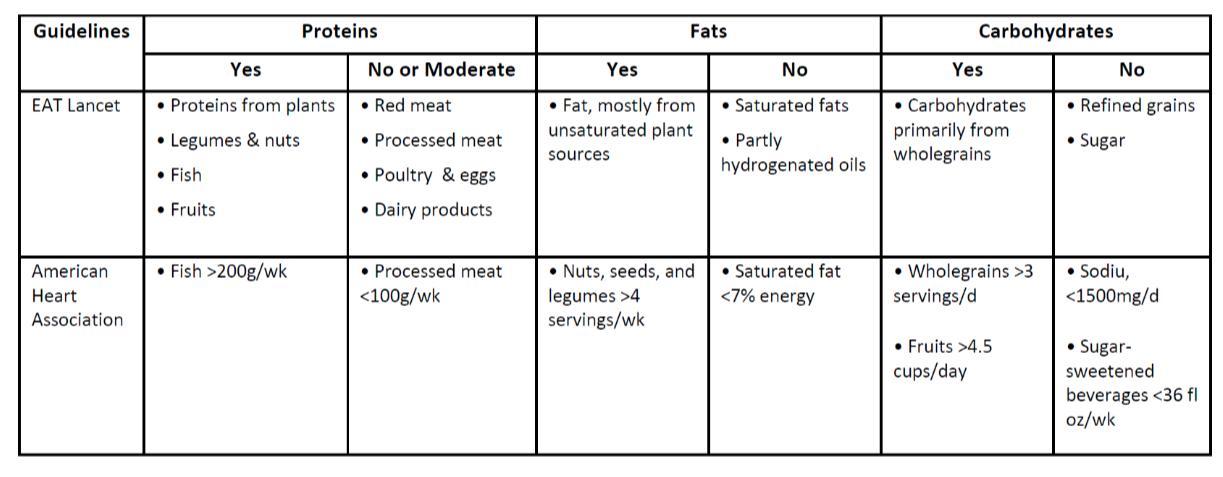
What can women do?
Figure 2
2
and stroke in older women.8 The extra force created by high blood pressure may create tiny tears in vessel walls that encourage plaque build-up and further narrowing of the arteries as well as sodium sensitivity increases during menopausal transition, frequently leading to intermittent fluid retention (oedema of the legs, hands, and lower eyelids), contributing to higher cardiovascular risks.9
Gillian continues, “Diet can play a major role in modifying the risk for CVD and as Dietitians, we really want women to focus in on what they can add to their diets to make it more heart healthy.”
gives a nice overview of the main characteristics of a heart healthy diet.”
She concludes, “In particular, the scientific evidence is high for the following;
She concludes, “In particular, the scientific evidence is high for the following;
Lipid profile changes occur during the menopause transition, with a 10-15% higher LDL-cholesterol and triglyceride levels and slightly lower HDL cholesterol levels.10
She notes that one of the most important things is to focus on following a consistent healthy dietary pattern, one in line with the Mediterranean style of eating. “This contains protein sources mainly from plants, nuts, fish, or alternative sources of omega-3 fatty acids; fat mostly from unsaturated plant sources; carbohydrates primarily from whole grains; at least five to seven servings of fruits and vegetables per day; and moderate dairy consumption.11 Figure 2 below taken from Willet et al, (2019)11
NEWS - Wake Up Call to Government
Omega-3 fatty acids are polyunsaturated fats that are beneficial for heart health. Eicosapentaenoic acid (EPA), docosahexaenoic acids (DHA) and alpha-linolenic acid (ALA) are the three main omega-3 fats. As a group, omega-3’s lower blood triglyceride levels, slow the growth of plaque in arteries and have a slight effect on lowering blood pressure. EPA and DHA are found mainly in oily fish should be consumed once or twice per week. ALA needs to be converted from ALA to EPA and DHA, but this happens at very slow rates,
which means ALA food sources like flaxseed, olive oil, walnuts and avocado need to be consumed daily. Women who completely avoid these food sources or have raised triglyceride levels may benefit from omega-3 supplements with EPA and DHA, 200 to 500mg a day of combined EPA and DHA.12
Saturated fats coming from fatty meats, butter, lard, palm oil, coconut oil, as well as cakes, biscuits, pies and pastries need to be reduced to prevent the elevation of LDL levels, which promote plaque build-up in the arteries. Ideally less than 10% of total daily calories should come from saturated fat.”
Omega-3 fatty acids are polyunsaturated fats that are beneficial for heart health. Eicosapentaenoic acid (EPA), docosahexaenoic acids (DHA) and alpha-linolenic acid (ALA) are the three main omega-3 fats. As a group, omega-3’s lower blood triglyceride levels, slow the growth of plaque in arteries and have a slight effect on lowering blood pressure. EPA and DHA are found mainly in oily fish should be consumed once or twice per week. ALA needs to be converted from ALA to EPA and DHA, but this happens at very slow rates, which means ALA food sources like flaxseed, olive oil, walnuts and avocado need to be consumed daily. Women who completely avoid these food sources or have raised triglyceride levels may benefit from omega-3 supplements with EPA and DHA, 200 to 500mg a day of combined EPA and DHA (12).
Instagram: @gillian.insideoutnutrition
FB: @DietitianInsideOutNutrition Web: www.insideoutnutrition.ie
References available on request
An alarming open letter from 20 of the country’s leading cancer doctors and researchers, should serve as a ‘wake-up call’ to Government, the Irish Cancer Society said today.
Saturated fats coming from fatty meats, butter, lard, palm oil, coconut oil, as well as cakes, biscuits, pies and pastries need to be reduced to prevent the elevation of LDL levels, which promote plaque build-up in the arteries. Ideally less than 10% of total daily calories should come from saturated fat.”
In an open letter to the Taoiseach, Simon Harris, who was the Minister for Health when the current National Cancer Strategy was published in 2017, leading clinicians have warned of cancer surgery delays and staffing shortages nationwide.
The stark letter sets out a series of targets that have not been met due to the National Cancer Strategy only receiving dedicated funding in two out of seven Budgets since its launch in 2017.
The letter states: “Screening has not been expanded as planned. Target waiting times for cancer tests are not being met. Cancer surgeries are frequently delayed due to shortages in staffing, beds, and theatre space. Investment in infrastructure has been lacking, despite increasing infection control issues and rising cancer incidence. Radiotherapy services are operating significantly below capacity. We are falling far short of the already modest target of 6% of cancer patients participating in clinical trials. Ireland is also one of the slowest countries in Western Europe to make new medicines available to public patients.”
The clinicians point out that in the most recent year for which data is available (2019), Ireland had the third highest cancer mortality in Western Europe. The clinicians state that, “Given the impact of COVID-19 on Ireland’s cancer services and the Government’s failure to provide any new recurrent development funding for the National Cancer Strategy in 2023 or 2024, we have no reason to believe the situation has improved. Rather, given the pressure our services are currently under, Ireland’s cancer outcomes are at risk of going backwards.”
They continue, “People with cancer in Ireland deserve the best possible chance of surviving the disease and enjoying a good quality of life afterwards. This will only be achieved through properly resourced cancer services, with protected pathways that are not disrupted by other pressures on the health service.
“We urge you to reverse the decision to provide no new recurrent funding to the National Cancer Control Programme in 2024 and to commit to sufficient ringfenced multiannual funding to enable full delivery of the National Cancer Strategy 2017-2026.”
PHARMACYNEWSIRELAND.COM 81
Figure
Finding Your Way after Sexual Violence
A guide to options and supports after rape, sexual assault and other forms of
sexual violence in Ireland

If you have experienced sexual violence, it can be hard to know where to turn for trusted information and support. From our 45 years of supporting those affected by sexual violence, Dublin Rape Crisis Centre knows it is vital to have easily accessible information and support when you need it. With that in mind, we created Finding Your Way after Sexual Violence, an online guide that aims to support victims and survivors on this difficult journey. It offers information on how to access a Sexual Assault Treatment Unit (SATU), report to the Gardaí, or navigate the criminal courts and legal processes. The guide also describes supports available to survivors, such as the free and confidential 24-hour National Rape Crisis Helpline 1800 778888.
Primarily aimed at survivors of sexual violence, the guide is trauma-informed and uses text, animations, audio clips and direct quotes to explain how the various processes may make a survivor feel, as well as how and where to seek support following sexual violence. However, in each section of the guide, there is also information designed for those seeking to know more about how to support another person.
Finding Your Way after Sexual Violence features a diverse range of personal experiences shared by victims and survivors, in audio and written format. We have included testimonials from medical staff and volunteers working in SATUs, from An Garda Siochana, and from those working and volunteering in the courts and legal system. Their voices provide reassurance that there are empathetic, professional and dedicated people available who want to help and guide victims and survivors, and who understand that the journey is
Written by Gráinne Henry, Dublin Rape Crisis Centre
unique for each person, as are their needs.
Empowering victims and survivors of sexual violence to make choices that are best for them is key to our work. Sexual violence was forced on them, so it is vitally important that we do not take away their decision-making powers or pressure them into any actions or choices.
“Whatever path someone takes after experiencing sexual violence, it can feel so isolating, and having this resource can make a huge difference. The language is easy to understand, and the emotional support that Rape Crisis Centres provide is there. It's a step in the right direction, and it's comforting to know that information and support is available when you need it” - a survivor of sexual violence speaking about the guide.
Sexual Violence in Ireland
As medical professionals working in a hospital, Finding Your Way after Sexual Violence may be useful to you in understanding how victims and survivors of sexual violence may be feeling. In particular, the guide provides an insight into what happens in a SATU and is a great referral point for any patients who would like more information on supports and options available to them. Survivors are often worried about being believed or about what happens next. They have been through an incredibly traumatic experience. With 1072 attendees across SATUs nationwide in 20221, it is important to understand the additional impact of trauma when working with patients who have experienced sexual violence. There was a substantial increase in DRCC’s accompaniment support work in 2022 which provided emotional support to 291 survivors at the Sexual Assault Treatment Unit in Dublin – an increase of 153% over 2021 - along with 233 of their family and friends.2
Reflecting on the SATU figures, it is important to note that SATU is a service for those who have experienced very recent rape or physical sexual assault. The reality is that very many people in Ireland have been harmed by sexual violence. Data from the Central Statistics Office shows that 52% of women and 28% of men reported experiencing sexual violence in their life.3 The National Rape Crisis Helpline had 18,400 contacts in 20222 from people of all genders and ages who had a wide variety of experiences.
Working with survivors of sexual violence
When providing care for someone who has experienced sexual violence, it is important to listen to how they are feeling and to give them space. People have very individual responses to the trauma of rape and sexual assault and the long-term effects also vary widely. Because of this, it is important to respect each person’s way of coping. These impacts may occur many years after a rape or assault as well as in the immediate aftermath. Everyone’s reaction to experiencing sexual violence is different: they may want to talk or be completely silent. They might be blaming themselves or feeling angry, upset or numb. It’s important to remember that there’s no set way to react to sexual violence; everyone is different.
Engaging in medical care can be triggering for some survivors. Their autonomy was taken from them when they were assaulted so it is important to allow them to have personal agency. Try to be conscious of this when providing care. If you need to touch a patient, explain to them where you will be touching them, when you will do it, and why it is necessary. Allow them the space to ask questions and try not to rush them. Let them know the options available to them, including the National 24-Hour Helpline (1800 77 8888). You can also direct them to this Finding Your Way guide, where they can find out more about their options.
“Time after time, a survivor will say how much it helps them to meet someone who reassured them that they are believed” - SATU volunteer.
Vicarious Trauma
Encountering the stories of victims of rape or child sexual abuse is stressful and traumatic. In the course of your work, you may hear or read details of abuse, and of the pain, sometimes lifelong, experienced as a consequence. As you witness the stories and the impact of trauma, you may experience a traumatic response yourself. It is worth reflecting on how working with trauma may be impacting you. Here are some ways you can look after yourself and avoid experiencing vicarious or secondary trauma:
• Clearly define your role and responsibilities and its boundaries. You are responsible for fulfilling your limited role in a caring and professional manner.
• If a patient discloses to you that they have experienced sexual violence, you can tell them about the National Helpline where they can get specialised support and information that is free and confidential. You are not responsible for the patient’s experiences or distress or for solving the patient’s problems or meeting all of their needs or concerns.
• When encountering trauma, notice what happens for you, in your thoughts, images, emotions, and body.
• Ground yourself by noticing yourself sitting in the chair, the floor under your feet; take some deep breaths and try to loosen your body. You could be sitting in a tense pose for a couple of hours if you are not aware. Take regular breaks, even for a few moments.
• Allow time for debriefing between one patient and the next. Take a few moments to register how you are feeling to let go of and shake out the session. Stretch and loosen your body, which may be holding some tension and trauma.
• Outside of work, provide yourself with as many opportunities as possible to enjoy activities which are fun and make a conscious decision to link in often with the people in your own life. Help yourself to maintain balance by taking part in activities that give you joy and pleasure.
PHARMACYNEWSIRELAND.COM 82 Crisis Advice

• Remember that you can call the National 24-hour Helpline 1800 77 8888 or use the webchat at drcc.ie if you have been affected by sexual violence in any way, including from working with patients.
• This can be an overwhelming experience for you. If you need support for yourself, the 24-Hour National Helpline is available for you to call on 1800 77 8888. The helpline is free and confidential and is open to everyone who has been affected by sexual violence, including those supporting victims and survivors. We can provide guidance to you on how to support those who have experienced sexual violence.
It can be daunting, and we are here to listen.
Finding Your Way after Sexual Violence is for anyone in Ireland affected by sexual violence, including victims and survivors, their supporters and others engaged in these systems. It is not just a guide for those who have experienced sexual violence directly; it aims to help all of us to understand our role in supporting and understanding victims and survivors.
Finding Your Way after Sexual Violence is available on DRCC’s website at www.drcc.ie/fyw
If you would like flyers about Finding Your Way after Sexual Violence, the National Rape
Crisis Helpline or any of DRCC’s services, please email communications@rcc.ie
For anyone impacted by sexual violence, at any time, the National 24-hour Rape Crisis Helpline offers free, confidential support at 1800 778888
References
1. Sexual Assault Treatment Unit, Annual Report 2022, 2023.
2. Dublin Rape Crisis Centre, Annual Report 2022, 2023.
3. Central Statistics Office, Sexual Violence Survey 2022, 2023.
DRCC operates the National 24-hour Helpline 1800 778888 to support anyone affected by sexual violence in any part of the country.
A webchat support service is available online at drcc.ie Mon-Fri, 10am-5pm, except holidays.
A Helpline Interpreting Service is available for those who do not speak English.
For those who are deaf or hard of hearing, we provide a text service, operating Mon-Fri from 8am to 6:30pm, at 086-8238443.

PHARMACYNEWSIRELAND.COM 83
Ask the Expert: Dr Cormac Mullins
Dr Mullins was one of the keynote speakers at the recent Irish Pain Society’s Annual Scientific Meeting, where he provided an update on spinal cord stimulation, emphasising the importance of appropriate patient selection.

Dr Mullins also provided a useful critique of the very limited placebo-controlled RCT evidence base that currently exists for spinal cord stimulation, the large placebo response, and the need for more high quality RCTs in this area.
We spoke to Dr Mullins to gain further insights into his valuable work and career to date.
Can you give our readers a brief background of your career to date?
I started as a consultant in anaesthesiology and pain medicine at Cork University Hospital and South Infirmary Victoria University Hospital just over a year ago. Before that, I was working as a pain consultant in Guy's and St. Thomas's NHS Trust in London for a year, where I also did my fellowship training. I am from Galway originally and trained in Trinity College Dublin and completed my anaesthesiology training in Ireland. I also did a pain fellowship at St. James's Hospital Dublin before going to London. My fellowship training was in the area of spinal cord stimulation which is an implantable device which can be very successful for treating certain types of chronic pain. I trained at one of the biggest centres in Europe for this form of therapy and am excited to bring this expertise to Ireland.
Tell us a bit more about your current research work
My main area of research is in the area of spinal cord stimulation (SCS) and headache.
Spinal cord stimulation (SCS) is a form of therapeutic neuromodulation. It was defined by the International Neuromodulation Society as “the alteration of the nerve activity through targeted delivery of a stimulus, such as an electrical stimulation or chemical agents, to specific neurological sites in the body”.
I published three papers in the last year on the topic of SCS.1-3 These were interesting papers that looked at certain areas such as MRI conditionality of devices at followup (which is a very important consideration for patients undergoing SCS implantation as MRIs are so accessible these days), migration of SCS leads during trials and combined implantation of SCS with dorsal root ganglion stimulation which can provide additional flexibility and therapeutic alternatives for spinal cord stimulation. I also published a paper on the use of lignocaine infusions as a treatment for primary headache disorders, such as migraine, and trigeminal neuralgia and this was shown to be quite effective in those refractory to other therapies.4 I also have a review paper on neuromodulation options in migraine and other headache disorders coming out soon. This can provide a non-drug alternative for those who have a condition such as migraine and cannot tolerate medication.
What are your hopes for 2024 for Pain Medicine and Anaesthesiology?
My hopes are to deliver effective multidisciplinary pain management
Dr Cormac Mullins is a Consultant Pain Specialist and Anaesthesiologist in Cork University Hospital and the South Infirmary Victoria University Hospital, Cork
strategies to the greatest number of people while tackling the waiting list for chronic pain services in Ireland. We are hoping that we can deliver evidencebased treatment approaches which focus on enhancing selfmanagement for patients with chronic pain in Cork and improve the throughput and quality of care delivered in our service.
Can you outline some of the biggest challenges facing this field for 2024 and the key opportunities?
In Ireland, the biggest challenge is undoubtedly access to multidisciplinary pain management strategies in a timely fashion. The waiting lists in Ireland for pain medicine are far too long and in Cork we are hoping to redesign how we see patients. We are really excited to have a few excellent new additions to our department in Cork in the form of specialist physiotherapists and a clinical psychologist and we need to focus on getting the message out there for those with chronic pain to remain active, continue with usual activities and not let pain take over. Key management principles that are covered in pain-management programmes involve establishing what is important to the individual and continuing to take committed action towards these goals in spite of chronic pain. Unfortunately, there is often an over-reliance on medical approaches to chronic pain and a key challenge involves moving beyond this to a more integrated and holistic model and taking a person-centred approach to care.
How does Ireland compare with the rest of Europe at present Pain Medicine and Anesthesiology?
In my experience, I believe we are only just catching up to the
message that chronic pain needs to be treated with a multidisciplinary team of medical and nursing professionals, physiotherapists and psychologists and this is mirrored in chronic pain clinics across Ireland that have insufficient numbers of multidisciplinary staff. We are lucky in Cork to have made recent appointments that will allow us to become a true multidisciplinary pain clinic with clinicians from different specialities working together in the same space and communicating with each other frequently to deliver coordinated, patient-centred and evidence-based care.
I am optimistic about the quality of the pain training programme that exists in Ireland now that will rival any pain medicine training programme in Europe and that this will deliver the highest quality pain medicine consultants in the future.
What would be your personal goals and hopes for this field in the future?
My personal goals include tackling the waiting lists for chronic pain in Ireland, delivering effective evidence-based multidisciplinary to the greatest volume of patients, removing the siloed approach to back pain within medicine and exploring cross-speciality therapeutic approaches. I am hopeful that in a year's time that significant dents will have been made in the waiting times for patients to access care and that the quality of care they will receive will be truly multidisciplinary and evidence-based. I am hopeful that we can deliver advanced pain management modalities to those who will benefit from it, including spinal cord stimulation, and we are keen to re-establish this service in Cork this year.
Some of Dr Mullins published scientific papers include:
A retrospective review of elevated lead impedances in impedance-dependent magnetic resonance-conditional spinal cord stimulation devices
Advances in Spinal cord stimulation (SCS) device technology in recent years have led to the development of SCS systems that are magnetic resonance imaging (MRI)conditional, most of which are dependent on normal lead impedances. The objective of
PHARMACYNEWSIRELAND.COM 84
Ask The Expert
this study was to retrospectively analyze the rate of elevated lead impedance in these devices to determine the rate of failure of MRconditional modes.
This was a single-center, retrospective, chart-based review conducted during a five-year period. Patients were included if they had been implanted with an impedance-dependent MR-conditional SCS and had a documented impedance check at least 6 months after implantation. A Kaplan-Meier survival analysis was performed to map the survival of MR-conditionality over time.
There were 363 cases included between 2015 and 2020, which corresponded to a total of 602 SCS leads. Nevro was the most common manufacturer (67.8%), followed by Boston Scientific (22.3%) and Abbott (9.9%). The average overall follow-up time was 2.25 years. Overall, 67 (18.5%) of patients had lead impedances over 10,000 Ω at follow-up with a total of 186 electrode contacts (3.9%). Leads most commonly had either one (40%), two (22%) or three (12%) electrode contacts out of range. Risk of failure of lead impedances increased by 35.4% with each successive year to a peak of 43% of all leads by year 5. Mean overall survival time of normal lead impedances was 4.77 years (CI 4.40-5.13). There was no statistically significant difference in mean overall survival time between Abbott (M = 4.0 years, SD = 1.25), Boston Scientific (M = 4.64 years, SD = 1.75) and Nevro (M = 4.80 years, SD = 3.28), χ2 (2, N = 358) = 1.511, p = 0.47; however, Abbott leads had a greater total number of failed impedance contacts (50/568, 8.8%), in comparison to Nevro (124/3064, 4.0%), χ2 (1, N = 3630) = 23.76, p < 0.00001, at a similar follow-up time.
This retrospective study identified elevated impedances in 18.5% of MR-conditional SCS devices at an average of 2.25 years follow-up resulting in loss of MRconditionality and a mean overall lead survival time of 4.77 years for normal lead impedance.
Radiographic lead migration in percutaneous spinal cord stimulator trials
https://rapm.bmj.com/content/ rapm/early/2023/07/20/rapm2023-104347.full.pdf
Lead migration during spinal cord stimulator (SCS) trials is relatively neglected in the literature and presents a different set of challenges compared with fully implanted leads. There is no consensus on what constitutes a clinically significant amount of radiographic lead migration
during SCS trials. We wished to evaluate the incidence and extent of radiographic lead migration during percutaneous SCS trials, to investigate the risk factors for lead migration and whether this has impacted on trial success.
This prospective observational study of percutaneous SCS trials took place in a tertiary referral center in the UK between April 2021 and January 2022. Radiographs of SCS lead position were taken at baseline and prior to lead removal. Lead migration ≥50% of a vertebral level was deemed significant.
One hundred trials were included comprising 162 leads. Mean migration distance was 0.55 vertebral levels (SD 0.85) or 12.5 mm (SD 18.2) in a caudal direction. Significant radiographic migration occurred in 50% of all leads (81 of 162 leads), at least one lead in 62% of cases and all leads in 44% of cases. Radiographic lead migration was not found to be associated with reduced trial success. A single lead and mechanical anchors were associated with greater incidence of lead migration.
Radiographic lead migration of approximately half of a vertebral level in a caudal direction can be expected during percutaneous SCS trials and this can be anticipated by siting leads half of a vertebral level higher to accommodate for this. Additional factors should be considered in the setting of radiographic lead migration to determine whether this can be considered clinically significant.
Effectiveness of Combined Dorsal Root Ganglion and Spinal Cord Stimulation: A Retrospective, Single-Centre Case Series for Chronic Focal Neuropathic Pain Effectiveness of Combined Stimulation
This case series retrospectively reviewed the outcomes in patients implanted with combined, synchronous dorsal root ganglion stimulation (DRGS) and spinal cord stimulation (SCS) connected to a single implantable pulse generator (IPG) in a tertiary referral neuromodulation centre in the United Kingdom. Materials and Methods Twenty-six patients underwent a trial of DRGS+SCS for treating focal neuropathic pain between January 2016 and December 2019, with a follow-up in February 2022. A Transgrade approach was employed for DRGS. Patients were provided with three possible stimulation programmes: DRGS-only, SCSonly, or DRGS+SCS. Patients were assessed for pain intensity, patients’ global impression of change (PGIC), preferred lead(s)
and complications. Results Twenty patients were successful and went on for full implantation. The most common diagnosis was Complex Regional Pain Syndrome. After an average of 3.1 years follow-up, one patient was lost to follow-up, and two were non-responders. Of the remaining 17 patients, 16 (94%) continued to report a PGIC of 7. The average pain intensity at Baseline was 8.5 on an NRS scale of 0-10. At the last follow-up, the average NRS reduction overall was 78.9% with no statistical difference between those preferring DRGS+SCS (n = 9), SCS-only (n = 3) and DRGS-only (n = 5). The combination of DRGS+SCS was preferred by 53% at the last follow-up. There were no serious neurological complications. Conclusion This retrospective case series demonstrates the potential effectiveness of combined DRGS+SCS with sustained analgesia observed at an average follow-up of over three years. Implanting combined DRGS+SCS may provide programming flexibility and therapeutic alternatives.
A single infusion of intravenous lidocaine for primary headaches and trigeminal neuralgia: a retrospective analysis https://pubmed.ncbi.nlm.nih. gov/37638187/
Intravenous (IV) lidocaine has been used as a transitional treatment in headache and facial pain conditions, typically as an inpatient infusion over several days, which is costly and may increase the risk of adverse effects. Here we report on our experience using a single one-hour IV lidocaine infusion in an outpatient day-case setting for the management of refractory primary headache disorders with facial pain and trigeminal neuralgia.
This is a retrospective, singlecenter analysis on patients with medically refractory headache with facial pain and trigeminal neuralgia who were treated with IV lidocaine between March 2018 and July 2022. Lidocaine 5 mg.kg-1 in 60 mL saline was administered over 1 h, followed by an observation period of 30 min. Patients were considered responders if they reported reduction in pain intensity and/ or headache frequency of 50% or greater. Duration of response was defined as short-term (< 2 weeks), medium-term (2-4 weeks) and longterm (> 4 weeks).
Forty infusions were administered to 15 patients with trigeminal autonomic cephalalgias (n = 9), chronic migraine (n = 3) and trigeminal neuralgia (n = 3). Twelve patients were considered responders (80%), eight of whom were complete responders (100%
pain freedom). The average duration of the treatment effect for each participant was 9.5 weeks (range 1-22 weeks). Six out of 15 patients reported mild and selflimiting side effects (40%).
A single infusion of IV lidocaine might be an effective and safe transitional treatment in refractory headache conditions with facial pain and trigeminal neuralgia. The sustained effect of repeated treatment cycles in some patients may suggest a role as long-term preventive therapy in some patients.
1. Mullins CF, Harris S, Pang D. A retrospective review of elevated lead impedances in impedance-dependent magnetic resonance-conditional spinal cord stimulation devices. Pain Pract. 2024 Feb;24(2):270-277. doi: 10.1111/papr.13301. Epub 2023 Oct 14. PMID: 37837248.
2. Mullins CF, Royds J, Al-Kaisy A. Radiographic lead migration in percutaneous spinal cord stimulator trials. Reg Anesth Pain Med. 2023 Jul 21:rapm2023-104347. doi: 10.1136/ rapm-2023-104347. Epub ahead of print. PMID: 37479237.
3. Mullins CF, Palumbo GJ, Harris S, Al-Kaisy O, Wesley S, Yearwood T, Al-Kaisy A. Effectiveness of combined dorsal root ganglion and spinal cord stimulation: a retrospective, single-centre case series for chronic focal neuropathic pain. Pain Med. 2024 Feb 1;25(2):116124. doi: 10.1093/pm/pnad128. PMID: 37738574.
4. Mullins CF, Fuccaro M, Pang D, Min L, Andreou AP, Lambru G. A single infusion of intravenous lidocaine for primary headaches and trigeminal neuralgia: a retrospective analysis. Front Neurol. 2023 Aug 10;14:1202426. doi: 10.3389/fneur.2023.1202426. PMID: 37638187; PMCID: PMC10448809.
Dr Cormac Mullins is a pain specialist and anaesthesiologist at the South Infirmary Victoria University Hospital, Cork University Hospital and Affidea at the Elysian, Cork.
Public referrals:
Pain Medicine Unit, South Infirmary Victoria University Hospital, Old Blackrock Road, Cork, T12 X23H.
Private referrals:
Affidea Cork, The Elysian, Cork, T12 KTD1
Email: drcmullins@privateclinic.ie Phone: 01-5293476
PHARMACYNEWSIRELAND.COM 85
New Promise in Obesity Battle
In a ground-breaking study, just published in leading international journal Nature Metabolism, scientists from Trinity and Princeton and Harvard Medical School share newly uncovered secrets to natural appetite control, which offers promise in the battle against obesity and type-2 diabetes.

David Finlay, Associate Professor in Immunometabolism, Trinity College Dublin
Obesity is a key driver of type-2 diabetes, and the 2022 Eurostat report revealed that 1 in 5 Irish adults are obese. Indeed, global diabetes cases have more than tripled in the last 20 years alongside the rise in obesity. The cost of managing diabetes represents approximately 9% of EU Member States’ healthcare
budgets – totalling ¤149 billion in 2019. There is no cure for diabetes and every year in Europe 114,000 people lose their lives from diabetes-related complications.
The scientists report new insights into how the widely used diabetes drug metformin benefits patients with type-2 diabetes. Metformin is described by some as a “wonder drug” even though we still do not know exactly how it works.
This study shows that metformin increases the amount of an appetite suppressing factor called LactoylPhenylalanine (Lac-Phe), identified in 2022 as a natural appetite suppressant, and which is known to be raised by vigorous exercise.
The scientists probed data from other studies involving large numbers of patients, to
Ireland ‘First’ for Parkinson’s Disease
conclusively demonstrate that Lac-Phe levels rise after individuals take metformin. This work opens a new avenue for developing targeted anti-obesity treatments.
The team also discovered that Lac-Phe increases after eating, and so contributes to the feeling of fullness after a meal.
David Finlay, Associate Professor in Immunometabolism, Trinity, who co-supervised the work with Professor Lydia Lynch, Princeton and Harvard Medical School, said, “Our study shows that the type of food you eat matters. For instance, eating sugar-rich date fruits caused an immediate and large surge in Lac-Phe, for example, whereas drinking a sugar-rich drink did not. This could help explain why liquid calories can drive obesity.”
On World Parkinson’s day (Thursday 11th April), the first ever national audit of Parkinson’s disease (PD) care in Ireland was published, showing both areas of good practice, along with many areas for improvement.
The aim of this audit is to provide information on how well Movement Disorder services in Ireland are delivering timely, responsive and patient centred multi-disciplinary care to patients who have Parkinson’s disease. 11 clinics across Ireland that provide Parkinson’s disease care were involved in the audit, with patient cases assessed to examine the type of care provided to those who have Parkinson’s disease.
The audit was led by Principal Investigator, Professor Suzanne Timmons (Consultant Geriatrician),at the Centre for Gerontology and Rehabilitation in University College Cork (UCC). Project partners include the National Clinical Programmes for Neurology and Older Persons, as well as Parkinson’s Ireland. The audit was performed as part of a HRB-funded project endowed by a generous bequest from Patrick Quinn.
The audit found:
Evidence of Good Practice
• Very clear documentation of current PD medications in patient healthcare records.
• Regular assessments of motor symptoms and mobility are conducted for the majority of patients.
Areas for Improvement
• There are significant delays between patient referral and their first clinic visit - less than one-third of patients are seen within 6 months.
• Insufficient communication and information-sharing was evident, especially at the time of diagnosis.
• PD nurse specialists post are lacking nationwide, with most located in Dublin.
• Multidisciplinary access was poor, especially dietetics and social work. There was evidence of unmet psychological needs, with psychology input mainly confined to a small number of cases attending neurology-led clinics.
• There is significant variability across services for many assessments.
• Poor attention to the management of bone health.
o Blood pressure and nutritional status assessment were insufficiently recorded in neurology-led services.
o Cognition, pain, fatigue, and saliva management were poorly recorded generally, with fatigue insufficiently assessed in geriatric-led clinics especially.
o Under-use of appropriate standardised assessments (i.e., cognition, mobility, and activities of daily living).
o Low rates of documented discussions on the nonmedical management of PD symptoms (other than physical activity), with insufficient focus on areas such as self-management, sleep or mood.
o Poor documentation of advance care planning.
UCC Professor Suzanne Timmons (principal investigator) said, "International PD care guidelines indicate holistic, multidisciplinary PD care as the gold standard and we have measured how care in Ireland stacks up to those benchmarks. Medical management
of motor symptoms is one of our strengths in Ireland. However, it is clear that our PD services are stretched, and without a sufficient number of nurse specialist posts and access to a range of PDtrained health and social care professionals, it simply wont be feasible to improve the nonmedical management of PD care."
Professor David Bradley, Clinical lead for PD services at St James’s Hospital and joint national specialty director for Neurology training, said, "People with PD need lifelong access to a comprehensive suite of specialist services. This important audit provides insight into the Irish situation. It is notable that 8% of patients were under 60 (low vs international estimates); early-onset patients have specific occupational, family, and reproductive health needs. There is a clear need to improve access to PD nurse specialists and multidisciplinary therapy services. Given predicted increases in disease prevalence, and evolution towards advanced diagnostics and disease-modifying therapies, we need to train increasing numbers of medical specialists."
PHARMACYNEWSIRELAND.COM 86 News
Launches New Packaging Design

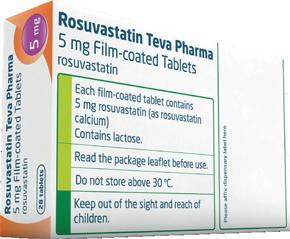
Simplified, clear and easy to read packs. Key information is displayed on the sides, allowing for the best use of limited shelf space 5 Products are differentiated through colour 1 2 User-friendly pack experience, with a linear read hierarchy Teva Pharmaceuticals Ireland, Digital Office Centre Swords, Suite 101 - 103, Balheary Demesne, Balheary Road, Swords, Co Dublin, K67E5AO, Ireland. Freephone: 1800 - 201 700 | Email: info@teva.ie Prescription Only Medicines | Further information is available on request or in the SmPC. Product Information also available on the HPRA website. Adverse events should be reported. Reporting forms and information can be found at www.hpra.ie. Adverse events should also be reported to Teva UK Limited on +44 (0) 207 540 7117 or medinfo@tevauk.com Date of Preparation: March 2024 | Job Code: GEN-IE-00059 3 Simplified back-of-pack clearly structures additional information No two packs have the same drug and strength colour 4 5mg 10mg 20mg 40mg
Management of Skin cancer and Melanoma
Skin cancer in Ireland: Skin cancer is the most common cancer in Ireland. More than 11,000 cases are diagnosed annually accounting for over one-third of all cancers diagnosed, yet most skin cancers could be prevented.

There are 2 main types of skin cancer: Non-melanoma skin cancer and melanoma skin cancer.
Non-melanoma skin cancer includes:
• Basal cell skin cancerthis is also called Basal Cell Carcinoma (BCC)
• Squamous cell skin cancerthis is also called Squamous Cell Carcinoma (SCC)
This is much more common but less aggressive than melanoma skin cancer. It slowly progresses over months or years.
Melanoma Skin Cancer
Melanoma is a less common but more aggressive type of skin cancer. The most common sign is the appearance of a new mole or change in an existing mole. It is more likely to spread to other parts of the body if not caught and treated early. Commonly affected areas are the trunk (chest and back) in men and the legs in women. It has a high 5-year survival rate of 93% if caught in time.
It is important for everyone to familiarize themselves with all the moles on their skin and not only look for changes in existing moles, but also any new spots that may appear.
What changes to look out for:
A – Asymmetry - if you draw a line down the centre of your mole, is it larger on one side?
B – Border - are the borders of your mole uneven, jagged or notched?
C
– Colour - has your mole changed colour over time or does it contain several different colours?
Written by Bernie Carter, Assistant Director of Nursing, Marie Keating Foundation
D – Diameter - is the circumference of your mole larger than the top of a rubber on a pencil (larger than 6mm – the size of a pencil rubber), although melanomas can sometimes be smaller than this.
E – Evolving - has your mole changed in height, appearance or are you experiencing any changes within or around your mole (eg. itching, bleeding, crusting)
It is important to know what is normal for you and what your normal skin looks like. If you are concerned about a change in your skin, or any of the above symptoms, see your GP.
What are the risk factors?
Ultraviolet (UV) radiation
Exposure to UV radiation is the main risk factor responsible for skin cancers. It is emitted naturally from the sun and from artificial sources such as sunbeds and sun lamps.
It’s important to remember that skin damage doesn’t just happen on holiday or in hot, sunny places. The sun is often strong enough to cause damage in Ireland, even on a cloudy day.
Sunbed usage
Research shows that the type of ultraviolet light used in sunbeds (UVA) can cause all types of skin cancer. The International Agency for Research into Cancer (IARC) has classified using sunbeds as a cause of melanoma. Just one session can increase your risk of developing cancer by 20%. The risk is highest for people who use a sunbed before age 35. Sunbed use by under-18s is banned in Ireland.
Skin Type
Fairer skinned people with lots of freckles and moles are more at risk. However, remember that if you have skin, you can get skin cancer.
Having lots of Moles
The more moles you have on your body, the higher your risk of
melanoma, meaning you should be very careful about exposing yourself to the sun and keep an eye on all your moles particularly new moles. The majority of melanomas occur on new moles.
Birthmarks
Most birthmarks, carry no risk of developing into a cancer. A very rare type, called a giant congenital melanocytic nevus, can develop into a melanoma if it is larger than 20cm. Check all birthmarks regularly for any signs of change.
Age
The risk of melanoma increases with age. However, compared to most other cancer types, melanoma is also quite common in younger people.
Family history
Your risk of melanoma is higher if you have a close relative who has had melanoma.
Genetic risk for Melanoma
Some families tend to have large numbers of moles, or moles that are unusual (atypical moles). The atypical moles tend to be an irregular shape or colour and may be larger than usual. An inherited condition called familial
atypical multiple mole melanoma syndrome (FAMMM) increases your risk of melanoma.
The SunSmart Code
Five steps we can take to help protect skin from the harmful effects of the sun while outdoors.
1. Seek Shade if outdoors from 11am to 3pm, when the sun is at its strongest. Always use a sunshade on a child’s buggy
2. Slip on some clothes made from close woven material that covers skin.
3. Slap on a wide brimmed hat to protect exposed skin such as face, neck, and ears from harmful rays
4. Slide on sunglasses with UV protection to shield your eyes from UV rays and protect yourself from cancer and chronic conditions such as cataracts.
5. Slop on sunscreen with an SPF of 30+ for adults and 50+ for children, with high UVA protection and water resistant. Apply regularly and thoroughly throughout the day.
Visit www.mariekeating.ie for more information and support.
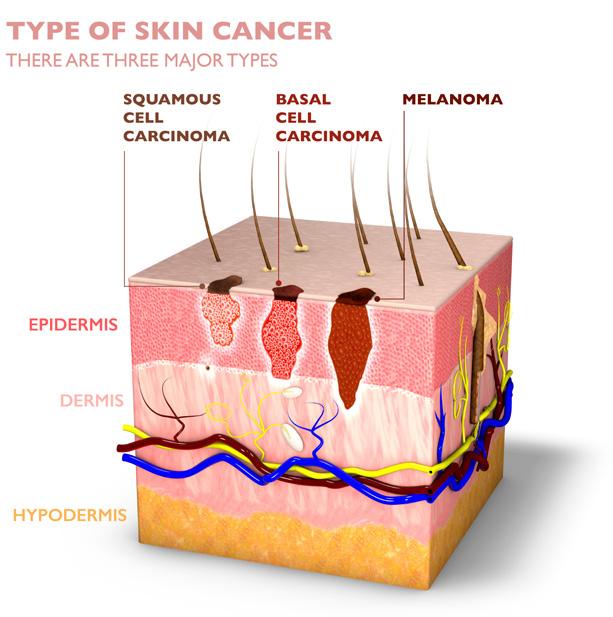
PHARMACYNEWSIRELAND.COM 88
Melanoma









Peel
Put
tongue. Let
water. The future of health & wellness is now available! 5
more information
contact your local BR Healthcare representative or our office on
Dissolvable
The new face in health & wellbeing
arrived! Peel the
Put
tongue. Let it dissolve.
water. The future of health & wellness is now available! 5
more information please contact your local BR Healthcare representative or our office on 01-8850800. Dissolvable wellness strips.
The new face in health & wellbeing has arrived!
the pouch.
on
it dissolve. No swallowing. No
For
please
01-8850800.
wellness strips.
has
pouch.
on
No swallowing. No
For
Heart & Stroke
How heart and stroke patients are becoming Champions with the Irish Heart Foundation
As healthcare professionals, the opportunity to see patients thrive after diagnosis is no doubt rewarding. But while medical therapies have advanced in the area of cardiovascular health, and are allowing patients diagnosed with life long, or life-limiting conditions, to live longer and sometimes with a better quality of life from a medical perspective, increasingly many heart and stroke patients have been reporting to the Irish Heart Foundation that there is a need for far more than just medical therapies, if they are to feel that they can really thrive in their lives post-diagnosis.

“Developing Patient Champions, is an attempt to redress this, to empower, upskill, support & harness the patient experience and their own skills, to achieve better recognition, better representation, better conditions, better advocacy power and more equality in decision making, policy formation, policy design, implementation, evaluation and outcomes so that CVD patients can be better served in our society”
Discussions with both heart patients and stroke survivors in the Irish Heart Foundation Patient Support Services, reflected that in addition to medical management of their condition, many patients, particularly of working age, who had professional skills, but were no longer able to use them in a career setting due to their diagnosis, felt redundant, hopeless and lost postdiagnosis. In addition, with many reporting mental health challenges
in coping with the isolation and loss of the life and lifestyle they knew as a result of their illness, and admitting to struggling with the reality of the implications of their diagnosis, there was an emerging need being witnessed by the organisation that a more holistic approach to patient health and wellbeing post diagnosis was required, if these patients were to thrive.
Since Covid 19, online patient service options in the Irish Heart Foundation grew, as did accessibility to these from all parts of Ireland. As a result, more patients have accessed, or have been referred into our services by members of the medical profession. Referrals are often necessary for patients who need support, largely due to the lack of patient support services in their geographical communities. The growth in patients into the service saw an expanse in the Irish Heart Foundation Patient Support Service offerings to include the addition of counselling, mindfulness, wellbeing, back to work training, exercise classes, and a host of other ancillary supports, as well as it’s highly used Nurse line.
Inevitably this increase in patient numbers would result in a greater awareness by the organisation in the scale of patient need at community level post
hospital discharge, and with this knowledge came an increasing need for patient advocacy.
One such patient advocacy issue that occurred around this time was in relation to its heart failure patient community, regarding NIACs decision to offer two different levels of vaccine prioritisation to this population in Ireland based on age, which left the under 70s age group living with heart failure in Ireland at a lower level of vaccine priority, and therefore at greater risk of contracting Covid 19, not only because of the extra time period they had to wait to receive the vaccine, but also because many of this age group were cosharing households with younger cohorts who had returned to schools and colleges and therefore exposed them to further risk.
The campaign was a team effort between the organisation and the patients, and included media interviews at national and local level, conducted jointly by both
PHARMACYNEWSIRELAND.COM 90
Irish Heart Foundation Patient Champion graduates with Pauline O’Shea, Advocacy Campaign Manager, Irish Heart Foundation

organisation representatives and patients, lots of letter writing to Dept of Health, HSE and NIAC, lots of research and of course, lobbying politicians at both national level by the organisation and by patient’s at local TD level in their individual constituencies, resulting in multiple references to the issue being made in the Dail. The experience led to a belief by the organisation that embracing patients into patient advocacy campaigns going forward would improve the efficacy of patient advocacy efforts.
It was decided that the organisation should embark on designing a specific advocacy programme for patients that would recruit, train and support them in the area of advocacy, communications and lobbying, as well as offer them ongoing inclusivity in the patient advocacy agenda of the organisation.
Therefore, in early 2023, the Irish Heart Foundation, launched its
as well as opportunities for patient representation in both the organisation and in healthcare areas who seek heart or stroke patient participation with regards to policy co-design, feedback, or evaluations in the area of cardiovascular health. In addition, ongoing peer and organisation support is offered, via frequent online meetings and campaign opportunities.
The programme is free, online and accessible from anywhere in the Ireland, so logistically a possibility for patients who may have challenges travelling due to the limitations of their diagnosis, something which patients reported had frequently been overlooked by way of their being able to get involved in social or work opportunities at community level post diagnosis.
From an organisation perspective, having the patient in the room, is proving to be a very useful tool in advocacy. Already our first graduates have gone on to advocate in many ways, not just for themselves but for other heart and stroke survivors e.g. at an Oireachtas Health Committee on cardiovascular funding, in media awareness interviews in relation to their conditions, and they have recently lobbied hard to their local TD’s about the post Budget ‘24 announcement that the national stroke strategy would not be funded, which has helped the charity’s national call for a reversal of this decision.
is an attempt to redress this, to empower, upskill, support & harness the patient experience and their own skills, to achieve better recognition, better representation, better conditions, better advocacy power and more equality in decision making, policy formation, policy design, implementation, evaluation and outcomes so that CVD patients can be better served in our society.
“Patient Champions is about helping develop a patient movement in cardiovascular healthcare in Ireland, that when combined with the Irish Heart Foundation can become a powerful force for good in the cardiovascular landscape.”
And what do the patients themselves who have gone through the programme say?
One Patient Champion graduate, Michael, a heart patient living in Cavan says… “I certainly would recommend that others join the programme and get involved. I believe the whole experience can benefit you personally, but you can also give a lot more to other people who do not have a voice.”
advocacy programme for patients, which it called Patient Champions. In line with the organisation’s mission statement, to defend, empower and care for those affected by heart disease and stroke, the programme was to offer upskilling, ongoing support, opportunities and training in the area of advocacy, as well as peer advocacy support amongst the patient recruits themselves. In this way, it would offer opportunities for heart and stroke patients to not only feel empowered in their own lives, to be able to use their own skills and learn new skills, but to hopefully find purpose again. It would also introduce patients from all over the country to likeminded patients, journeying on a similar path, thereby providing a social support component which could help reduce the level of isolation felt by many.
The programme includes training in the area of media, digital marketing and politics,
And the Irish Heart Foundation’s Patient Champions’ programme is being viewed with interest at a European level, with the European Heart Network seeking its inclusion on the agenda for its annual workshop this May ‘24 in Amsterdam, to discuss the possibility of its take up by other heart foundation members in Europe.
Perhaps it is also worth mentioning that the programme itself is spearheaded by a heart patient, who works in the Irish Heart Foundation’s Patient Advocacy team.
Pauline O’Shea, Advocacy Campaign Manager with the Irish Heart Foundation explains;
“I think patients in today’s world, feel like women did 100 years ago… invisible, unequal, lowly ranked, not at the table, more spoken about than to, overlooked, and often left feeling diminished.
“Developing Patient Champions,
Another Patient Champion graduate, Meaghan, a stroke survivor living in Kerry says, “It’s been really helpful for me to get that formal training, to just gain more confidence, so that I can take on those different opportunities. So, I absolutely would recommend joining.”
If you know, or work with heart of stroke patients whom you think would enjoy joining the Patient Champions programme, please ask them to contact Pauline O’Shea on 087 381 0726, or they can apply directly online by emailing ihfvolunteer@ irishheart.ie with subject heading ‘Patient Champions’.
For anyone who would like to know more on this programme, including to watch a video with some of the Irish Heart Foundation’s recent Patient Champion graduates, please visit https://irishheart.ie/patientchampions/
For all other Irish Heart Foundation Patient Support Service offerings for heart and stroke patients, please go to https://irishheart.ie/ support-for-you/heart-supportservices/ or call the Nurse Support Line on 01 668 5001
PHARMACYNEWSIRELAND.COM 91
Cardiac Rehabilitation: What Makes it Effective?
Cardiovascular disease (CVD) is the leading cause of morbidity, mortality and disability globally imposing a significant burden on individuals, families, and healthcare systems1. Each year in Ireland, over 4000 deaths are attributed to ischaemic heart disease.
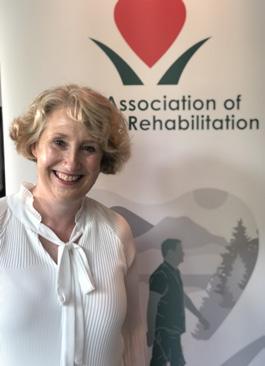
The growing population of those living with chronic CVD, heart failure and valvular heart disease are at a higher risk of secondary events, therefore it is essential that these patients receive effective, evidence-based secondary prevention, leading to optimization of cardiovascular health, improved functional capacity and enhanced quality of life.
For over 50 years cardiac rehabilitation (CR) is established as the proven cornerstone of optimal CVD management by reducing the risk of cardiovascular mortality and
Written by Deirdre O'Reilly, Cardiac Rehabilitation Coordinator Roscommon University Hospital, Saolta Healthcare Group & President Irish Association of Cardiac Rehabilitation
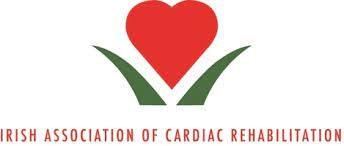
hospital readmissions, delivering improvements in patient outcomes and providing cost-effective care in these populations. 2,3,4,5
CR is a medically supervised, systematic, multidisciplinary programme offering internationally agreed core components across the continuum of care from the acute inpatient to longer term outpatient phase. 6
The key components which underpin the effectiveness of CR include supervised, guidelinedirected exercise training, patient education, behaviour
modification, psychosocial management and comprehensive risk factor management. 6,7
Fully comprehensive CR, recommended by clinical practice guidelines internationally, requires these core components to achieve reductions in mortality and morbidity.8
Timely access is also critical and prompt CR enrolment is associated with both improved participation and outcomes. For example, CR participation is reduced by 1% for every one-day delay in enrolment9 , whereas early

enrolment is linked with a 67% greater improvement in exercise capacity among patients enrolled in a programme within 15 days after hospital discharge compared to patients enrolled 30 or more days following discharge. 10,11
Individualized CR Programme:
A comprehensive evaluation and assessment of clinical status, CVD history, guideline- directed medication therapy, cardiovascular risk factors, dietary habits, body composition, exercise habits and capacity, psychological health and quality of life forms the basis of an individually tailored CR programme. Although risk of an adverse event is low 12 there is agreement across CR guidelines that all patients entering CR should be stratified according to risk for the occurrence of adverse events during exercise and for risk of progression of atherosclerotic disease. 6,7,13
Exercise Training:
Exercise training is central to CR due to the robust evidence base demonstrating its role in reducing mortality and morbidity.14,15,16,17,18,19,20,21 Cardiorespiratory endurance training is recommended as the foundation of most exercise prescriptions for adults with CVD as it represents the most effective way to increase cardiorespiratory fitness which reduces mortality risk. 22 The aim of the exercise prescription is to achieve a safe but therapeutic level of exercise training and progression of exercise intensity. Establishing safe and effective exercise programming is rooted in
PHARMACYNEWSIRELAND.COM 92 Cardiac Rehab
Thomas S, Colella T, Oh P. Effectiveness of an Education Intervention Among Cardiac Rehabilitation Patients in Canada: A Multi-Site Study. CJC Open. 2020 Mar 4;2(4):214221. doi: 10.1016/j.cjco.2020.02.008. PMID: 32695971; PMCID: PMC7365818.
44. Medina-Inojosa JR, Grace SL, Supervia M, Stokin G, Bonikowske AR, Thomas R, LopezJimenez F. Dose of Cardiac Rehabilitation to Reduce Mortality and Morbidity: A Population-Based Study. J Am Heart Assoc. 2021 Oct 19;10(20):e021356. doi: 10.1161/JAHA.120.021356. Epub 2021 Oct 6. PMID: 34612055; PMCID: PMC8751887.
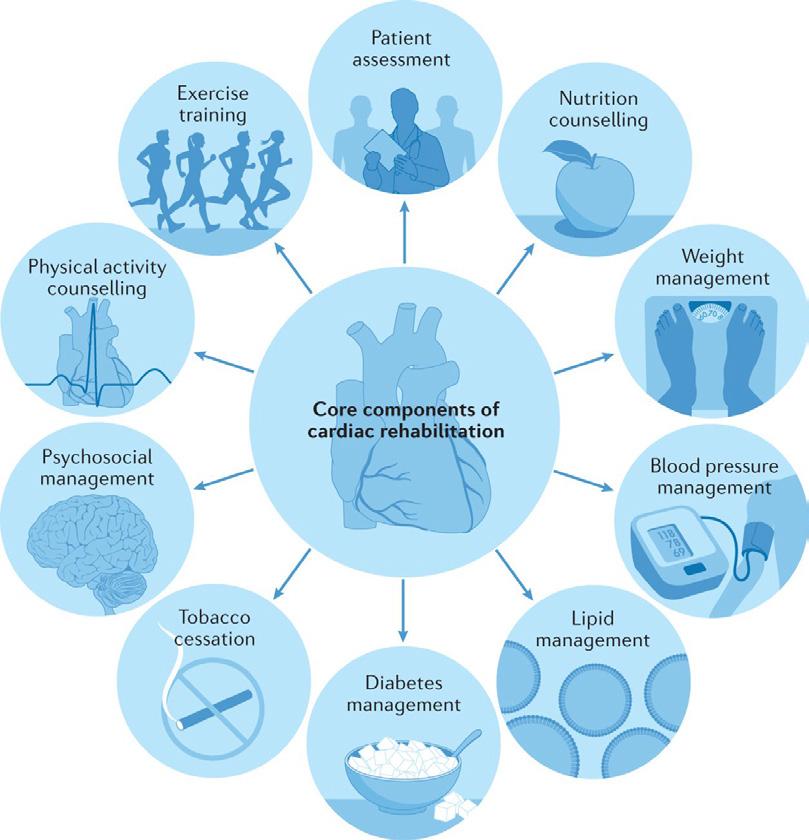
physiological responses to exercise not solely on subjective indicators.
International consensus recommends an initial exercise prescription based on a functional capacity test which is symptom limited to assess exercise capacity, heart rate, blood pressure, occurrence of arrhythmias, and ECG response. Cardiopulmonary exercise testing is recognised as the gold–standard using either a bicycle ergometer or a graded treadmill exercise test, and conducted on regular medications.23,24,6
Exercise prescription is based on FITT -VP principles: Frequency, Intensity, duration (Time), Type Volume and Progression.25
CR clinical guidelines widely recommend 2-4 supervised exercise sessions per week complemented by unsupervised
home sessions. 6,23,24,26,27 Intensity may vary between 40-80% of heart rate reserve (HRR) depending on the patient’s profile and their stage of progression through the programme. Perceived exertion should be in the moderate to moderate – to – high intensity range with higher-intensity interventions have been demonstrated to be safe and lead to superior outcomes. 28 Most CR guidelines specify up to 60mins per exercise session incorporating warm-up, cool down and resistance training. 6
Functional capacity (measured in Metabolic Equivalents - METs) achieved at CR completion is a stronger predictor of all-cause mortality than METs achieved at CR entry. 29 Progression of each patient’s exercise prescription is required to achieve the necessary cardiovascular adaptations leading to mortality benefit.22
Direct staff supervision should occur during exercise training until a safe exercise response has been demonstrated, with a variety of modalities employed to monitor patients including continuous ECG monitoring. After an initial period this monitoring may decrease appropriately if there is no evidence of abnormal ECG or haemodynamic findings, abnormal signs and symptoms or intolerance of exercise. 6, 7
Comprehensive CVD Risk Factor Management:
CR programmes incorporate secondary CVD prevention and comprehensive risk factor management based on the clinical assessment at programme onset. Evidence based interventions are implemented to optimise risk factor control in alignment with patient-centred goals. In line with the principle of Making
Every Contact Count 30, risk factor management encompasses the following aspects:
• Lifestyle modifications
• Smoking Cessation
• Nutritional Counselling
• Weight management
• Hypertension Management
• Lipid Management
• Diabetes Management
• Psychosocial Care
• Medication Management: (i.e. reconciliation of prescription, treatment optimisation and / adherence)
• Clinical Management: Patients with cardiac conditions have a broad spectrum of risk of developing arrhythmias that is not easily discernible, and CR represents an ideal opportunity to recognise and manage silent ischaemia 31 and arrhythmia
• Continuity of Care: bridging cardiovascular care ensuring continuity of appropriate secondary prevention management.
Psychosocial Management:
The psychological impact of heart disease is considerable, and psychological distress is highly prevalent in patients with CVD. Anxiety, depression and insomnia disorder affect approximately one-third of people with CVD, and up to one in four cardiac patients experience clinically significant levels of posttraumatic stress (PTSD)32,33,34,35. As a minimum, CR patients should be screened for clinically significant psychological distress as this is linked to increased future cardiac events and mortality, poorer quality of life, increased suicide risk, greater healthcare costs and poorer longterm psychological adjustment 32 However, many cardiac patients (e.g. survivors of sudden cardiac arrest, SCAD) also present with unique and complex psychological needs that are best delivered by an experienced clinician (e.g. devicerelated shock anxiety, PTSD) 36,37 Systematic reviews demonstrate that the psychological component drives the benefits achieved by CR, and that psychological interventions not only improve psychological distress and quality of life, but also reduce cardiac events and hospitalizations 4, 38,39,40 When fully integrated with CR, these interventions are also highly cost effective (e.g. group sessions) and deliver an incremental benefit
PHARMACYNEWSIRELAND.COM 93
GLM, Rouleau F, Ross MK, Dufour Doiron M, Belliveau SL, Brideau JR, Aultman C,

News
on hard endpoints 41A cardiac psychologist working as an integral part of the MDT will also provide expertise in weight management, psychosexual counselling, insomnia treatment, medication adherence, family support (e.g. caregiver burden in heart failure), maintaining lifestyle changes (e.g. exercise, smoking cessation) and enhanced communication with the cardiology team.
Patient Education and SelfManagement:
Education empowers patients to better understand their condition and associated treatment, and to learn effective self-management strategies. This enables them to make informed decisions and actively participate in their recovery process. The benefit of educational interventions delivered during CR is wellestablished 42,43 and shown to reduce mortality and morbidity 8 Effective educational interventions in CR ultimately foster selfefficacy and long-term adherence to healthy lifestyle behaviours.
CR Adherence and Exercise
‘Dose’:
The number of CR exercise sessions attended is inversely
related to major cardiovascular adverse events (MACE). This benefit appears to be linear, with greater risk reduction associated with higher doses, and no upper threshold. For example, , the risk of MACE is significantly lower both for patients completing a median of ≥12 sessions versus less, and those attending CR on average >2 sessions per week. Similarly, a continuous increase in attendance of 1 session is significantly associated with a 1-2% reduction in MACE risk with no ceiling to benefit. 44
In conclusion, for CR to be effective a multi-component and multi-disciplinary programme of care is required. While exercise training remains a central aspect of CR with strong evidence supporting its benefit, other components such as education and particularly psychosocial management are essential.8
The ongoing challenge is the implantation of this high-quality model in different settings, ensuring all eligible patients can access CR in a timely way.
References available on requust
Join Fleming Medical in supporting the Irish Heart Foundation’s National Blood Pressure Awareness Campaign
The Irish Heart Foundation, in partnership with Fleming Medical’s diagnostics brand Medicare LifeSense, is launching a pharmacy blood pressure awareness campaign, as part of their ‘Before Damage is Done’ national campaign.
May Measurement Month
The “Before Damage is Done” campaign aims to raise awareness of the link between high blood pressure and heart disease and stroke and encourages adults, particularly those over fifty, to get their blood pressure checked with their GP or in their local pharmacy. High blood pressure is known as the “silent killer” that is affecting billions of people worldwide. Statistics have shown that two out of three adults over the age of 50 have high blood pressure.
Unfortunately, high blood pressure rarely has noticeable symptoms and if left untreated, it can cause serious illnesses such as stroke, heart disease and even kidney failure. There is light at
the end of the tunnel according to the Irish Heart Foundation’s Medical Director, Dr Angie Brown, who has stated that “high blood pressure can be successfully managed, but only if people know they have it.”
With this in mind, and to coincide with May Measurement Month, Fleming Medical and the Irish Heart Foundation are teaming up with pharmacies across Ireland who will offer free blood pressure checks and advice in their consultation rooms throughout the month of May. This joint effort is designed to raise awareness among community members about the impact of high blood pressure on overall cardiovascular health.
“Fleming Medical is delighted to support the Irish Heart foundation to raise awareness about cardiovascular health within the pharmacy sector,” says Mark Fleming, Managing Director.
Donation
To support the Irish Heart Foundation, Fleming Medical will be donating 10% of all sales of Medicare LifeSense blood pressure monitors to the Irish Heart Foundation throughout May Measurement Month. In addition, participating pharmacies will also show their support with a donation of 5% of retail sales of Medicare LifeSense blood pressure monitors. These donations will go towards the
vital work of the Irish Heart Foundation.
Join the “Before Damage is Done” Campaign
Pharmacies that take part in the national “Before Damage is Done” campaign will play a pivotal role in raising awareness about the impacts of high blood pressure. All participating pharmacies will receive branded merchandise, in-store informational resources, and a blood pressure monitoring information session. If your pharmacy is interested in taking part in the “Before Damage is Done” campaign, please contact your Fleming Medical sales representative or contact our team on 1800 307777 for more information.
PHARMACYNEWSIRELAND.COM 94 Cardiac Rehab
Call for papers: make your contribution to Irish Pharmacy News
Articles
Research Papers
Reviews
Programme Descriptions
Reports
Case Reports
Letters to editor
In-depth review articles critique fundamental concepts, issues, and problems that define a field of research or practice and support advanced practitioners as well as aspiring early-year pharmacists.
Practice reports share innovations on any area of practice, including delivering clinical services, pharmacy administration, or new approaches to inform and engage with patients with the aim to improving pharmacy practice.
Perspective articles focus on a specific field or discipline and discuss current advances or future directions, and may include original data as well as expert insight and opinions.
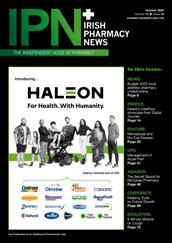

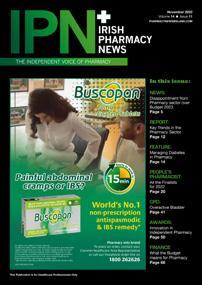



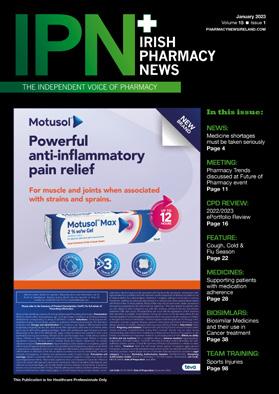

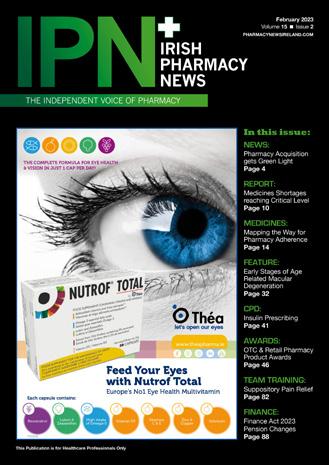
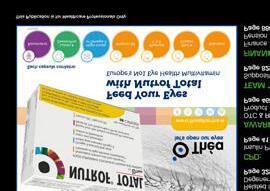
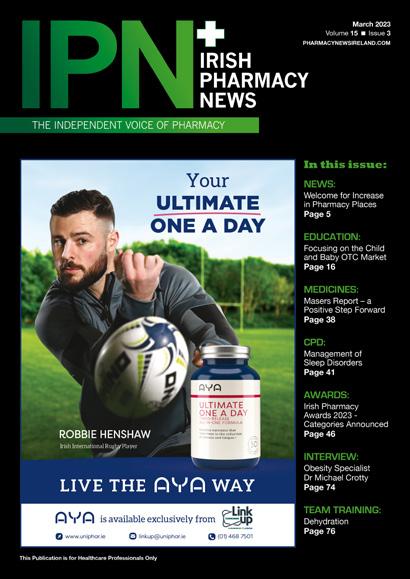

Contact: Kelly Jo Eastwood at: kelly-jo@ipn.ie or Aoife Hunter at: aoife@ipn.ie PHARMACYNEWSIRELAND.COM
Clinical Profiles
‘PATIENT COMMUNICATIONS
PASSPORT’ INITIATIVE
Portiuncula University Hospital (PUH) and Community Healthcare West (Galway, Mayo and Roscommon) are delighted to introduce the new ‘Getting to know what matters to me’ Communication Passport for people living with dementia.
The communications passport is a resource designed to reduce communication barriers and enhance the overall experience for people with dementia who utilise both hospital and community services. It can also be adapted to suit any individual who has difficulty communicating.
National and international research confirms that admission to an acute hospital can be distressing and disorientating for a person living with dementia and is often associated with a decline in their cognitive ability and levels of functioning.
The Dementia Quality Improvement Committee at Portiuncula University Hospital implemented the initiative in response to recommendations outlined in the Irish National Audit of Dementia Care in Acute Hospitals Report. The aim of the passport is to assist an individual who is receiving professional care and is unable to effectively disclose information about themselves, especially if they have special requirements or preferences.
The person, along with their family or carers, are asked to record information in the communications passport that
will help them communicate, such as their personal history, likes and dislikes, important people or places in their lives, and normal routines and abilities.
The passport is a valuable tool for patients transitioning from one care environment to another and meeting new people. It should travel with the person and be available for use when the person is experiencing any episode of care.
Speaking about the new Patient Communications Passport, Paula Noone, Assistant Director of Nursing, Dementia Quality Improvement, Saolta Group said, “The passport immediately indicates whether a patient has any communication difficulties.
“It will allow healthcare staff to see, at a glance, some of the critical information that they may have difficulty obtaining, as well as assist them understand how to effectively engage with the patient they are seeing.
“We want to make sure that all our patients are as comfortable as possible while in a healthcare setting and the passport is another tool to assist with that,” added Paula.
"Having a resource like this will help all staff to immediately identify the memories, the habits, routines, and symbols that are important to the person,” explains John Brennan, Dementia Coordinator for Community Healthcare West.
“The person will feel valued and included, especially when interacting with new people and going through inevitable care transitions.”
Passport clinical caption: from left, Angela Donnellan, Senior Staff Nurse, St Joseph’s Ward, PUH; Sharon Donoghue, Patient Advice Liaison Service Coordinator, PUH; Emily McElroy, Clinical Nurse Manager 2, St Joseph’s ward, PUH; Paula Noone, Assistant Director of Nursing, Dementia Quality Improvement, Saolta Group; John Brennan, Dementia Coordinator, Community Healthcare West; Paula Daly, Clinical Nurse Manager 1, St Joseph’s ward, PUH; Anita Blake, Senior Occupational Therapist, PUH; Siobhan Coen, Senior Occupational Therapist, PUH and Maura O Connell, Assistant Director of Nursing, Medical Division, PUH

James Keane, Hospital Manager said, “This new initiative aims to provide person-centered and compassionate integrated care, while also promoting the delivery of safer healthcare. Having greater supports in place like the passport, will greatly enhance the care we provide to patients who have difficulty communicating.
“Ensuring we have processes to assist in meeting the needs of our patients is a priority for the hospital.”
ASTELLAS’ VEOZA™ (FEZOLINETANT) NOW AVAILABLE IN IRELAND FOR THE TREATMENT OF MODERATE TO SEVERE VASOMOTOR SYMPTOMS (VMS) ASSOCIATED WITH MENOPAUSE
Astellas Pharma Co Ltd. Ireland recently announced that VeozaTM (fezolinetant) 45 mg film-coated tablets for the treatment of moderate to severe vasomotor symptoms (VMS) associated with menopause1 is now available in Ireland.
VMS, characterised by hot flushes (also called hot flashes) and/ or night sweats, is a common symptom of menopause. , Worldwide, more than half of women 40 to 64 years of age experience VMS with rates in Europe ranging from 56% to 97%.2,3 The prevalence of moderate to severe VMS in postmenopausal women in Europe has been reported at 40%.4 VMS can have a disruptive impact on women’s daily activities and overall quality of life.3
The approval is based on the results from the BRIGHT SKY™ program, which included three Phase 3 clinical trials that collectively enrolled over 3,000 individuals across Europe, the U.S., and Canada.4,5
Dr. Deirdre Lundy, Clinical Lead in the Complex Menopause Service, The National Maternity Hospital Dublin said: “I’m delighted to see the availability of Fezolinetant in Ireland. This advancement in women’s health provides a novel, non-hormonal option for menopausal women to control their moderate to severe VMS - symptoms which can be so debilitating and which have a huge impact on these women’s daily lives.”
Fezolinetant was first approved by the European Medicines Agency (EMA) in December 2023 for the treatment of moderate to severe vasomotor symptoms (VMS) associated with menopause.1
References
1. Williams RE, Kalilani L, DiBenedetti DB, et al. Frequency and severity of
vasomotor symptoms among peri- and postmenopausal women in the United States. Climacteric. 2008;11:32-43.
2. Nappi RE, Kroll R, Siddiqui E, et al. Global cross-sectional survey of women with vasomotor symptoms associated with menopause: prevalence and quality of life burden. Menopause. 2021;28:875-882.
3. Gold EB, Colvin A, Avis N, et al. Longitudinal analysis of the association between vasomotor symptoms and race/ethnicity across the menopausal transition: study of women's health across the nation. Am J Public Health. 2006;96:1226-1235.
4. Lederman S, Ottery F, Cano A et al. Fezolinetant for treatment of moderateto-severe vasomotor symptoms associated with menopause (SKYLIGHT 1): a phase 3 randomised controlled study. The Lancet. March 13, 2023. doi:10.1016/S0140-6736(23)00085-5.
5. Johnson K, Martin N, Nappi R et al. Efficacy and safety of fezolinetant in moderate-to-severe vasomotor symptoms associated with menopause: A Phase 3 RCT. The Journal of Clinical Endocrinology & Metabolism. 2023;00:1-17.
BLACKROCK HEALTH INVESTS ¤10 MILLION INTO ENHANCED RADIOTHERAPY CARE
Blackrock Health, combining Hermitage, Blackrock, Galway and Limerick Clinics, has invested ¤10 million in two new radiotherapy machines. The announcement marks a significant development in cancer care services across the two sites. The first machine is now fully operational in Galway Clinic and the second will be in operation in Hermitage Clinic later this year.
The Elekta Versa HD linear accelerators are designed to deliver highly precise radiation therapy to tumours, while sparing surrounding healthy tissue. The Elekta Versa HD uses advanced technologies like IGRT (image guided radiation therapy), IMRT (intensity modulated radiation therapy and VMAT (volumetric modulated radiation therapy) to improve accuracy and effectiveness of the treatments provided. The introduction of surface guided radiation therapy (VisionRT) in both hospitals will further improve the patient experience by eliminating the necessity for permanent marks on the patient’s skin. The versatility of the Elekta Versa HD will allow several treatment techniques, including conventional radiotherapy, stereotactic body radiotherapy (SBRT) and stereotactic radiosurgery (SRS) which will allow our teams flexibility to tailor treatment plans to offer the very best care for our patients.
Dr Joseph Martin, Consultant Radiation Oncologist in Blackrock Health Galway Clinic added: “At Blackrock Health, we are committed to delivering best-in-
PHARMACYNEWSIRELAND.COM 96
class care for our patients. With the incidence of cancer expected to more than double in men and to almost double in women by 2045[i], investment in oncology services to enable more precise and personalised treatment is crucial. We are delighted to have commenced offering treatment with the new machine in Galway, ensuring patients have access to the latest technology.”
The investment will enhance quality of care for patients, including a reduction in treatment time. The new machine has the capability to reduce treatment time from 20-25 minutes down to 6-7 minutes on average. This will significantly benefit patients who are required to wear facial mask coverings during treatment or are required to have a full bladder for treatment.
Brid Carroll, Radiotherapy Services Manager in Blackrock Health Hermitage Clinic added: “The new radiotherapy Linacs will enhance treatment options for oncology patients, offering reduced treatment times and increased precision in our treatments. The advanced technology allows us to deliver higher doses of radiation to tumours, while sparing surrounding normal tissue. This not only makes the treatment more effective, but also reduces side effects, therefore improving overall quality of life for our patients. The reduction in treatment time will also allow us to treat more patients, as well as improve the comfort for those receiving treatment. For our staff in the department, (radiation therapists, medical physicists and medics), this new technology will allow us to continue to develop the service for the benefit of our patients.”
SAOLTA UNIVERSITY CANCER NETWORK PROGRESSES TO NEXT STAGE OF EUROPEAN ACCREDITATION
Saolta University Cancer Network are delighted to have progressed to the next stage of accreditation with the Organisation of European Cancer Institutes (OECI).
The OECI Accreditation and Designation programme is considered internationally as the gold standard for cancer care. It focuses on enabling a complete quality system for cancer diagnosis, care, education and research.
OECI is an organisation of European cancer centres founded in 1979 to provide patients equal access to high quality cancer care through cooperation and knowledge exchange.
By participating in this prestigious accreditation process the Saolta University Cancer Network has

Dr Manvydas Varzgalis, Consultant Breast Surgeon, LUH; Tony Canavan, Regional Executive Officer, HSE West and North West; Professor Maccon Keane, Associate Clinical Director of the Network, GUH Saolta Cancer MCAN / Consultant Medical Oncologist; Geraldine Cooley, General Manager Saolta Cancer MCAN; Professor Michael Kerin, Director Saolta Cancer MCAN; Olive Gallagher, Director of Nursing, Saolta Cancer MCAN; Dr Joseph Martin, Associate Clinical Director of the Network, GUH Saolta Cancer MCAN / Consultant Radiation Oncologist; Dr Gerry O’Dowd, Associate Clinical Director of the Network, LUH Saolta Cancer MCAN / Consultant Histopathologist; and Dr Andrew Hodgson, Associate Clinical Director of the Network, SUH Saolta Cancer MCAN / Consultant Haematologist
committed to ongoing quality improvement in cancer care through research, innovation, partnership and patient empowerment.
The Saolta cancer programme provides a wide range of cancer services to a population of 830,000 people across the west and northwest. In line with the national model of care (a hub and spoke model), complex care is located at University Hospital Galway with satellite centres delivering care closer to home in Letterkenny University Hospital, Sligo University Hospital, Mayo University Hospital and Portiuncula University Hospital.
The network is a clinical academic partnership between the Saolta University Healthcare Group and the University of Galway and is aligned with the strategic priorities of the National Cancer Strategy (2017-2026).
In 2021, the Saolta University Cancer Network became a member of the OECI with a view to becoming an European accredited cancer network to quality assure the cancer programme within region. Following membership and preliminary designation screening by the OECI, the Saolta University Cancer Network undertook an extensive self-assessment process against the OECI standards with a completed submission delivered in February 2024.
This was approved by the OECI Accreditation and Designation (A&D) Board, and will result in a peer review visit scheduled for May 2024.
The peer review will include site visits by a European independent panel of experts who assess all elements the cancer
The official anniversary of the ban – the first of its kind in the world –falls on Good Friday.
Mr Martin said the landmark public health measure, which outlawed smoking inside every workplace, including pubs and restaurants, represented one of the “most memorable and significant moments” of his political career.
“At the time, there was huge opposition to the smoking ban and doubts over whether it would ever succeed, particularly in our hospitality industry. The decision sparked ferocious debate in what was the first real discussion on public health in Ireland.
“Shortly after its introduction, it came to be viewed as an important protective measure for the health of workers in every sector. It was clear that the general public wanted it.
programme in our hospitals. Any recommendations for quality improvement as a result of the review will be our focus over the next period, with a decision expected in November 2024 on our status as a fully accredited OECI Cancer Centre.
Professor Michael Kerin, Director of Saolta University Cancer Network welcomed the progress saying, “Our vision is to create a centre of excellence delivering the highest international standards in cancer treatment, research and education across our network and the OECI accreditation process will enable us to deliver patient centred cancer care at the highest standards internationally.”
Tony Canavan, Regional Executive Officer, HSE West and North West welcomed the progress adding: "The provision of integrated cancer care for the population of our region is a priority and I want to commend the team for the focus and determination they have shown in making this a reality for the people we serve."
IRELAND'S WORKPLACE SMOKING BAN SAVES MORE THAN 3,700 LIVES
Ireland's workplace smoking ban saved more than 3,700 lives in less than four years after its introduction, campaigners who gathered to mark its 20th anniversary insisted recently.
Tánaiste Micheál Martin, who pushed through the legislation as Health Minister in 2004, was joined at Government buildings by representatives of the Irish Heart Foundation, its ASH Council and other organisations involved in its initiation.
“Despite its success, we cannot allow ourselves to become complacent when it comes to the war on smoking. Tobacco, along with the new threat of vaping, is continuing to cause huge damage to people in this country.”
Chris Macey, Director of Advocacy and Patient Support with the Irish Heart Foundation, described the ban as “one of the most important pieces of legislation” ever introduced.
“It is estimated that it saved more than 3,700 lives in Ireland in the first three-and-a-half years after its implementation – almost 2.7 lives a day - and resulted in an immediate 26% reduction in ischaemic heart disease and a 32% drop in strokes.
“As countries across the world followed suit, the lifesaving impact of the law is beyond measure.”
Mr Macey warned, however, that two decades on, Ireland must pursue “bold and ambitious measures” on tobacco and vape control.
“Tobacco is still responsible for 4,500 deaths a year in Ireland, while an e-cigarette epidemic is responsible for driving nicotine addiction among young people.
“Smoking rates among teenagers are increasing for the first time in a generation, most likely due to the gateway effect from vaping.”
The Irish Heart Foundation believes the Government now needs to raise the legal age for the sale of tobacco and vaping products from 18 to 21.
Ireland, said Mr Macey, also needs to follow UK proposals which would make it illegal for anyone born after a certain year to buy tobacco products.
PHARMACYNEWSIRELAND.COM 97
98 Clinical Profiles
Lyprinol Joint Support
WELCOME FOR THE NATIONAL CHILDREN’S RESEARCH CENTRE (NCRC) INTO CHI
Children’s Health Ireland (CHI) has announced the welcoming of the National Children’s Research Centre (NCRC) into CHI. This very welcome milestone will enable us to further enhance our ability to bring care, education and research excellence to the bedside and foster optimal therapies for children in Ireland and beyond.
together to advance academic child health across our campuses.
The PAHSC is part of a wider network of academic child health across Ireland that is currently in development and promises to see Ireland as a key player in advancing child health internationally.
targeted support in three key areas: Energy, Tiredness, and Immunity.
Back in Stock
Available now in 60 Capsule Boxes!
LYPRINOL JOINT SUPPORT BACK IN STOCK
In today's fast-paced world, mothers juggle numerous responsibilities which can leave them feeling drained and lacking in vitality. Proceive® Every Mum is scientifically formulated to empower mothers to navigate their everyday lives with energy and vigour.
Key features of Proceive® Every Mum include:
Lyprinol Joint Support
Back in Stock
Available now in 60 Capsule Boxes!
The NCRC has been based on the CHI at Crumlin campus, working closely with CHI researchers and supported for many years by the Children’s Health Foundation, our fundraising partner. The Centre has worked to promote children’s health research and to improve child health outcomes across Ireland through investment in cutting-edge facilities, grant awarding and research leadership.
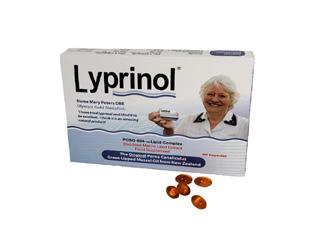
incorporated into Children’s Health
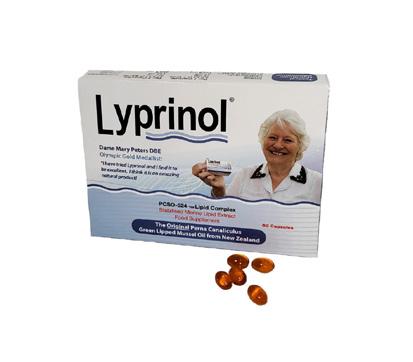
state-of-the-art research labs and
Energy Boost: nutrients, Proceive provides key nutrients such as Co-Q10 and B-Complex to combat fatigue and maintain optimal energy levels throughout the day.
Combat Tiredness: goodbye to feeling wornout! Proceive formulated to reduce tiredness and help mothers stay active and engaged in their daily routines.
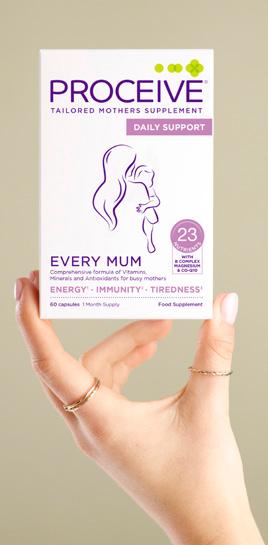
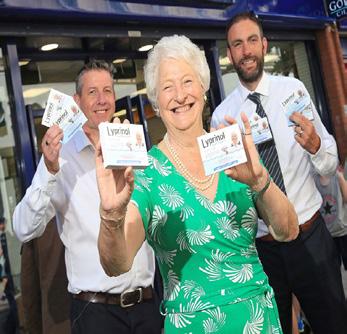
• Supporting Joints Naturally for almost 20 years
• No fishy taste or after taste
• No fishy taste or after taste

• Guaranteed Irish: Proceive® is a proud member of Guaranteed Irish
• Still the number one Marine oil packed full of Omega 3’s
• No known side effects, no allergic reactions
Supporting Immunity: Supporting a strong immune system is crucial, especially for mothers managing busy schedules. Proceive® Every Mum contains essential vitamins and minerals including Black Elderberry, Vitamin C and Zinc to support immunity and keep mothers feeling their best.
• Easy to swallow capsules
• Supporting Joints Naturally for almost 20 years
• Supporting Joints Naturally for almost 20 years
• No blood thinning
• Still the number one Marine oil packed full of Omega 3’s
• Easy to swallow capsules
the integration of basic science, clinical and translational research and grant expertise. This integrated research environment will ensure that the research we do across CHI continues to be high-quality, focused on patients and families and internationally competitive.
What sets Proceive® Every Mum apart?
• Safe to take long term for all the family
• Still the number one Marine oil packed full of Omega 3’s
• No known side effects, no allergic reactions
• No blood thinning
• No fishy taste or after taste
• No known side effects, no allergic reactions
• Safe to take long term for all the family
Paul McNally, Director of Research and Innovation, Children’s Health Ireland, said:
“Lyprinol is the most powerful marine oil available. It is far superior to conventional pharmaceuticals, vegetable based Omega 3 oils and fish oils” Dr Georges M. Halpern, M.D., PH.D
• Easy to swallow capsules
• No blood thinning
“Lyprinol is the most powerful marine oil available. It is far superior to conventional pharmaceuticals, vegetable based Omega 3 oils and fish oils” Dr Georges M. Halpern, M.D., PH.D
“Throughout the last 5 years, our teams in Children’s Health Ireland have worked hard to coordinate, integrate and modernise the previously separate research structures and supports across CHI sites. This next step in our development program incorporates cutting-edge translational, basic science and grant functions into CHI, and promises to transform our ability to deliver improved health outcomes for children.”
This co-ordinated CHI research infrastructure, alongside innovation and education, falls under the remit of the Paediatric Academic Health Science Centre (PAHSC) – the new structure that sees CHI and its 4 Dublin university partners, Dublin City University (DCU), RCSI University of Medicine and Health Sciences, Trinity College Dublin (TCD) and University College Dublin (UCD), formally partnering
• Safe to take long term for all the family
Available from all major wholesalers now……..
“Lyprinol is the most powerful marine oil available. It is far superior to conventional pharmaceuticals, vegetable based Omega 3 oils and fish oils” Dr Georges M. Halpern, M.D., PH.D
Available from all major wholesalers now…
INTRODUCING PROCEIVE® EVERY MUM: TARGETED SUPPORT FOR BUSY MOTHERS
Last month saw the launch of Proceive® Every Mum, the first product of its kind designed specifically to cater to the nutritional needs of busy mothers. With its unique formulation containing 23 essential vitamins, minerals and antioxidants, Proceive® Every Mum offers
• Tailored for Busy Mothers: Understanding the unique demands placed on mothers, Proceive® Every Mum is not a generic, low-dose multivitamin. Its formulation is carefully tailored to address the specific needs of mothers, with a focus on providing essential nutrients for energy, combating tiredness, and supporting immunity.
"As a working mother myself I understand first-hand the challenges that mothers face in balancing multiple responsibilities while maintaining my health and well-being," said Suzanne Acton, Marketing Manager at Proceive® "With Proceive® Every Mum, we aim to provide mothers with the targeted support they need to thrive, enabling them to tackle each day with renewed energy and vitality."
Available from all major wholesalers now……..
• High Strength, Daily Support: With a potent blend of 23 bioavailable nutrients, Proceive® Every Mum provides comprehensive daily support, ensuring mothers receive the essential vitamins and minerals they need for optimal health.
• Maximum Absorption and Efficacy: Proceive® Every Mum is scientifically formulated, utilising bioavailable nutrients, ensuring maximum absorption and efficacy, so mothers can experience the full benefits of the product.
• Certified Vegan: Proceive® Every Mum is proudly certified vegan, making it suitable for individuals following plantbased lifestyles.
Proceive® Every Mum is now available in Boots, Chemist Warehouse, McCabes and other independent pharmacies as well as Proceive.com offering a convenient solution for mothers seeking to enhance their overall well-being. RRP: ¤24.95. For more information, visit Proceive.com
SKINCARE BY SACHA INTRODUCES HYDRATION FACE CREAM WITH VITAMIN E
[07.03.2024] – Skincare by Sacha, a Northern Irish-based beauty brand renowned for its dedication to delivering effective and gentle skincare solutions, proudly announces the launch of its latest product: Hydration Face Cream with Vitamin E.
Founder Sibongile, also known as Swan, has meticulously formulated this hydrating face cream to cater to the diverse needs of all skin types. Enriched with Vitamin E, renowned for its antioxidant
PHARMACYNEWSIRELAND.COM

properties, this face cream offers a myriad of benefits for skin health and rejuvenation.
Vitamin E is celebrated for its ability to combat free radicals, thus shielding the skin from environmental damage. Moreover, its moisturising and antiinflammatory properties contribute to a supple and radiant complexion.
When selecting a hydrating face cream, it's essential to consider factors such as skin type and texture preference. Skincare by Sacha understands the importance of catering to individual needs and has dev eloped a formula that strikes the perfect balance between hydration and texture, suitable for all skin types.
Skincare by Sacha's commitment to efficacy and quality is evident in Sacha’s Hydration and Vitamin E product line. Each product is expertly formulated with high-quality ingredients to ensure tangible results without compromising on skin health. The brand's inclusive approach to beauty underscores its mission to inspire confidence in every individual.
Sacha's Moisturiser is a testament to this commitment, offering a potent daily renewal for the face. Its multifaceted formula addresses various skincare concerns, including lifting, firming, and revitalising the complexion. With Sacha's Day and Night Hydration Formula, beauty enthusiasts can embrace radiant and youthful skin at any moment.
Key Features of Sacha's Hydration Face Cream:
• Lifting and Firming Support
• Increased Tone, Suppleness, and Tightness
• Revitalises the Complexion
• Indulgent Firming Care
Skincare by Sacha's Hydration
Face Cream with Vitamin E is priced at ¤23.85 / £19.95 and is now available for purchase at www.skincarebysacha.com
Elevate your skincare routine with Sacha's Hydration Face Cream and let your beauty shine with confidence.
COMMEMORATING A QUARTER CENTURY OF PIONEERING SCIENCE: ASTRAZENECA'S 25YEAR MILESTONE
Dublin, Ireland (8th April 2024). Today heralds a significant milestone for AstraZeneca as it celebrates the 25th anniversary of the merger of Swedish Astra AB and UK-based Zeneca Group PLC in 1999. The merger catalysed the company’s growth into a global leader in pharmaceuticals and biotechnology.
AstraZeneca in Ireland celebrated this landmark occasion at its Blanchardstown headquarters with a panel discussion focusing on the company’s future growth and developments. Speakers included Alex Wilkes, Country President, AstraZeneca Ireland Marketing Company; Ruth March, Senior Vice President, Precision Medicine; Shane Doyle, Senior Vice President, Head of Operations & Sustainability for Alexion, AstraZeneca Rare Disease Unit and Jon-Paul Sherlock, API Commercialisation Site Lead.
Their forward-looking perspectives offered a glimpse into the exciting prospects that lie ahead for AstraZeneca and its ongoing commitment to its operations in Ireland.
Speaking at the event, Alex Wilkes said, “As we reflect on the past 25 years since the AstraZeneca merger, we celebrate innovation and excellence in science that resonates across the globe. I am immensely proud of the role our Irish operations play in our global success. The commitment, expertise, and innovative spirit of our team in Ireland are instrumental in driving our mission forward. Here's to celebrating our achievements, and the brighter horizons that lie ahead as we continue to forge the path of medical breakthroughs and transforming patient care for people society and planet."
In the last quarter of the century, AstraZeneca has effectively harnessed science to develop ground-breaking treatments in areas including oncology, immunology, renal and metabolic diseases, and respiratory and cardiac health. In Ireland

AstraZeneca Ireland
Ruth March, Senior Vice President, Precision Medicine; Shane Doyle, Senior Vice President, Head of Operations & Sustainability for Alexion, AstraZeneca Rare Disease Unit and Jon-Paul Sherlock, API Commercialisation Site Lead.
AstraZeneca and Alexion, AstraZeneca Rare Disease, employs over 1,200 people across two sites in Dublin and Athlone. AstraZeneca in Ireland provides medicines that treat more than 200,000 patients.
Globally AstraZeneca now employs over 83,000 people in 16 countries delivering therapies to patients in 130 countries worldwide.

PHARMACYNEWSIRELAND.COM 99
Alex Wilkes, Country President,
Marketing Company;
CHRISTMAS 2024
COSMETIC & GIFT TRADE FAIR

SUNDAY 12TH MAY
10am - 6pm
MONDAY 13TH MAY
9am - 8pm
TUESDAY 14TH MAY
9am - 6pm
The Main Hall,RDS, Ballsbridge, Dublin
ww w . c o smet i cass o c i at ion.i e
































































































 Dr Karl Kavanagh
Dr Karl Kavanagh














 Derek CeraPlus™ Product User
Hollister products are made globally, including Ballina, Ireland
Derek CeraPlus™ Product User
Hollister products are made globally, including Ballina, Ireland




























































 Written by Dr Cathal O’Connor, RCPI
Written by Dr Cathal O’Connor, RCPI










































































































































































































